Planet Technology 502AC 900Mbps 802.11ac Outdoor Wireless CPE User Manual EM WBS 502AC v1 0 20171128
Planet Technology Corporation 900Mbps 802.11ac Outdoor Wireless CPE EM WBS 502AC v1 0 20171128
Users Manual_rev.pdf
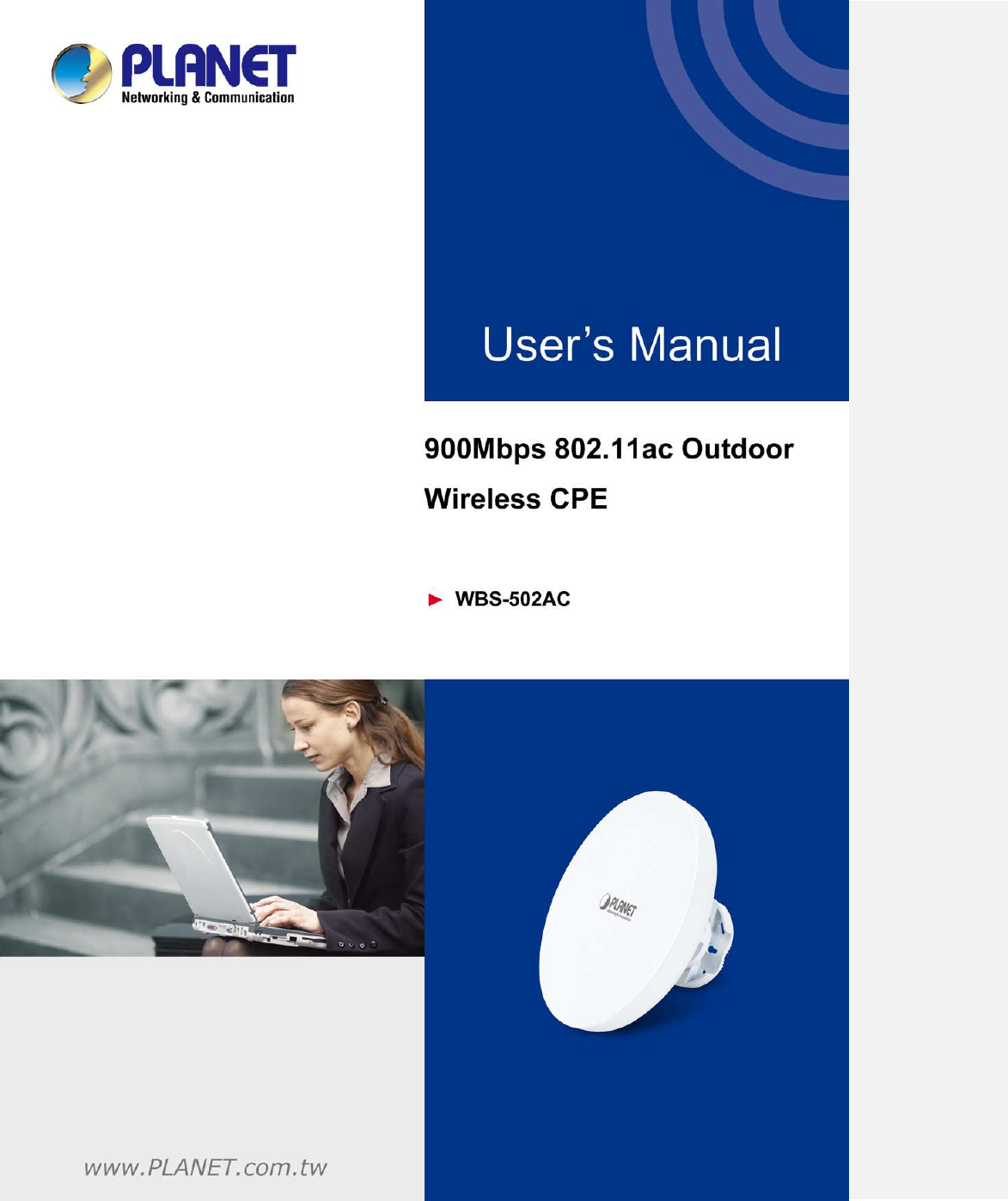
I

I
Copyright
Copyright 2017 by PLANET Technology Corp. All rights reserved. No part of this publication may be
reproduced, transmitted, transcribed, stored in a retrieval system, or translated into any language or
computer language, in any form or by any means, electronic, mechanical, magnetic, optical, chemical,
manual or otherwise, without the prior written permission of PLANET.
PLANET makes no representations or warranties, either expressed or implied, with respect to the
contents hereof and specifically disclaims any warranties, merchantability or fitness for any particular
purpose. Any software described in this manual is sold or licensed "as is". Should the programs
prove defective following their purchase, the buyer (and not this company, its distributor, or its dealer)
assumes the entire cost of all necessary servicing, repair, and any incidental or consequential
damages resulting from any defect in the software. Further, this company reserves the right to revise
this publication and to make changes from time to time in the contents hereof without obligation to
notify any person of such revision or changes.
All brand and product names mentioned in this manual are trademarks and/or registered trademarks of
their respective holders.
Federal Communication Commission (FCC) Interference Statement
This equipment has been tested and found to comply with the limits for a Class B digital device,
pursuant to Part 15 of FCC Rules. These limits are designed to provide reasonable
protection against harmful interference in a residential installation. This equipment
generates, uses, and can radiate radio frequency energy and, if not installed and used in accordance
with the instructions, may cause harmful interference to radio communications. However, there is no
guarantee that interference will not occur in a particular installation. If this equipment does cause
harmful interference to radio or television reception, which can be determined by turning the equipment
off and on, the user is encouraged to try to correct the interference by one or more of the following
measures:
- Reorient or relocate the receiving antenna.
- Increase the separation between the equipment and receiver.
- Connect the equipment into an outlet on a circuit different from that to which the receiver is
connected.
- Consult the dealer or an experienced radio/TV technician for help.
FCC Caution:
Any changes or modifications not expressly approved by the party responsible for compliance could
void the user’s authority to operate the equipment. To assure continued compliance, for example, use
only shielded interface cables when connecting to computer or peripheral devices.
This device complies with Part 15 of the FCC Rules. Operation is subject to the following two conditions:
(1) This device may not cause harmful interference
(2) This device must accept any interference received, including interference that may cause undesired
operation.

This transmitter must not be co-
located or operating in conjunction with any other antenna or transmitter.
FCC Radiation
Exposure Statement
This equipment complies with FCC radiation exposure limits set forth for an uncontrolled environment.
This equipment should be installed and operated with minimum distance
your body.
CE Compliance Statement
T
his device meets the RED 2014/53/EU
public to electromagnetic fields by way of health protection.
when it is used
at a safe distance of
Safety
This equipment is designed with the utmost care for the safety of those who install and use it. However,
special attention must be paid to the dangers of electric shock and static electricity when working with
electrical equipment. All the gu
idelines must
equipment.
WEEE regulation
To avoid the potential effects on the environment and human health as a result of the presence of
hazardous substances in electrical and electronic equipment,
electronic equipment should understand the meaning of the crossed
symbol. Do not dispose of WEEE as unsorted municipal waste
separately.
Revision
User’s Manual of PLANET 5GHz 9
00
Model: WBS-502AC
Rev: 1.0 (August, 2017)
Part No. EM-WBS-502AC_v1
.0 (2081
II
located or operating in conjunction with any other antenna or transmitter.
Exposure Statement
This equipment complies with FCC radiation exposure limits set forth for an uncontrolled environment.
This equipment should be installed and operated with minimum distance
26cm
between the radiator &
CE Compliance Statement
his device meets the RED 2014/53/EU
requirements on the limitation of exposure of the general
public to electromagnetic fields by way of health protection.
The device complies with RF specifications
at a safe distance of
20 cm from your body.
This equipment is designed with the utmost care for the safety of those who install and use it. However,
special attention must be paid to the dangers of electric shock and static electricity when working with
idelines must
be followed
at all times to ensure the safe use of the
To avoid the potential effects on the environment and human health as a result of the presence of
hazardous substances in electrical and electronic equipment,
end users of electrical and
electronic equipment should understand the meaning of the crossed
symbol. Do not dispose of WEEE as unsorted municipal waste
;
WEEE
00
Mbps 802.11ac Outdoor Wireless CPE
.0 (2081
-E10680-000)
located or operating in conjunction with any other antenna or transmitter.
This equipment complies with FCC radiation exposure limits set forth for an uncontrolled environment.
between the radiator &
requirements on the limitation of exposure of the general
The device complies with RF specifications
This equipment is designed with the utmost care for the safety of those who install and use it. However,
special attention must be paid to the dangers of electric shock and static electricity when working with
at all times to ensure the safe use of the
To avoid the potential effects on the environment and human health as a result of the presence of
end users of electrical and
electronic equipment should understand the meaning of the crossed
-out wheeled bin
WEEE
should be collected

III
CONTENTS
Chapter 1.Product Introduction ........................................................................................................... 7
1.1 Package Contents ............................................................................................................... 7
1.2 Product Description ............................................................................................................ 8
1.3 Product Features ................................................................................................................. 9
1.4 Hardware Description ....................................................................................................... 11
1.4.1 The Bottom Panel – Port ........................................................................................ 11
Chapter 2.Connecting to the AP ........................................................................................................ 14
2.1 Preparation before Installation ........................................................................................ 14
2.1.1 Safety Precautions .................................................................................................. 14
2.2 Installation Precautions .................................................................................................... 14
2.3 Installing the AP ................................................................................................................ 16
Chapter 3.Quick Installation Guide ................................................................................................... 18
3.1 Manual Network Setup -- TCP/IP Configuration ............................................................. 18
3.1.1 Configuring the IP Address Manually ..................................................................... 18
3.2 Starting Setup in the Web UI ............................................................................................ 21
Chapter 4.Configuring the AP ............................................................................................................ 23
4.1 Operation Mode ................................................................................................................. 23
4.2 Overview ............................................................................................................................ 25
4.2.1 Device Status .......................................................................................................... 25
4.2.2 Changes ................................................................................................................. 27
4.2.3 Wireless Client List ................................................................................................. 27
4.2.4 WDS Link List ......................................................................................................... 28
4.2.5 DHCP Client Table .................................................................................................. 29
4.2.6 Connection Status .................................................................................................. 29
4.3 Network .............................................................................................................................. 30
4.3.1 IP Settings............................................................................................................... 30
4.3.2 Spanning Tree Settings .......................................................................................... 32
4.4 Router (WISP Mode Only) ................................................................................................. 32
4.4.1 DHCP Server Settings ............................................................................................ 32
4.4.2 WAN Settings .......................................................................................................... 33
4.4.2.1.
DHCP ............................................................................................................................. 35
4.4.2.2.
Static IP.......................................................................................................................... 35
4.4.2.3.
PPPoE ........................................................................................................................... 36
4.4.2.4.
PPTP ............................................................................................................................. 38
4.4.3 VPN Passthrough ................................................................................................... 39
4.4.4 Port Forwarding ...................................................................................................... 39
4.4.5 DMZ Settings .......................................................................................................... 41

IV
4.4.6 Dos Protection ........................................................................................................ 41
4.5 Wireless .............................................................................................................................. 42
4.5.1 Wireless Settings .................................................................................................... 42
4.5.2 WDS Link Settings .................................................................................................. 46
4.5.3 Security Settings ..................................................................................................... 47
4.5.4 Wireless MAC Filter ................................................................................................ 56
4.5.5 Guest Network Settings .......................................................................................... 57
4.5.6 RSSI Threshold ...................................................................................................... 57
4.5.7 Management VLAN ................................................................................................ 58
4.6 Management ...................................................................................................................... 60
4.6.1 Account (Password Settings) ................................................................................. 60
4.6.2 SNMP Settings ....................................................................................................... 60
4.6.3 CLI/SSH/HTTPS Settings ....................................................................................... 62
4.6.4 Email Alert ............................................................................................................... 62
4.6.5 Backup/Restore Settings ........................................................................................ 63
4.6.6 WiFi Scheduler ....................................................................................................... 64
4.6.6.1.
Auto Reboot Settings ..................................................................................................... 64
4.6.6.2.
WiFi Scheduler ............................................................................................................... 65
4.6.7 Firmware Upgrade .................................................................................................. 66
4.6.8 Time Settings .......................................................................................................... 67
4.6.9 Log .......................................................................................................................... 69
4.6.10 Tools........................................................................................................................ 69
4.6.11 Logout ..................................................................................................................... 71
Appendix A: Troubleshooting ............................................................................................................ 72
Appendix B: Use Planet Smart Discovery to find AP ...................................................................... 74

V
FIGURES
F
IGURE
1-1
T
HREE
-
WAY
V
IEW
.............................................................................................................................. 11
F
IGURE
1-2
R
EAR
P
ANEL
...................................................................................................................................... 12
F
IGURE
2-1
P
O
E
AND
LAN
PORT CONNECTION
..................................................................................................... 16
F
IGURE
2-2
F
INISH INSTALLATION
........................................................................................................................ 16
F
IGURE
2-3
P
OLE
M
OUNTING
............................................................................................................................... 17
F
IGURE
2-4
W
ALL
M
OUNTING
.............................................................................................................................. 17
F
IGURE
3-1
TCP/IP
S
ETTING
................................................................................................................................ 19
F
IGURE
3-2
W
INDOWS
S
TART
M
ENU
.................................................................................................................... 20
F
IGURE
3-3
S
UCCESSFUL RESULT OF
P
ING COMMAND
.......................................................................................... 20
F
IGURE
3-4
F
AILED RESULT OF
P
ING COMMAND
................................................................................................... 21
F
IGURE
3-5
L
OGIN BY DEFAULT
IP
ADDRESS
......................................................................................................... 21
F
IGURE
3-6
L
OGIN
W
INDOW
................................................................................................................................ 21
F
IGURE
3-7
W
EB
UI
S
CREENSHOT
........................................................................................................................ 22
F
IGURE
4-1
W
IRELESS
–
B
ASIC
............................................................................................................................. 23
F
IGURE
4-2
S
YSTEM
M
ENU
-
R
ESET
..................................................................................................................... 25
F
IGURE
4-3
S
YSTEM
M
ENU
–
L
ANGUAGE OPTION
................................................................................................ 25
F
IGURE
4-4
M
AIN
S
TATUS
.................................................................................................................................... 26
F
IGURE
4-5
C
HANGES
........................................................................................................................................... 27
F
IGURE
4-6
W
IRELESS
C
LIENT
L
IST
..................................................................................................................... 28
F
IGURE
4-7
WDS
L
INK
S
TATUS
............................................................................................................................ 28
F
IGURE
4-8
DHCP
C
LIENT
L
IST
........................................................................................................................... 29
F
IGURE
4-9
C
ONNECTION
S
TATUS
........................................................................................................................ 30
F
IGURE
4-10
LAN
IP
S
ETTINGS
............................................................................................................................ 31
F
IGURE
4-11
S
PANNING
T
REE
S
ETTINGS
............................................................................................................... 32
F
IGURE
4-12
DHCP
S
ERVER
S
ETTINGS
................................................................................................................ 33
F
IGURE
4-13
WAN
S
ETTINGS
–
A
LL
..................................................................................................................... 34
F
IGURE
4-14
WAN
S
ETTINGS
–
DHCP ................................................................................................................. 35
F
IGURE
4-15
WAN
S
ETTINGS
–
S
TATIC
IP ............................................................................................................ 36
F
IGURE
4-16
WAN
S
ETTINGS
–
PPPOE ................................................................................................................ 37
F
IGURE
4-17
WAN
S
ETTINGS
–
PPTP .................................................................................................................. 38
F
IGURE
4-18
VPN
P
ASSTHROUGH
........................................................................................................................ 39
F
IGURE
4-19
P
ORT
F
ORWARDING
.......................................................................................................................... 39
F
IGURE
4-20
P
ORT
F
ORWARDING
.......................................................................................................................... 40
F
IGURE
4-21
DMZ ............................................................................................................................................... 41
F
IGURE
4-22
D
O
S
P
ROTECTION
............................................................................................................................ 42
F
IGURE
4-23
W
IRELESS
S
ETTINGS
–
AP
M
ODE
..................................................................................................... 43
F
IGURE
4-24
W
IRELESS
S
ETTINGS
–
WDS
AP
M
ODE
........................................................................................... 43
F
IGURE
4-25
W
IRELESS
P
ROFILE
–
AP/WDS
AP
M
ODE
....................................................................................... 44
F
IGURE
4-26
W
IRELESS
P
ROFILE
–
CB/WDS
STA/CR
M
ODE
.............................................................................. 45
F
IGURE
4-27
W
IRELESS
S
ETTINGS
–
CB/WDS
STA/CR
M
ODE
............................................................................ 46
F
IGURE
4-28
WDS
L
INK
S
ETTINGS
–
WDS
AP
M
ODE
.......................................................................................... 46
F
IGURE
4-29
WDS
L
INK
S
ETTINGS
–
WDS
B
RIDGE
M
ODE
.................................................................................. 47

VI
F
IGURE
4-30
S
ECURITY
S
ETTINGS
–
AP/WDS
AP
M
ODE
..................................................................................... 48
F
IGURE
4-31
S
ECURITY
S
ETTINGS
–
CB/WDS
STA/CR
M
ODE
............................................................................ 48
F
IGURE
4-32
S
ECURITY
S
ETTINGS
–
WDS
B
RIDGE
M
ODE
.................................................................................... 49
F
IGURE
4-33
S
ECURITY
S
ETTINGS
–
WEP ............................................................................................................ 50
F
IGURE
4-34
S
ECURITY
S
ETTINGS
–
WPA-PSK .................................................................................................... 50
F
IGURE
4-35
S
ECURITY
S
ETTINGS
–
WPA2-PSK .................................................................................................. 51
F
IGURE
4-36
S
ECURITY
S
ETTINGS
–
WPA-PSK
M
IXED
........................................................................................ 52
F
IGURE
4-37
S
ECURITY
S
ETTINGS
–
WPA
(WPA
E
NTERPRISE
) ............................................................................. 52
F
IGURE
4-38
S
ECURITY
S
ETTINGS
–
WPA2
(WPA2
E
NTERPRISE
) ........................................................................ 53
F
IGURE
4-39
S
ECURITY
S
ETTINGS
–
WPA
M
IXED
(WPA
M
IXED
E
NTERPRISE
) ..................................................... 55
F
IGURE
4-40
W
IRELESS
MAC
F
ILTER
................................................................................................................... 56
F
IGURE
4-41
W
IRELESS
-
G
UEST
N
ETWORK
S
ETTINGS
......................................................................................... 57
F
IGURE
4-42
W
IRELESS
-
RSSI
T
HRESHOLD
......................................................................................................... 58
F
IGURE
4-43
W
IRELESS
–
M
ANAGEMENT
VLAN ................................................................................................. 58
F
IGURE
4-44
A
DMINISTRATION
(P
ASSWORD
S
ETTINGS
) ........................................................................................ 60
F
IGURE
4-45
SNMP
S
ETTINGS
............................................................................................................................. 61
F
IGURE
4-46
CLI/SSH/HTTPS
S
ETTINGS
............................................................................................................ 62
F
IGURE
4-47
E
MAIL
A
LERT
S
ETTINGS
.................................................................................................................. 63
F
IGURE
4-48
B
ACKUP
/R
ESTORE
S
ETTINGS
........................................................................................................... 64
F
IGURE
4-49
A
UTO
R
EBOOT
S
ETTINGS
................................................................................................................. 65
F
IGURE
4-50
W
I
F
I SCHEDULER
............................................................................................................................. 65
F
IGURE
4-51
F
IRMWARE
U
PGRADE
....................................................................................................................... 66
F
IGURE
4-52
T
IME
S
ETTINGS
................................................................................................................................ 68
F
IGURE
4-53
S
YSTEM
L
OG
................................................................................................................................... 69
F
IGURE
4-54
T
OOLS
-
P
ING
................................................................................................................................... 70
F
IGURE
4-55
T
OOLS
-
T
RACEROUTE
..................................................................................................................... 70
F
IGURE
4-56
T
OOLS
–
S
PEED
T
EST
....................................................................................................................... 71
F
IGURE
4-57
L
OGOUT
........................................................................................................................................... 71
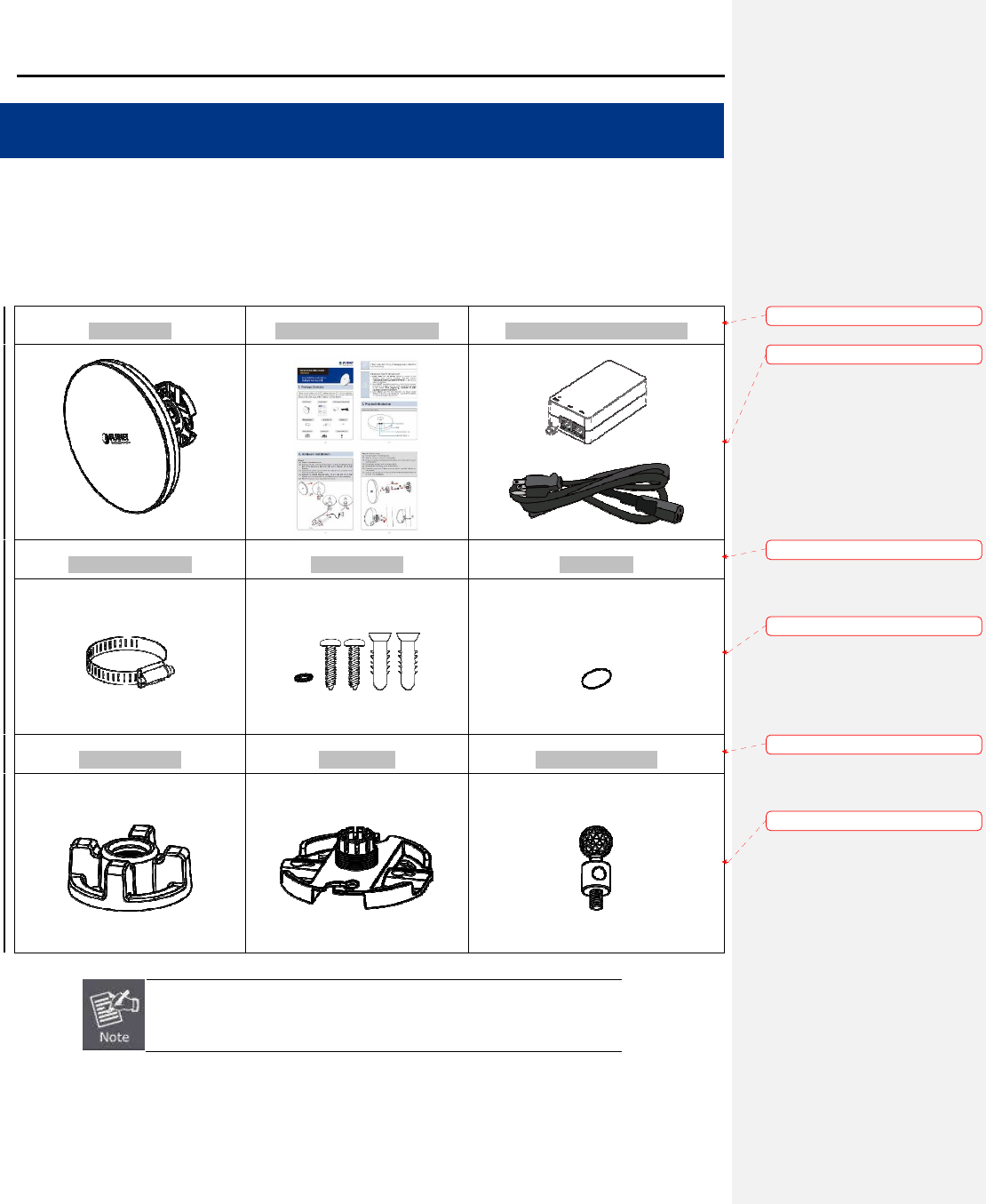
1.1 Package Contents
Thank you for choosing PLANET
WBS
inside the package box.
WBS-502AC
Mounting Ring x 1
Sealing Nut x 1
If there is any item
immediately.
User
Manual of
-7-
Chapter 1.
Product I
WBS
-502AC series. Before installing the CPE
, please
Quick Installation Guide
PoE Injector & Power Cord
Screw Set x 1
Bracket x 1
Dynamic Stick x
If there is any item
missing
or damaged, please contact the seller
Manual of
WBS-502AC
Product I
ntroduction
, please
verify the contents
PoE Injector & Power Cord
Rubber x 1
Dynamic Stick x
1
or damaged, please contact the seller
格式化: 間距 套
用前:
格式化: 間距 套
用前:
格式化: 間距 套
用前:
格式化: 間距 套
用前:
格式化: 間距 套
用前:
格式化: 間距 套
用前:
用前:
0.5 行
用前:
0.5 行
用前:
0.5 行
用前:
0.5 行
用前:
0.5 行
用前:
0.5 行

User Manual of WBS-502AC
-8-
1.2 Product Description
Ultra-high-speed Enterprise Outdoor Wireless Solution
PLANET WBS-502AC 5GHz 900Mbps 802.11ac Outdoor Wireless CPE supports IEEE 802.11ac standard with
2T2R MIMO mechanism, which brings the latest wireless technology into outdoor infrastructure. The
WBS-502AC supports standard IEEE 802.3at Power over Ethernet (PoE) and features IEEE 802.3af PoE
pass-through going to the secondary LAN port, which is able to supply power to the PoE IP camera or other
PoE PD equipment. With excellent performance and concentrated antenna beamwidth, the WBS-502AC is
definitely ideal for long-distance outdoor surveillance.
Bringing Superior 11ac Performance to Outdoor
To provide extremely high-speed user experience, the WBS-502AC adopts IEEE 802.11ac technology to extend
the 802.11n 40MHz channel binding to 80MHz and the implementation of 256-QAM modulation where higher
transmitting/receiving rates go up to 867Mbps in 5GHz frequency band with less interference. Equipped with
Gigabit LAN ports, the WBS-502AC allows 11ac wireless traffic to directly access high-speed connection
without the bottleneck of 100Mbps uplink wired connection, thus offering a better range and superior throughput
than those of the 802.11a/n wireless outdoor CPE.
Multiple SSIDs with VLAN Tagging
Multiple SSIDs can broadcast up to 8 wireless networks with different names. For management purposes, the
IEEE 802.1Q VLAN supported allows multiple VLAN tags to be mapped to multiple SSIDs to distinguish the
wireless access or allows VLAN tags to pass through over WDS link. This makes it possible for the WBS-502AC
to work with managed Ethernet switches to have VLAN assigned for a different access level and authority.
Value-added Outdoor Characteristics
The WBS-502AC is definitely suitable for wireless IP surveillance, and bridge link of building to building and
backbone of public service. With standard IEEE 802.3at Power over Ethernet (PoE) design, the WBS-502AC
can be powered by the remote PoE switch through the 100m Cat5e UTP cable and is able to supply power to the
IP camera supporting IEEE 802.3af standard through the secondary LAN port. With the IP55-rated outdoor
UV-resistant enclosure, the WBS-502AC can perform normally under rigorous weather conditions, meaning it
can be installed in any harsh, outdoor environments.

User Manual of WBS-502AC
-9-
Completely Secure Wireless Network
The WBS-502AC supports 152-bit WEP, WPA/WPA2, WPA-PSK and WPA2-PSK wireless encryptions, the
advanced WPA2-AES mechanism and 802.1X RADIUS authentication, which can effectively prevent
eavesdropping by unauthorized users or bandwidth occupied by unauthenticated wireless access. Furthermore,
any users are granted or denied access to the wireless LAN network based on the ACL (Access Control List)
that the administrator pre-established. To provide the secure Wi-Fi access for visitors, Guest Network feature
allows you to create a temporary network with an individual SSID, security setting and DHCP settings to isolate
the guest network to a separate network segment, thus preventing guests from being able to access files on
intranet and also ensuring the guest's internet connectivity.
Deployment and Alignment within Minutes
In order to provide accurate antenna alignment, the WBS-502AC is equipped with a 360-degree 3D array of
mounting brackets, greatly reducing deployment effort to easily achieve high-performance backhaul links over
long distance through the built-in higher gain antenna.
Smart Management Features Meeting High Expectations
With user-friendly Web UI and comprehensive management features like RSSI threshold, Client Limit Control
and Wireless Traffic Shaping, the WBS-502AC is easy to limit the client access and control the bandwidth,
even for users who have no experience in setting up a wireless network. Furthermore, with the Planet Smart
Discovery Utility, SNMP and diagnostics tools, the WBS-502AC is convenient to be managed remotely.
1.3 Product Features
Industrial Compliant Wireless LAN and LAN
Compliant with the IEEE 802.11a/n/ac wireless technology
2T2R architecture with data rate of up to 900Mbps
Equipped with two 10/100/1000Mbps RJ45 ports with auto MDI/MDI-X supported
IPv4 and IPv6 dual-stack management networks
Fixed Network Broadband Router
Supported WAN connection types in WISP mode: DHCP, Static IP, PPPoE, PPTP
Supports Port Forwarding and DMZ for various networking applications
Supports DHCP server in WISP mode
Supports Guest Network in AP mode
RF Interface Characteristics
Built-in dual-polarization antenna
High output power for outdoor usage

User Manual of WBS-502AC
-10-
Outdoor Environmental Characteristics
IP55 rating
IEEE 802.3at PoE design, IEEE 802.3af PoE pass-through going to the secondary LAN port
Operating temperature: -20~70°C
Multiple Operation Modes and Wireless Features
Multiple operation modes: AP, WDS, WISP
WMM (Wi-Fi multimedia) provides higher priority to multimedia transmitting over wireless
Wireless Traffic Shaping to control the upload/download bandwidth
Wi-Fi scheduler allows to enable or disable based on predefined schedule
Secure Network Connection
Full encryption supported: 64-/128-/152-bit WEP, WPA/WPA2, WPA-PSK/WPA2-PSK and 802.1X
RADIUS authentication
Supports 802.1Q VLAN pass-through over WDS and SSID-to-VLAN mapping
Supports up to 32 entries of MAC address filtering
Easy Deployment and Management
360-degree 3D array of mounting brackets design
Multilingual Web User Interface: English, Spanish, French, German, Portuguese, Russian,
Simplified Chinese
CLI command and SNMP-based management interface
Supports SSH/HTTPS secure connection
Self-healing mechanism through system auto reboot setting
System status monitoring through remote Syslog Server and Device Discovery
Diagnostic tools includes Ping, Traceroute, Speed
Planet Smart Discovery Utility allows administrator to discover and locate each AP
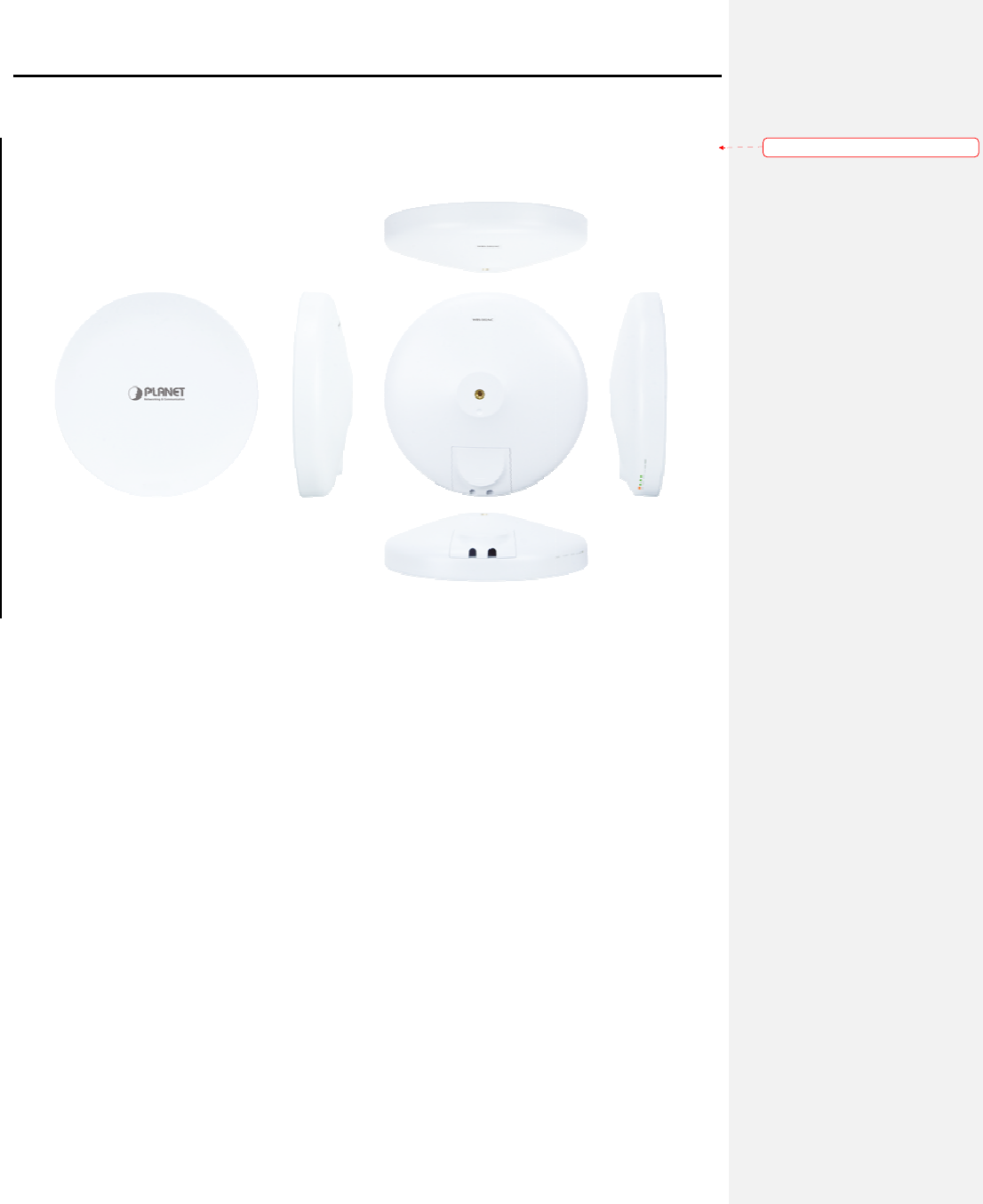
1.4
Hardware Description
Dimensions (Φ x H):
190 x 38mm
1.4.1 The Bottom Panel –
Port
The Bottom panel provides
the physical connectors connected to the power adapter and any other network
device. Figure 1-2 shows the bottom
User
Manual of
-11-
Hardware Description
190 x 38mm
Figure 1-1 Three-way View
Port
the physical connectors connected to the power adapter and any other network
panel of the WBS-502AC.
Manual of
WBS-502AC
the physical connectors connected to the power adapter and any other network
格式化: 間距 套
用後:
用後:
0.5 行
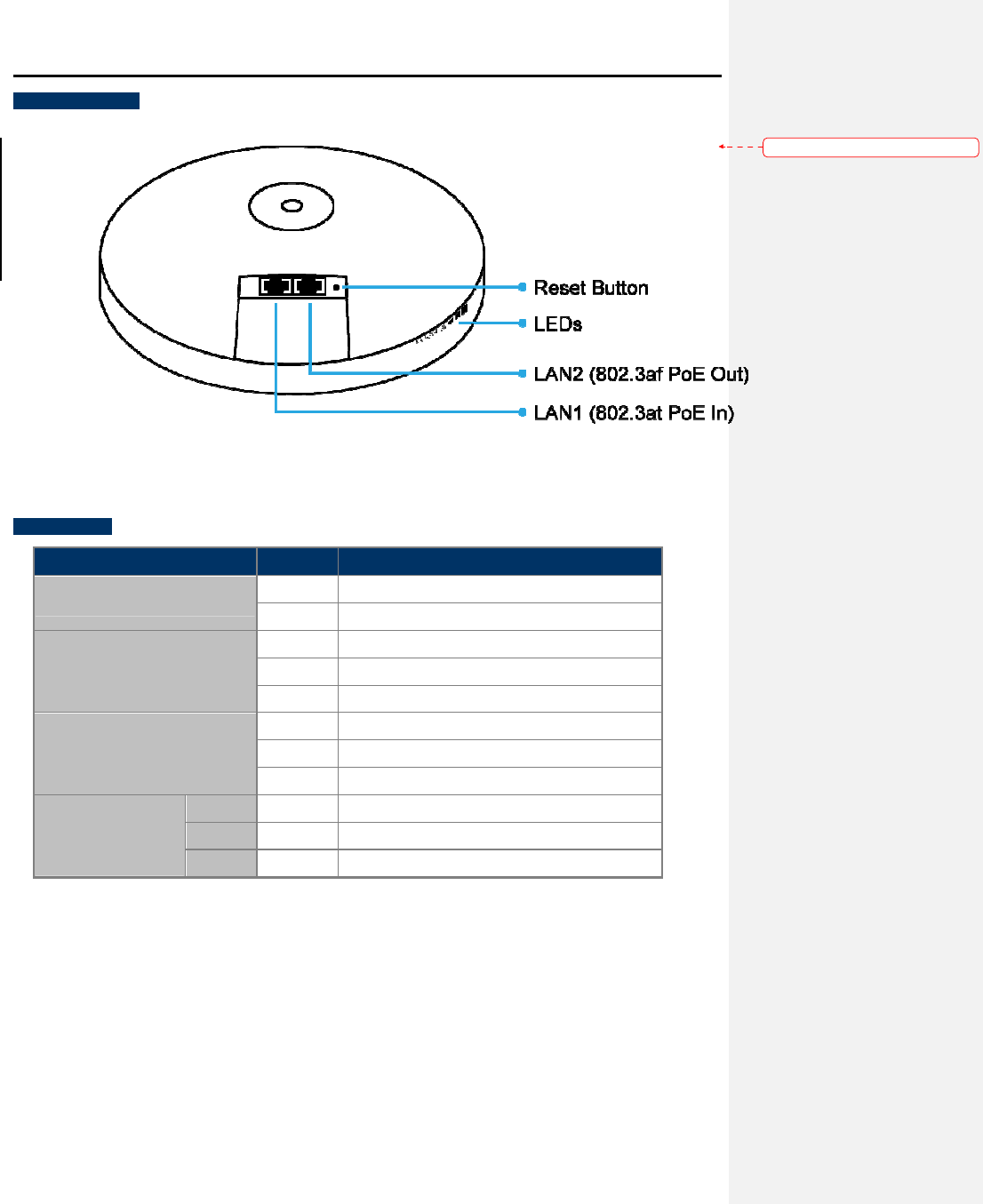
Bottom/Side Panel
LED Definition
LED
Power
LAN Ports
WLAN
Signal Strength
(CB/WDS
STA/CR only)
Good
Normal
Poor
User
Manual of
-12-
Figure 1-2 Rear Panel
State Meaning
On The device is powered on
Off The device is powered off
On Port linked
Blinking Data is transmitting or receiving
data
Off No link
On The wireless radio is on
Blinking Data is transmitting or receiving
over wireless
Off The wireless radio is off
On Signal is good
Normal
On Signal is normal
On Signal is poor
Table 2-1 The LED indication
Manual of
WBS-502AC
data
over wireless
格式化: 間距 套
用後:
用後:
0.5 行
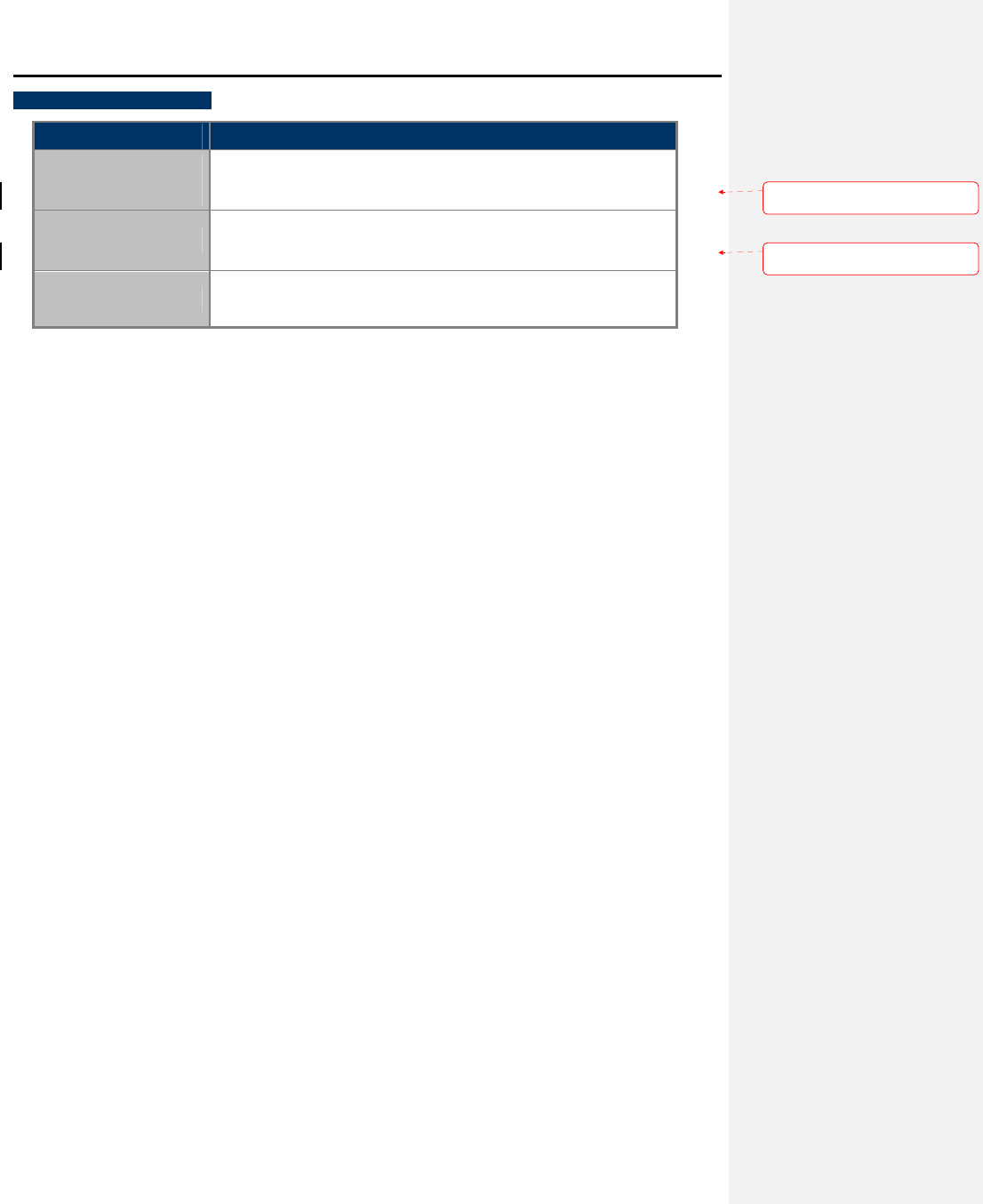
User Manual of WBS-502AC
-13-
Hardware Interface Definition
Object Description
PoE LAN Port
10/100/1000Mbps RJ45 port, auto MDI/MDI-X
IEEE 802.3at PoE PD supported, 54VDC In
LAN2 Port 10/100/1000Mbps RJ45 port, auto MDI/MDI-X,
IEEE 802.3af PoE PSE
Reset Button Press and hold the Reset button on the device for over 10 seconds to
return to the factory default setting.
Table 2-2 Hardware Interface Definition
格式化: 間距 套用前: 0.2 行, 套
用後: 0.2 行
格式化: 間距 套用前: 0.2 行, 套
用後: 0.2 行

User Manual of WBS-502AC
-14-
Chapter 2. Connecting to the AP
2.1 Preparation before Installation
2.1.1 Safety Precautions
1. To keep you safe and install the hardware properly, please read and follow these safety precautions.
2. If you are installing the WBS-502AC for the first time, for your safety as well as others’, please seek
assistance from an installer who has received safety training on the hazards involved.
3. Keep safety as well as performance in mind when selecting your installation site, especially where there
are electric power and phone lines.
4. When installing the WBS-502AC, please note the following things:
♦
Do not use a metal ladder;
♦
Do not work on a wet or windy day;
♦
Wear shoes with rubber soles and heels, rubber gloves, and a long-sleeved shirt or jacket.
5. When the system is operational, avoid standing directly in front of it. Strong RF fields are present when the
transmitter is on.
2.2 Installation Precautions
Users MUST use a proper and well-installed surge arrestor and grounding kit with the WBS-502AC;
otherwise, a random lightning could easily cause fatal damage to the WBS-502AC. EMD (Lightning)
DAMAGE IS NOT COVERED UNDER WARRANTY.
Users MUST use the “Power cord and PoE Injector” shipped in the box with the WBS-502AC. Use of
other options will cause damage to the WBS-502AC.
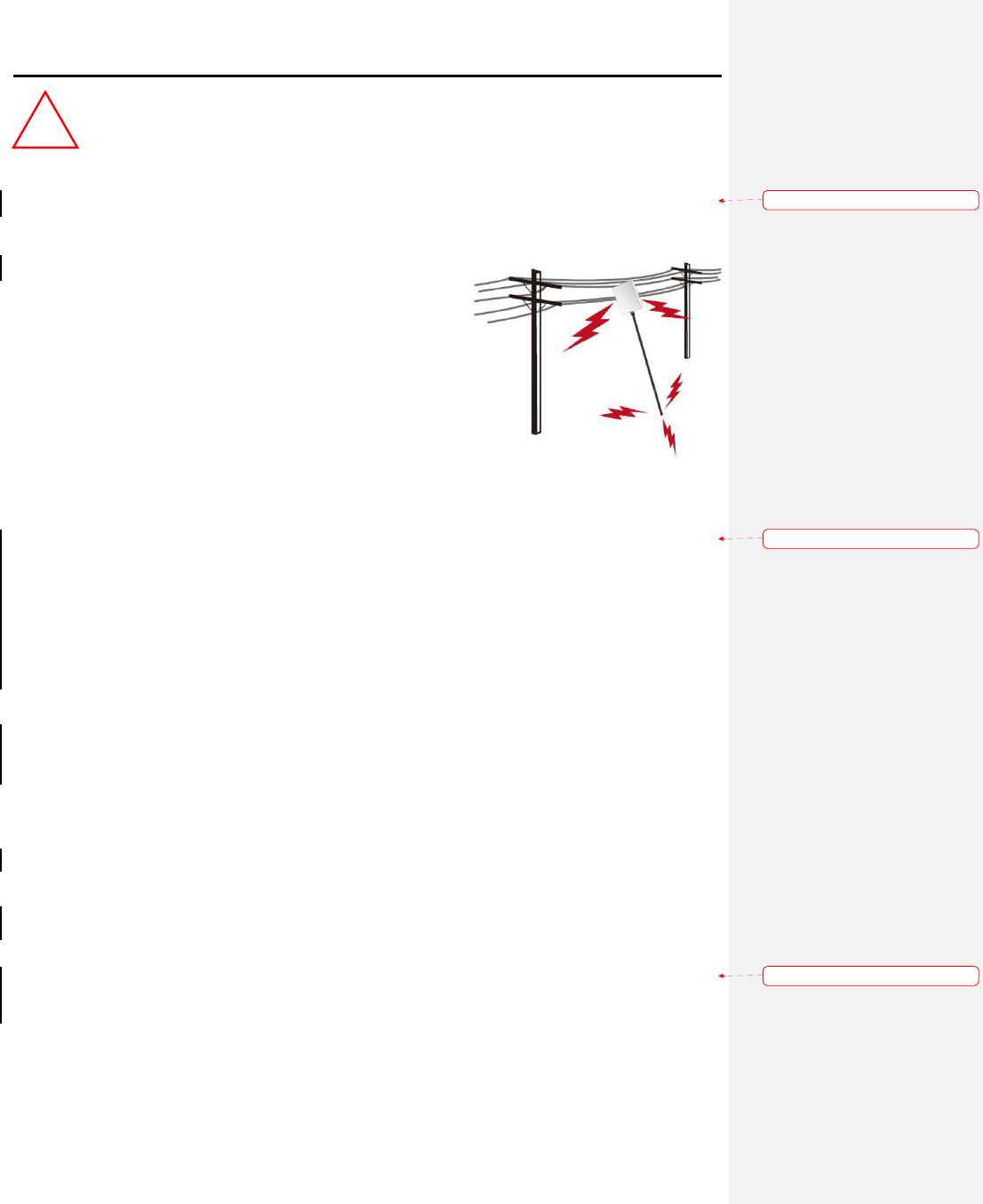
User Manual of WBS-502AC
-15-
OUTDOOR INSTALLATION WARNING
IMPORTANT SAFETY PRECAUTIONS:
LIVES MAY BE AT RISK! Carefully observe these instructions and any special instructions that are included with the
equipment you are installing.
CONTACTING POWER LINES CAN BE LETHAL. Make sure no power lines
are anywhere where possible contact can be made. Antennas, masts, towers,
guy wires or cables may lean or fall and contact these lines. People may be
injured or killed if they are touching or holding any part of equipment when it
contacts electric lines. Make sure that equipment or personnel do not come in
contact directly or indirectly with power lines.
The horizontal distance from a tower, mast or antenna to the nearest power
line should be at least twice the total length of the mast/antenna combination.
This will ensure that the mast will not contact power if it falls either during installation or later.
TO AVOID FALLING, USE SAFE PROCEDURES WHEN WORKING AT HEIGHTS ABOVE GROUND.
Select equipment locations that will allow safe, simple equipment installation.
Don’t work alone. A friend or co-worker can save your life if an accident happens.
Use approved non-conducting lasers and other safety equipment. Make sure all equipment is in good repair.
If a tower or mast begins falling, don’t attempt to catch it. Stand back and let it fall.
If anything such as a wire or mast does come in contact with a power line, DON’T TOUCH IT OR ATTEMPT TO
MOVE IT. Instead, save your life by calling the power company.
Don’t attempt to erect antennas or towers on windy days.
MAKE SURE ALL TOWERS AND MASTS ARE SECURELY GROUNDED, AND ELECTRICAL CABLES CONNECTED TO
ANTENNAS HAVE LIGHTNING ARRESTORS. This will help prevent fire damage or human injury in case of lightning, static
build-up, or short circuit within equipment connected to the antenna.
The base of the antenna mast or tower must be connected directly to the building protective ground or to one or more
approved grounding rods, using 1 OAWG ground wire and corrosion-resistant connectors.
Refer to the National Electrical Code for grounding details.
IF A PERSON COMES IN CONTACT WITH ELECTRICAL POWER, AND CANNOT MOVE:
DON’T TOUCH THAT PERSON, OR YOU MAY BE ELECTROCUTED.
Use a non-conductive dry board, stick or rope to push or drag them so they no longer are in contact with electrical
power.
Once they are no longer contacting electrical power, administer CPR if you are certified, and make sure that emergency
medical aid has been requested.
!
格式化: 間距 套用後: 0.5 行
格式化: 間距 套用後: 0.5 行
格式化: 間距 套用後: 0.5 行
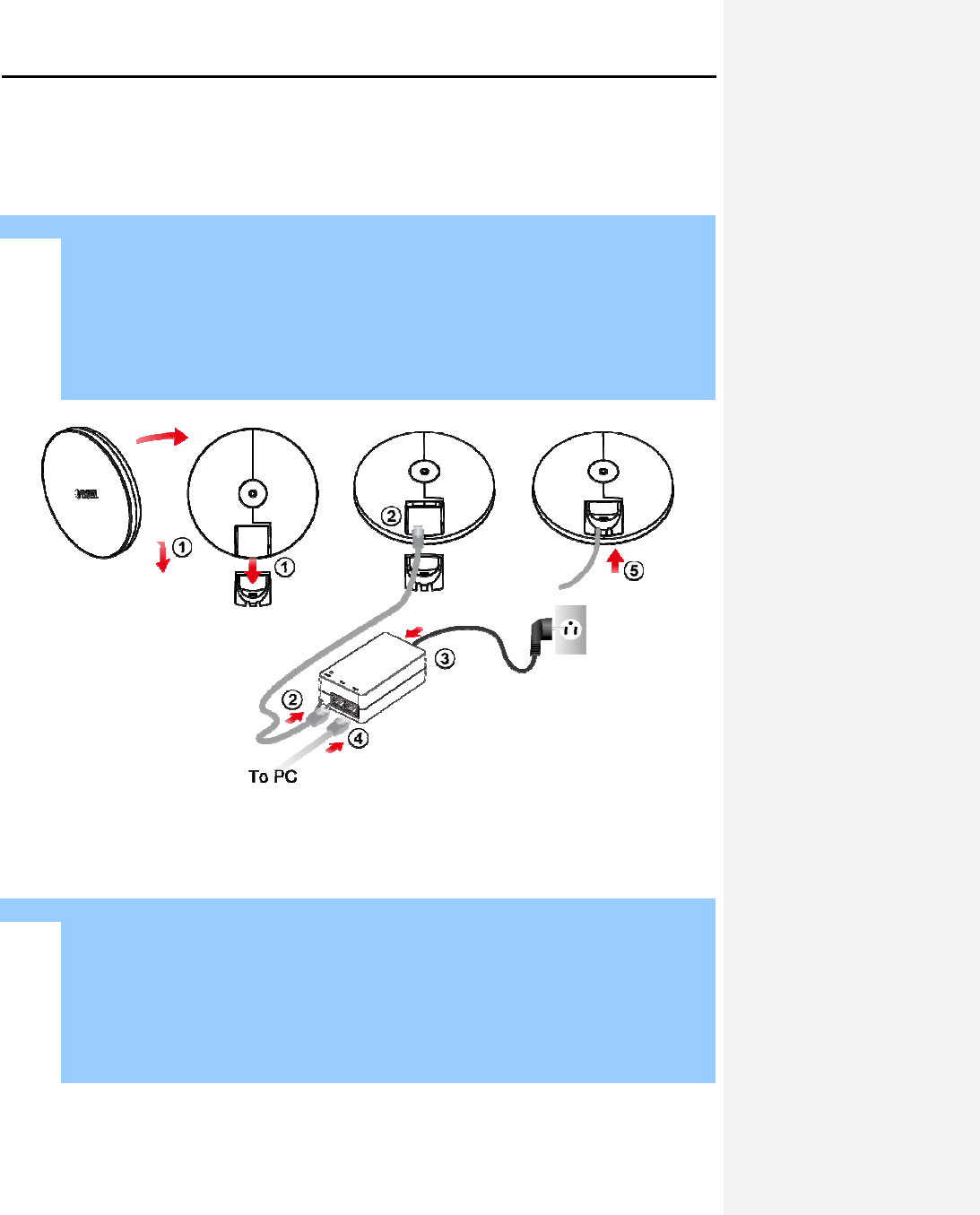
2.3 Installing the AP
Please install the AP
according to the following
hands dry.
Step 1.
PoE and LAN port connection:
(1) Remove the bottom
cover
(2)
Connect one end of the Ethernet cable into the LAN
end to the PoE port on the PoE Injector.
(3)
Connect the power cord with the PoE Injector
(4)
Connect the second Ethernet cable into the LAN port of the PoE Injector and the other end to the
Ethernet port on the computer.
(5)
Place the bottom cover back into the device.
Figure
Step 2. Pole Mounting:
(1)
Put the rubber into the bracket
(2)
Plug the dynamic stick into the bracket.
(3)
Screw the sealing nut and
(4)
Put the lock washer on the dynamic stick.
(5)
Assemble the mounting parts to the device.
(6)
Thread the open end of the mounting ring through the two tabs on the bracket.
(7)
Lock and tighten the mounting ring to
User
Manual of
-16-
according to the following
Step
s. Don't forget to pull out the power plug and keep
PoE and LAN port connection:
cover
.
Connect one end of the Ethernet cable into the LAN
(802.3at
PoE) port of the device and the other
end to the PoE port on the PoE Injector.
Connect the power cord with the PoE Injector
and plug the other end into an electrical outlet.
Connect the second Ethernet cable into the LAN port of the PoE Injector and the other end to the
Ethernet port on the computer.
Place the bottom cover back into the device.
Figure
2-1 PoE and LAN port connection
Figure 2-2 Finish installation
Put the rubber into the bracket
.
Plug the dynamic stick into the bracket.
Screw the sealing nut and
assemble parts, and make sure they are well tightened
Put the lock washer on the dynamic stick.
Assemble the mounting parts to the device.
Thread the open end of the mounting ring through the two tabs on the bracket.
Lock and tighten the mounting ring to
secure the bracket to the pole to finish the installation.
Manual of
WBS-502AC
s. Don't forget to pull out the power plug and keep
your
PoE) port of the device and the other
and plug the other end into an electrical outlet.
Connect the second Ethernet cable into the LAN port of the PoE Injector and the other end to the
assemble parts, and make sure they are well tightened
.
Thread the open end of the mounting ring through the two tabs on the bracket.
secure the bracket to the pole to finish the installation.
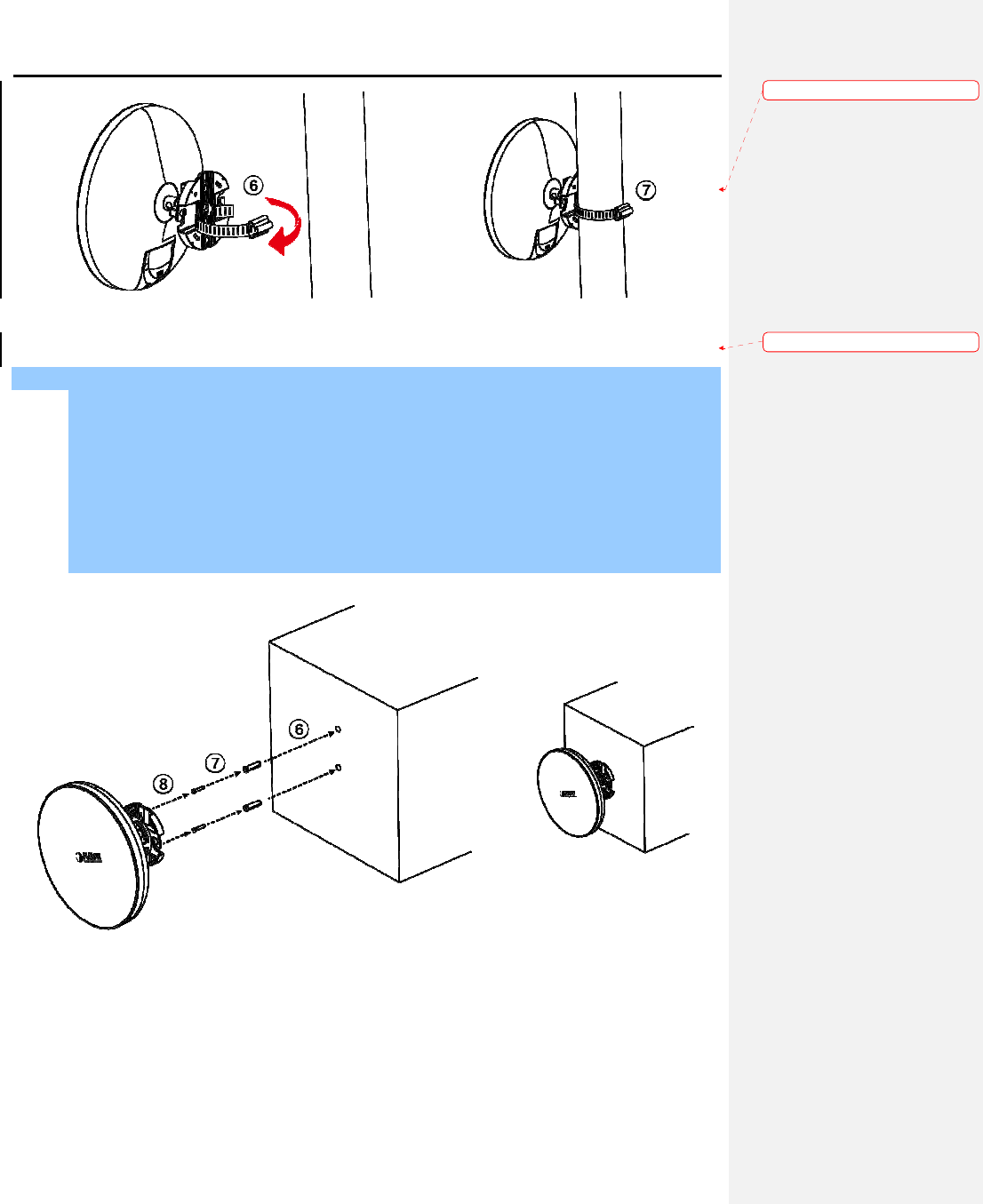
Step 4. Wall Mounting:
(1)
Put the rubber into the bracket
(2)
Plug the dynamic stick into the bracket.
(3)
Screw the sealing
nut and assemble parts, and make sure they are well tightened.
(4)
Put the lock washer on the dynamic stick.
(5)
Assemble the mounting parts to the device.
(6)
Mark and drill two pilot holes aligning to the screw holes of the bracket.
(7) Put
wall anchors into the holes
(8)
Screw and secure the bracket in place to finish the installation.
User
Manual of
-17-
Figure 2-3 Pole Mounting
Put the rubber into the bracket
.
Plug the dynamic stick into the bracket.
nut and assemble parts, and make sure they are well tightened.
Put the lock washer on the dynamic stick.
Assemble the mounting parts to the device.
Mark and drill two pilot holes aligning to the screw holes of the bracket.
wall anchors into the holes
and insert screw into the wall anchor.
Screw and secure the bracket in place to finish the installation.
Figure 2-4 Wall Mounting
Manual of
WBS-502AC
nut and assemble parts, and make sure they are well tightened.
格式化: 間距 套
用前:
格式化: 間距 套
用前:
用前:
0.5 行
用前:
0.5 行

User Manual of WBS-502AC
-18-
Chapter 3. Quick Installation Guide
This chapter will show you how to configure the basic functions of your AP within minutes.
A computer with wired Ethernet connection to the Wireless AP is required for the first-
time
configuration.
3.1 Manual Network Setup -- TCP/IP Configuration
The default IP address of the WBS-502AC is 192.168.1.253. And the default Subnet Mask is 255.255.255.0.
These values can be changed as you desire. In this guide, we use all the default values for description.
Connect the WBS-502AC with your PC via an Ethernet cable which is then plugged into a LAN port of the PoE
injector with one end and into a LAN port of the PC with the other end. Then power on the WBS-502AC via PoE
injector or PoE switch.
In the following sections, we’ll introduce how to install and configure the TCP/IP correctly in Windows 7. And the
procedures in other operating systems are similar. First, make sure your Ethernet adapter is working, and refer
to the Ethernet adapter’s manual if needed.
3.1.1 Configuring the IP Address Manually
Summary:
Set up the TCP/IP Protocol for your PC.
Configure the network parameters. The IP address is 192.168.1.xxx ("xxx" is any number from 2 to
252); subnet mask is 255.255.255.0.
1
Select Use the following IP address radio button.
2
If the AP's LAN IP address is 192.168.1.253, enter IP address 192.168.1.x (x is from 2 to 254 except
192.168.1.253), and subnet mask 255.255.255.0.
3
Select Use the following DNS server addresses radio button. In the Preferred DNS Server field, you can
enter the DNS server IP address which has been provided by your ISP
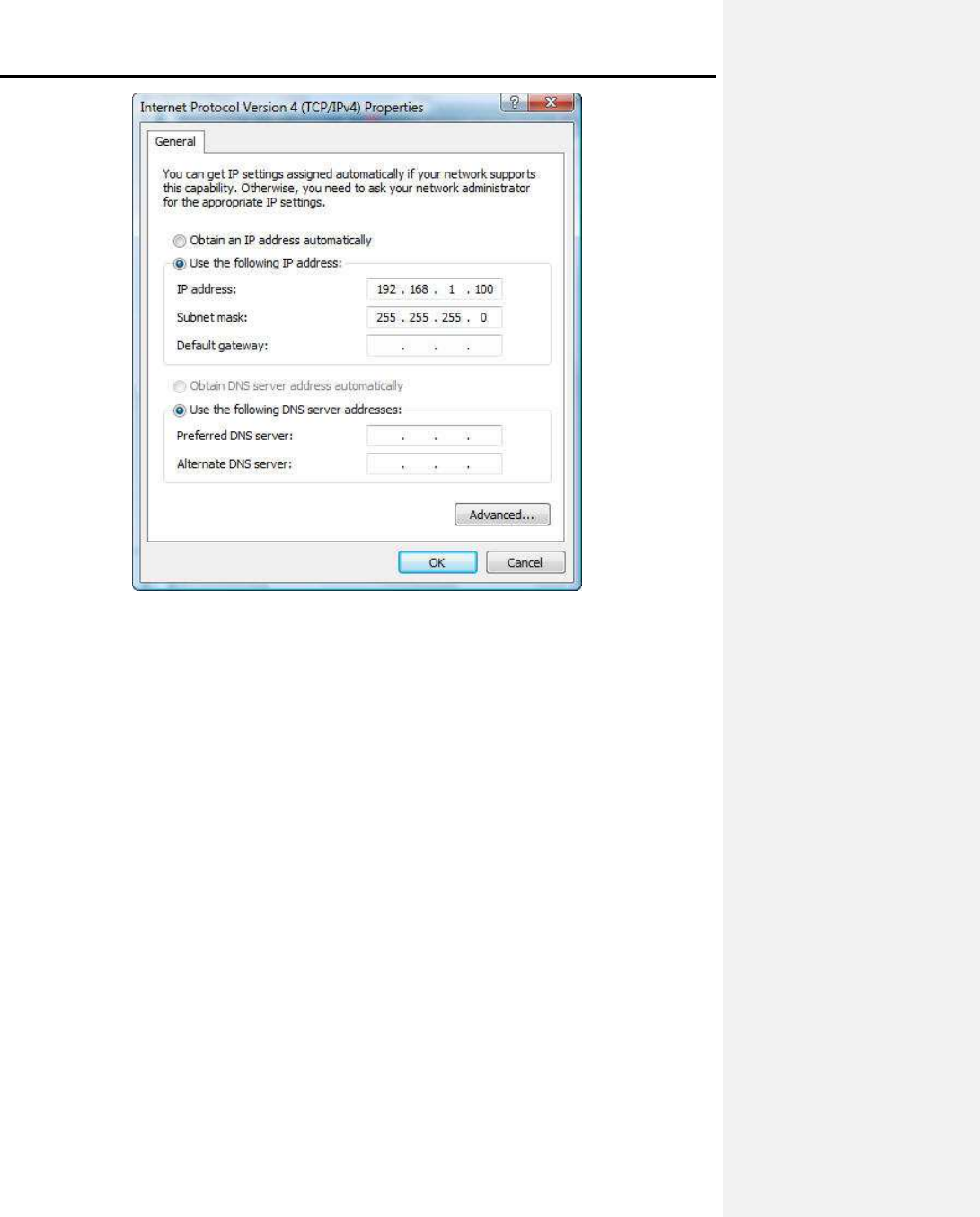
User Manual of WBS-502AC
-19-
Figure 3-1 TCP/IP Setting
Now click OK to save your settings.
Now, you can run the ping command in the command prompt to verify the network connection between your
PC and the AP. The following example is in Windows 7 OS. Please follow the Steps below:
1. Click on Start > Run.
2. Type “cmd” in the Search box.
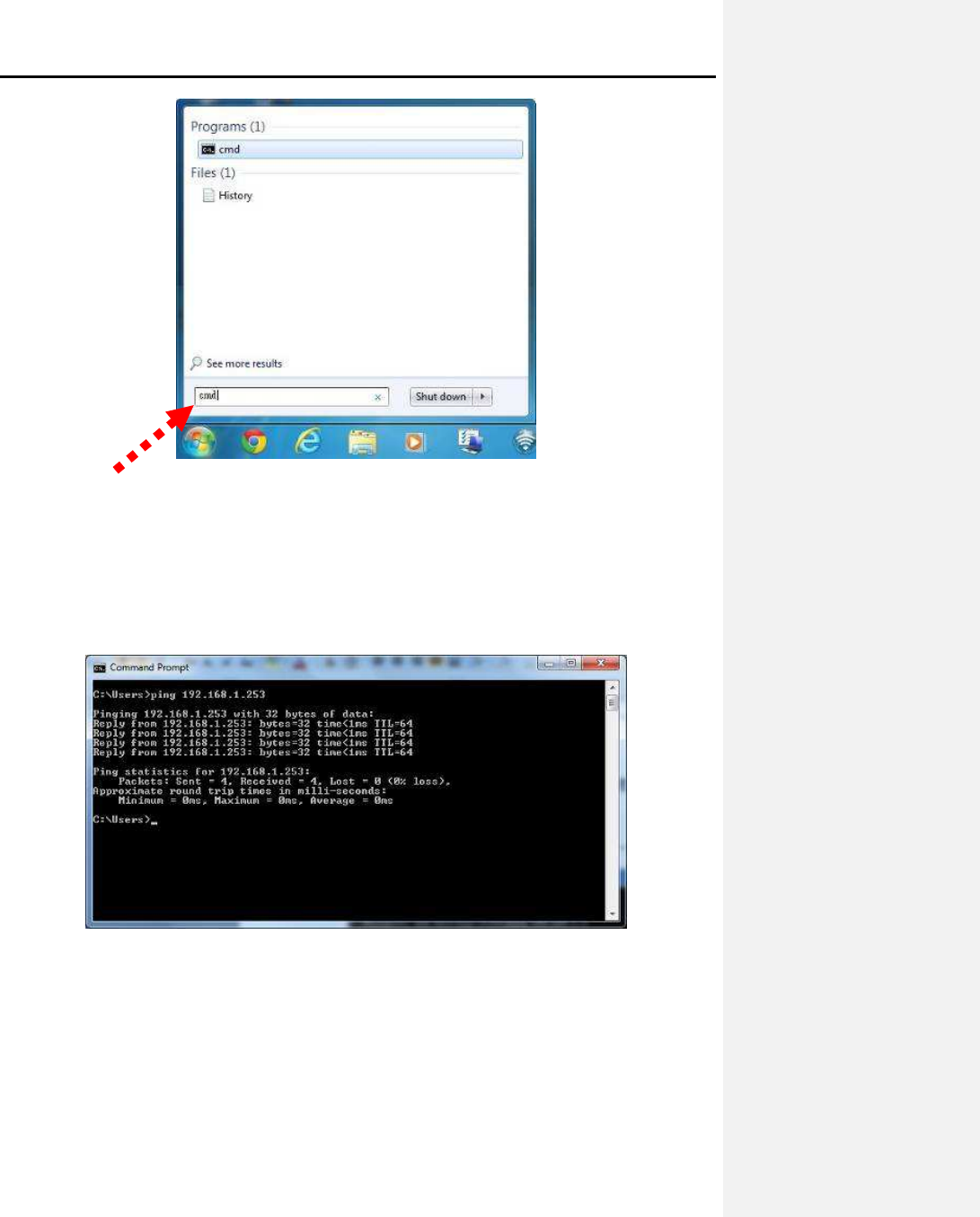
User Manual of WBS-502AC
-20-
Figure 3-2 Windows Start Menu
3. Open a command prompt and type ping 192.168.1.253, and then press Enter.
If the result displayed is similar to Figure 4-3, it means the connection between your PC and the AP
has been established well.
Figure 3-3 Successful result of Ping command
If the result displayed is similar to Figure 4-4, it means the connection between your PC and the AP
has failed.
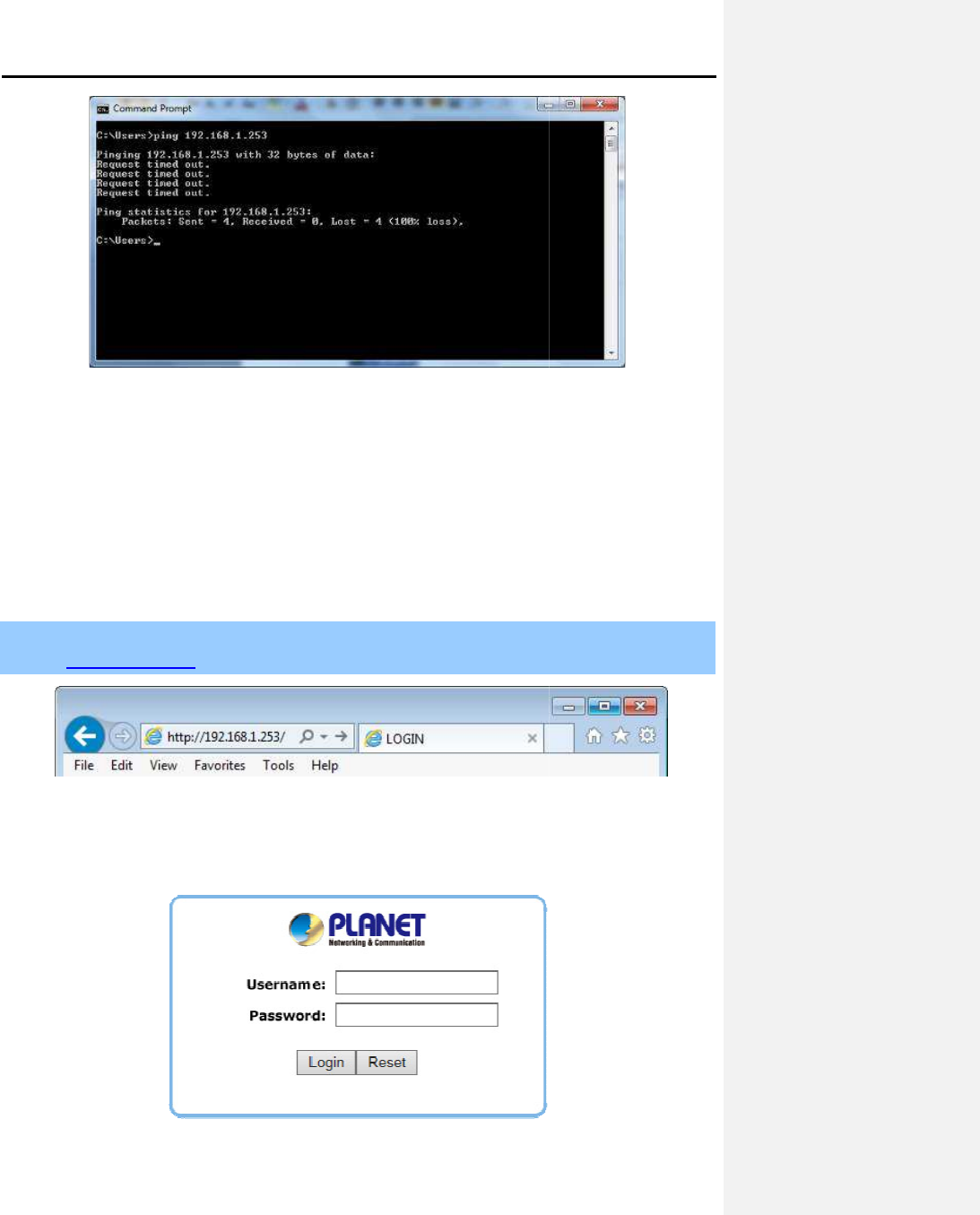
Figure
If the address is 0.0.0.0, check your adapter installation, security settings, and the settings on your
firewall software programs may block a DHCP request on newly installed adapters.
3.2 Starting Setup in
the
I
t is easy to configure and manage the
Step 1.
To access the configuration
http://192.168.1.253 in the
web
Figure
After a moment, a login window will appear
letters. Then click the OK
button or press the
User
Manual of
-21-
Figure
3-4 Failed result of Ping command
If the address is 0.0.0.0, check your adapter installation, security settings, and the settings on your
firewall software programs may block a DHCP request on newly installed adapters.
the
Web UI
t is easy to configure and manage the
WBS-502AC with the web browser.
To access the configuration
page, open a web browser and enter
web
address field of the browser.
Figure
3-5 Login by default IP address
After a moment, a login window will appear
. Enter admin
for the User Name and Password, both in lower case
button or press the
Enter key.
Figure 3-6 Login Window
Manual of
WBS-502AC
If the address is 0.0.0.0, check your adapter installation, security settings, and the settings on your
AP. Some
the default IP address
for the User Name and Password, both in lower case
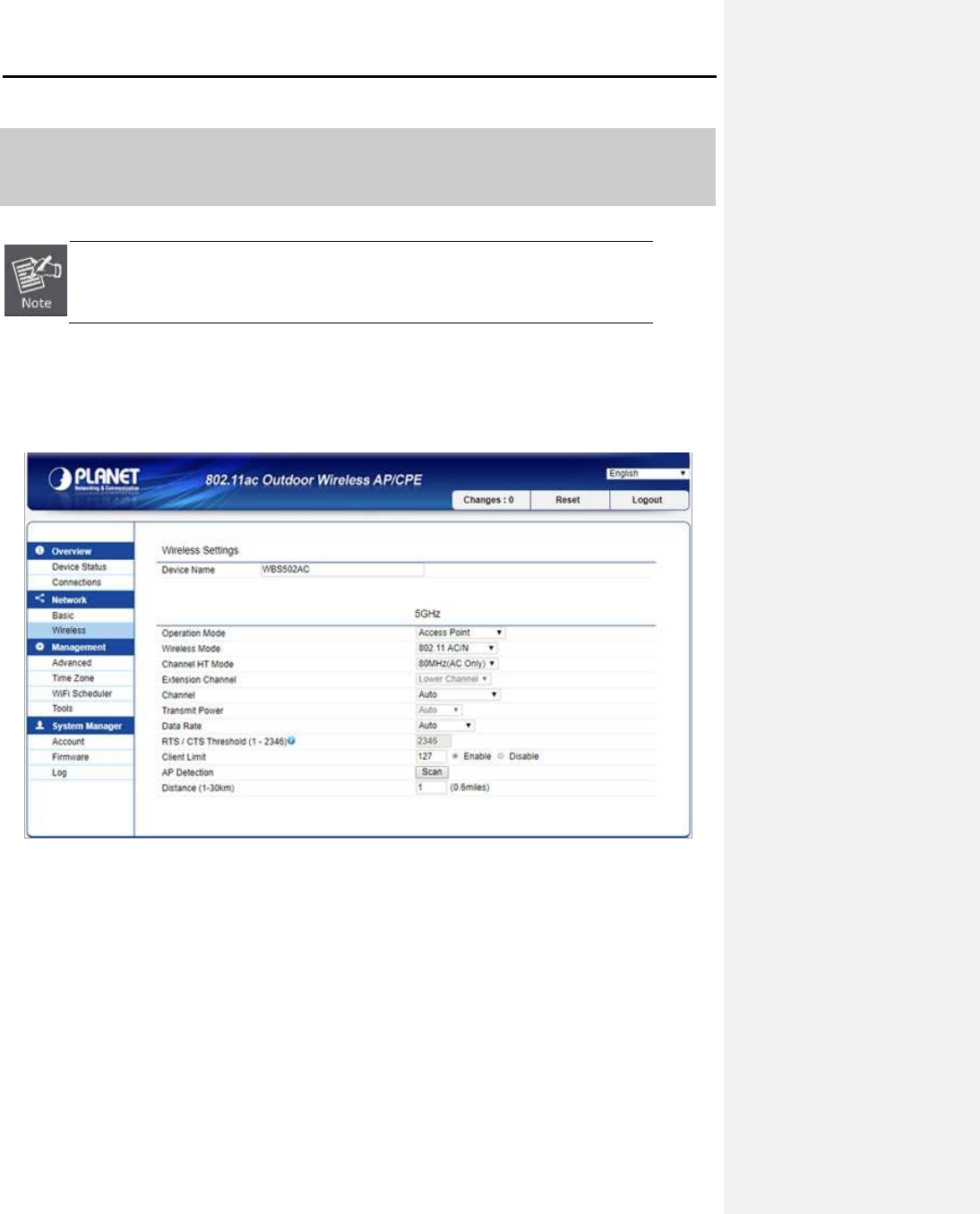
User Manual of WBS-502AC
-22-
Default IP Address: 192.168.1.253
Default User Name: admin
Default Password: admin
If the above screen does not pop up, it may mean that your web
browser has been set to a
proxy. Go to Tools menu> Internet Options> Connections> LAN Settings in the screen
that appears, cancel the Using Proxy checkbox, and click OK to finish it.
After you enter into the Web User Interface, click Wireless on the left hand side of the screen to configure the
wireless connection. Once the basic configuration of the device is done, go to the Changes page to save and
apply the changes.
Figure 3-7 Web UI Screenshot
You can choose an Operation Mode according to your application. Please refer to the instructions in the next
chapter for configuring different Operation Modes.
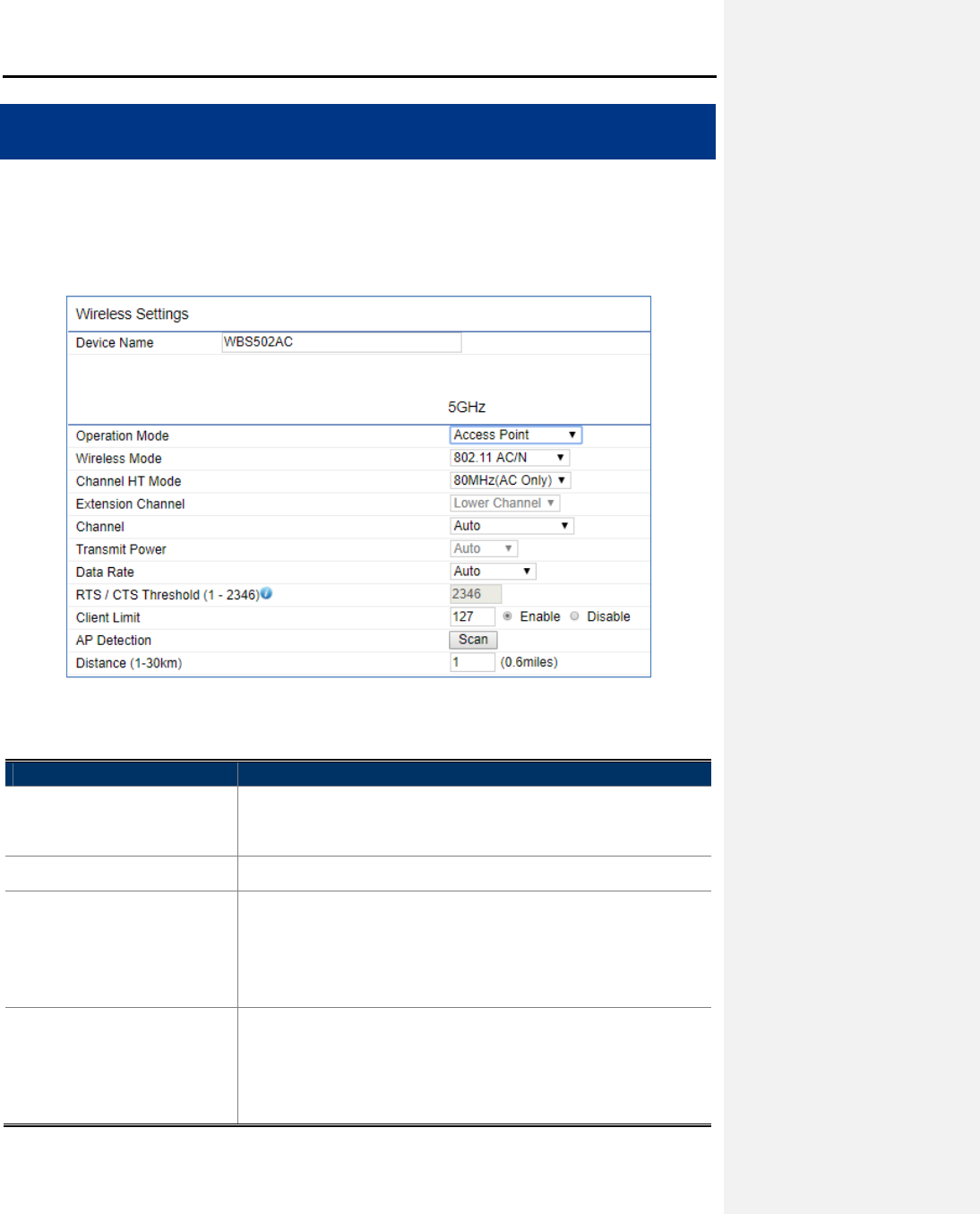
User Manual of WBS-502AC
-23-
Chapter 4. Configuring the AP
This chapter instructs you how to quickly configure the CPE in different operation modes.
4.1 Operation Mode
Go to the “Network Wireless” page to configure the operation mode which is suitable to your application.
Figure 4-1 Wireless – Basic
The page includes the following settings:
Object Description
• Device Name
Enter a name for the device (1-32 characters). The name you type
appears in SNMP management. This name is not the SSID and is not
broadcast to other devices.
• Operation Mode Select an operation mode for your application.
• Wireless Mode
The wireless mode supports the following 5GHz modes:
802.11AC/N mixed mode
802.11A/N mixed mode
802.11A
802.11N (5GHz)
• Channel HT Mode
The channel HT mode is the channel bandwidth and default is 80MHz
(AC only). The larger the channel bandwidth, the better the transmission
quality and speed. The Channel HT Mode includes:
80MHz (AC only)
40MHz

User Manual of WBS-502AC
-24-
20MHz
• Extension Channel Select upper or lower channel. Your selection may affect the Auto
channel function.
• Channel Select the appropriate channel and frequency.
Select Auto to enable auto-channel selection.
• Transmit Power
The transmission power of the device (value: auto).
To meet the regional regulation, this option is not allowed to be
configured through the user interface.
• Data Rate
Select a data rate from the drop-down list. The data rate affects
throughput. If you select a low data rate value, for example, the
throughput is reduced but the transmission distance increases. The
default is “Auto”.
• RTS/CTS Threshold (1-2346)
When the length of a data packet exceeds this value, the device will
send an RTS frame to the destination wireless node, and the latter will
reply with a CTS frame, and thus they are ready to communicate. The
default value is 2346. A small number causes RTS/CTS packets to be
sent more often and consumes more bandwidth.
• Client Limit Specify the maximum clients allowed to connect to the radio interface.
• AP Detection AP Detection can select the best channel to use by scanning nearby
areas for Access Points.
• Distance (1-30km) Specify the distance between the master AP and slave AP. Longer
distances may drop high-speed connections.
• Save Click Save to save changes.
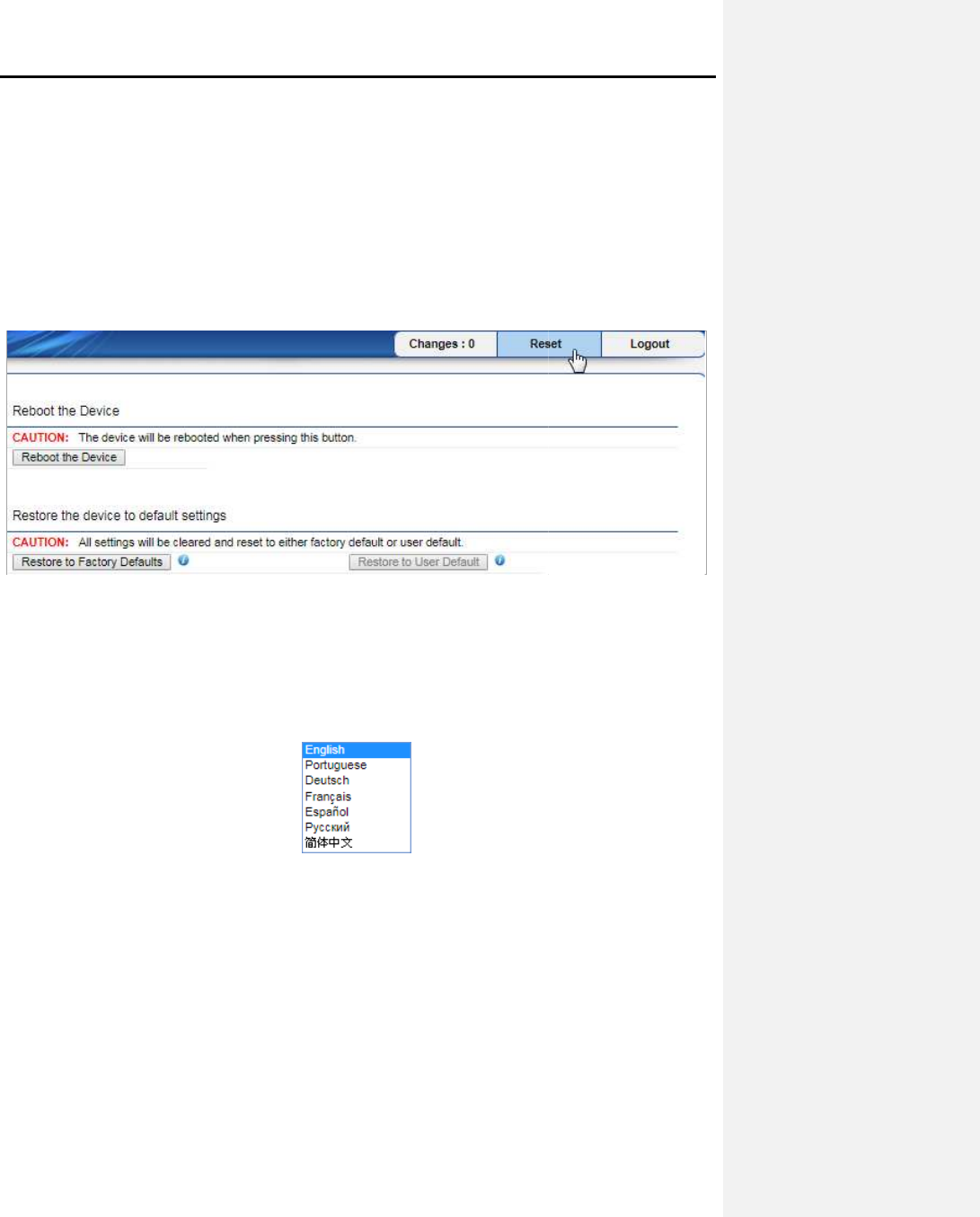
4.2 Overview
This section provides the current
system
List, WDS Link List, DHCP Client Table and Connection Status to assist the administrator
status.
In the upper-
right corner of each function page, you can click
current system status and click “
Reset
In the upper-
right corner of each function page, you can choose the
drop-
down list for better user experience. Once
the language that you preferred.
Figure
4.2.1 Device Status
Click “Overview Device Status”
to view the current system summary.
User
Manual of
-25-
system
summary, system log and connection status including Wireless Client
List, WDS Link List, DHCP Client Table and Connection Status to assist the administrator
right corner of each function page, you can click
“Home” to go
back to the
Reset
”
to force the system reboot or reset the device to factory defaults.
Figure 4-2 System Menu - Reset
right corner of each function page, you can choose the
Language
supported in the system from the
down list for better user experience. Once
a language is chosen
, the whole web page will be tran
Figure
4-3 System Menu – Language option
to view the current system summary.
Manual of
WBS-502AC
summary, system log and connection status including Wireless Client
List, WDS Link List, DHCP Client Table and Connection Status to assist the administrator
in viewing the network
back to the
Main page to view the
to force the system reboot or reset the device to factory defaults.
supported in the system from the
, the whole web page will be tran
slated into
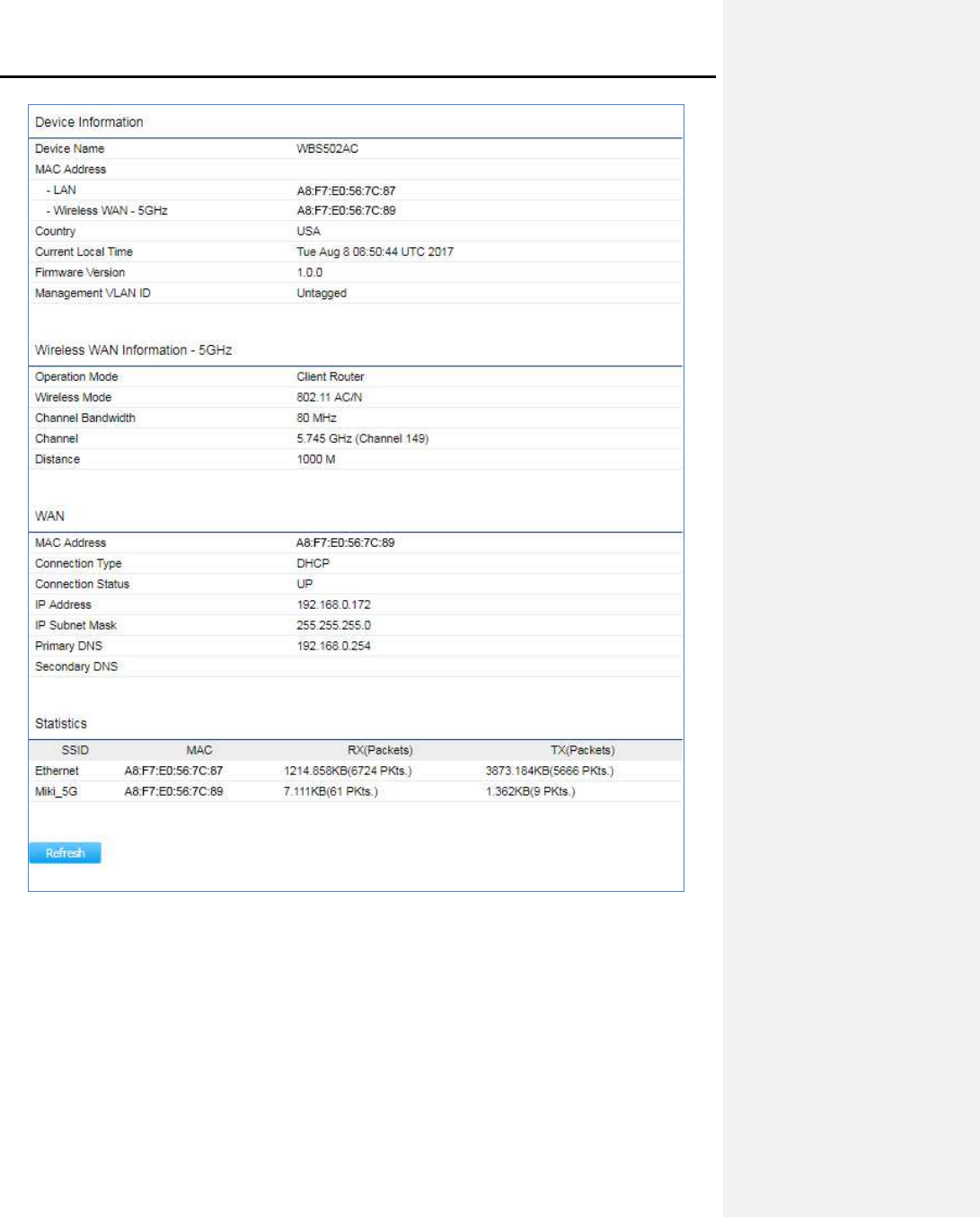
User Manual of WBS-502AC
-26-
Figure 4-4 Main Status
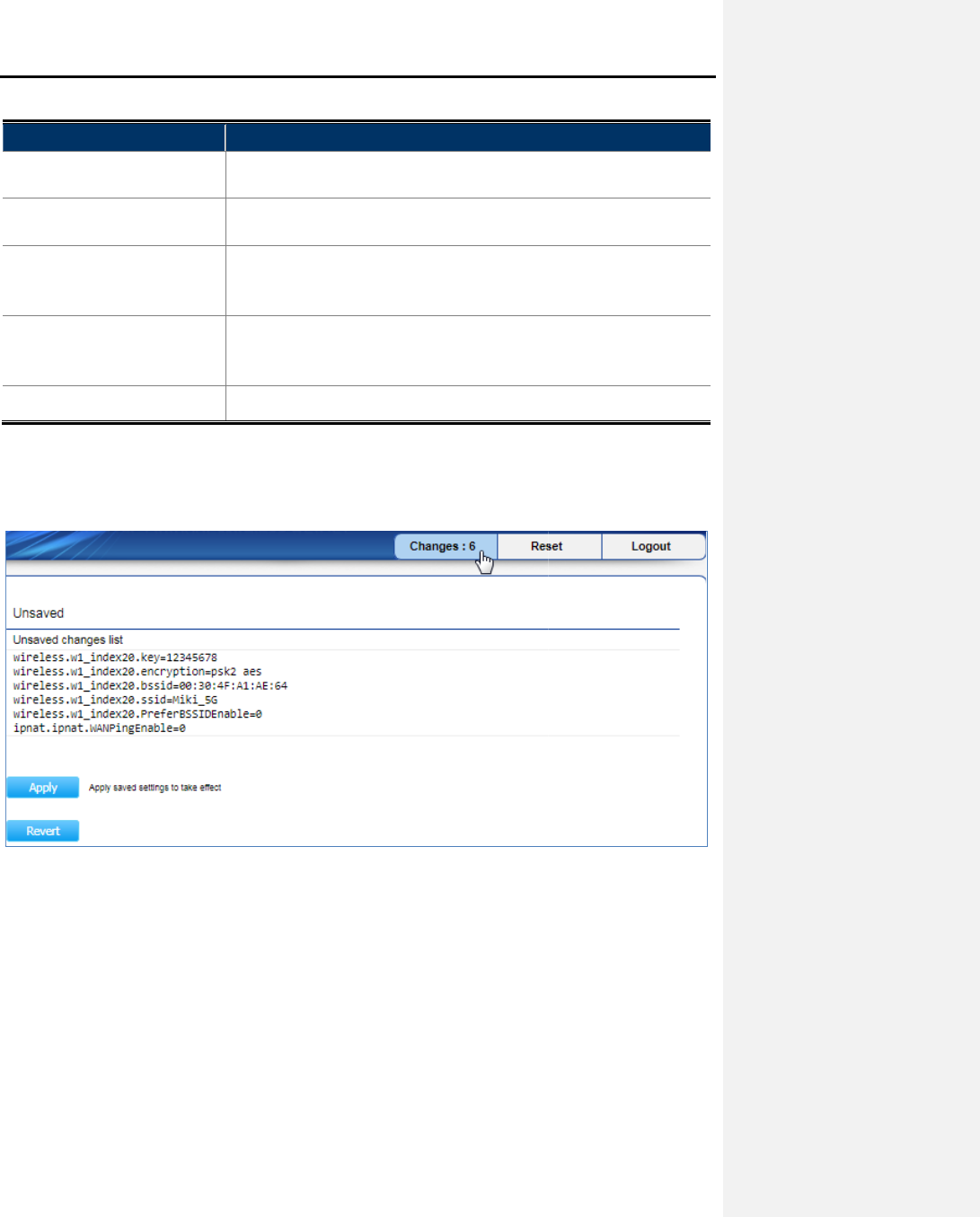
The page includes the following settings
Object
Description
• Device Information
S
address, country, current time,
• LAN Information
S
mask,
• WAN Information
S
type, connection status,
DNS
• Wireless LAN Information /
Wireless WAN Information
(WISP)
S
channel bandwidth,
security
• Statistics
Shows the current traffic statistic of each interface.
4.2.2 Changes
Click “Changes” a
nd the following page
Click Apply
to save and apply all configurations.
Click Revert
to cancel the unsaved changes and revert to the previous settings that have been saved.
It's not necessary to save and apply the settings if unsaved changes list is empty.
4.2.3 Wireless Client List
Click “Overview Connections”
to view the current associated client.
User
Manual of
-27-
The page includes the following settings
:
Description
S
hows the general system information such as
device name, MAC
address, country, current time,
and
firmware version.
S
hows Local Area Network settings such as the
LAN IP address, subnet
mask,
DHCP server, and Rx/Tx packets.
S
hows Wide Area Network settings such as the
MAC address, connecti
type, connection status,
IP
address, subnet mask,
DNS
, and Rx/Tx packets.
S
hows wireless information such as
operation mode, wireless mode,
channel bandwidth,
frequency, channel,
information about each SSID,
security
settings, and Rx/Tx packets.
Shows the current traffic statistic of each interface.
nd the following page
will be displayed.
Figure 4-5 Changes
to save and apply all configurations.
to cancel the unsaved changes and revert to the previous settings that have been saved.
It's not necessary to save and apply the settings if unsaved changes list is empty.
to view the current associated client.
Manual of
WBS-502AC
device name, MAC
firmware version.
LAN IP address, subnet
MAC address, connecti
on
address, subnet mask,
primary and secondary
operation mode, wireless mode,
information about each SSID,
Shows the current traffic statistic of each interface.
to cancel the unsaved changes and revert to the previous settings that have been saved.
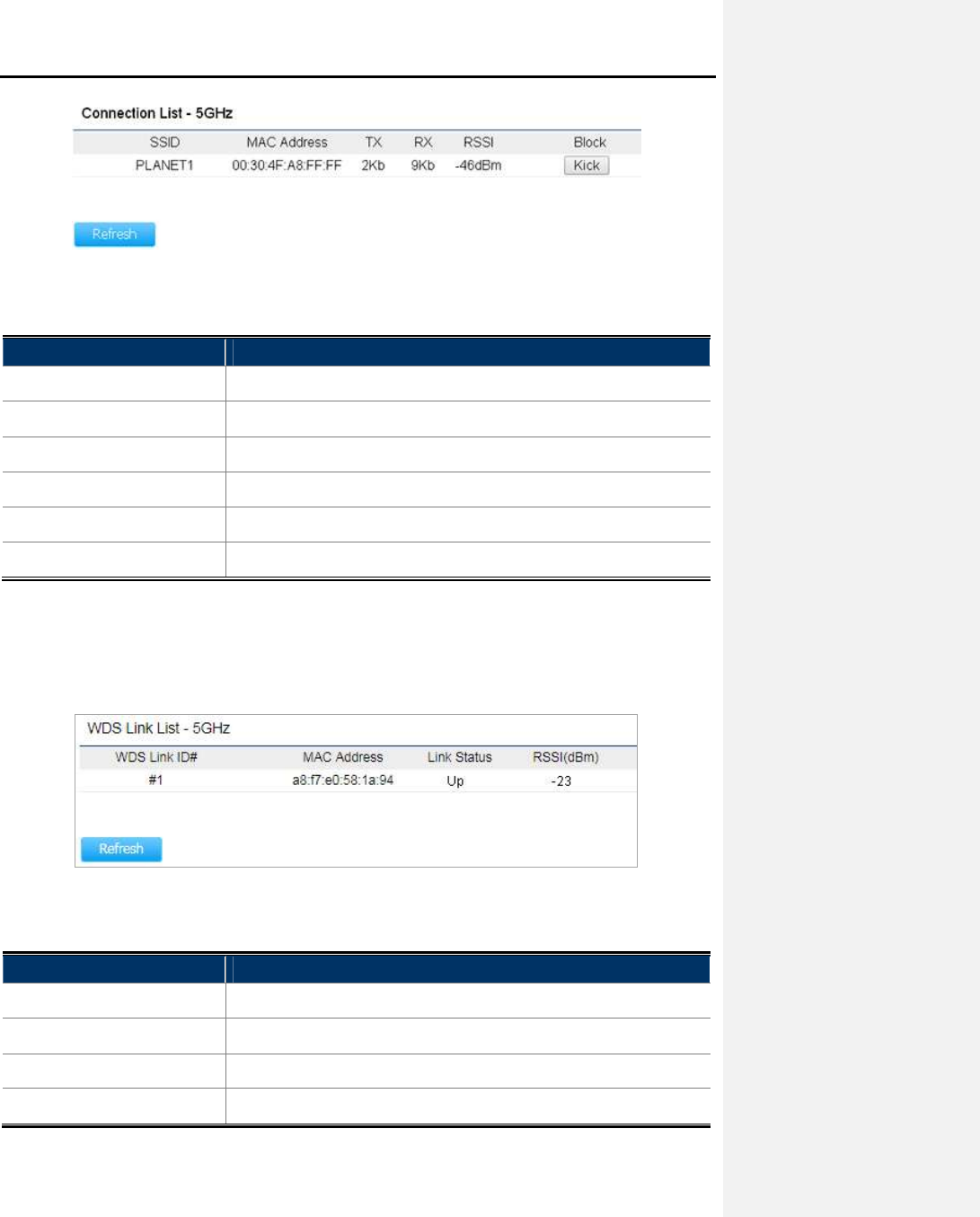
User Manual of WBS-502AC
-28-
Figure 4-6 Wireless Client List
The page includes the following settings:
Object Description
• SSID:# The SSID number that the client is associated with.
• MAC Address The MAC address of the associated client.
• Tx (Bytes) The current transmit packet of the associated client.
• Rx (Bytes) The current received packet of the associated client.
• RSSI (dBm) The current signal strength of the associated client.
• Kick Click Kick to add the client to the MAC ACL denied list.
4.2.4 WDS Link List
Click “Overview Connections” to view the current WDS link client.
The WDS Link List is only available in WDS AP and WDS Bridge modes.
Figure 4-7 WDS Link Status
The page includes the following settings:
Object Description
• WDS Link ID The sequence number of the WDS link.
• MAC Address The MAC Address of the associated remote node.
• Link Status The current link status.
• RSSI (dBm) The current signal strength of the associated remote node.
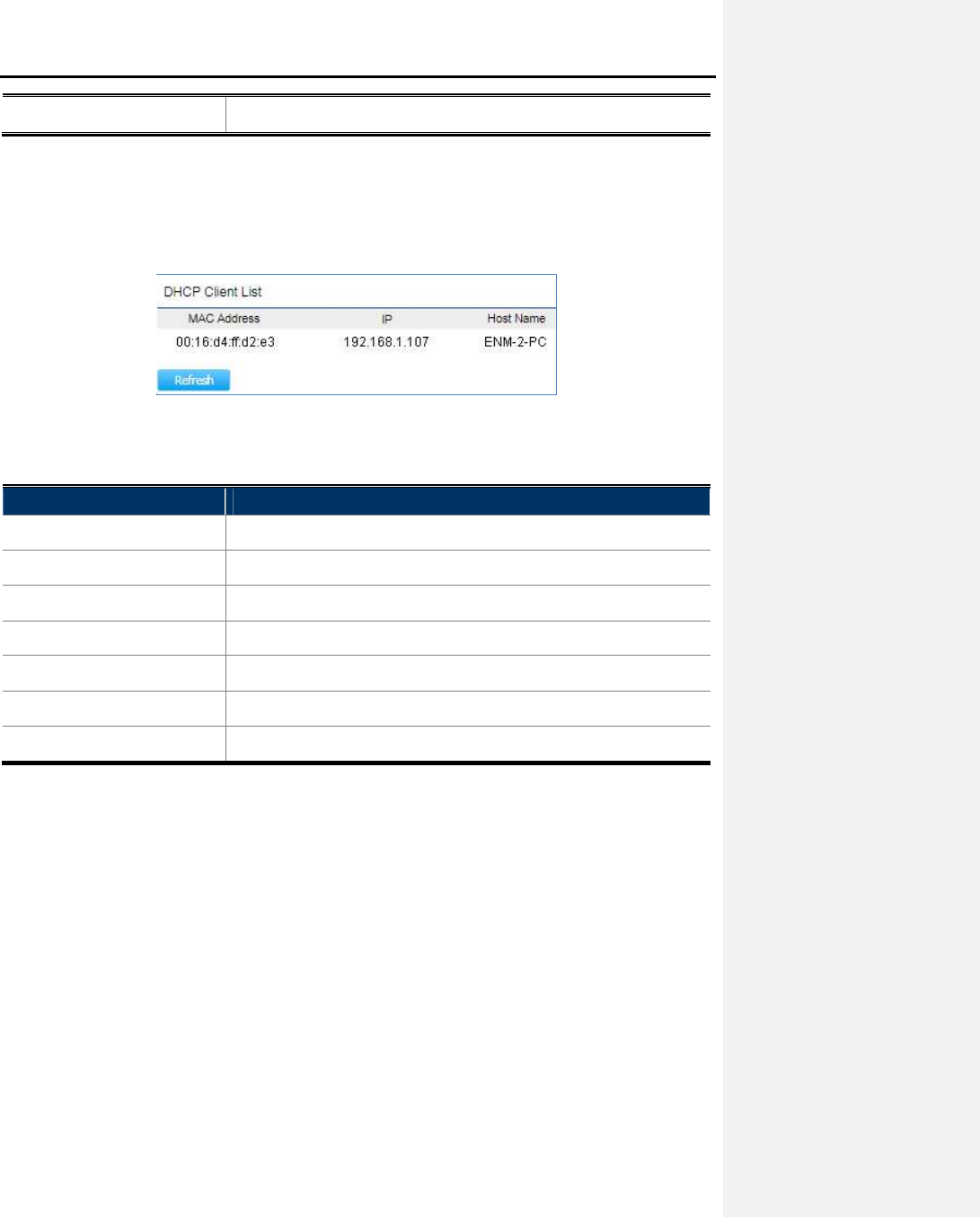
User Manual of WBS-502AC
-29-
• Refresh Click Refresh to update the current list.
4.2.5 DHCP Client Table
Click “Overview -> DHCP Client Table” to view the current DHCP client.
The DHCP Client Table is only available in CR (WISP) mode.
Figure 4-8 DHCP Client List
The page includes the following settings:
Object Description
• MAC Address The MAC Address of the DHCP client.
• IP The IP assigned to the DHCP client.
• Host Name The Host Name of the DHCP client.
• Expires The Expired time of the DHCP client.
• Revoke Click Revoke to revoke the DHCP lease of the client.
• Reserve Click Reserve to reserve the IP to the client.
• Refresh Click Refresh to update the client list.
4.2.6 Connection Status
Click “Overview Connections” to view the current association status.
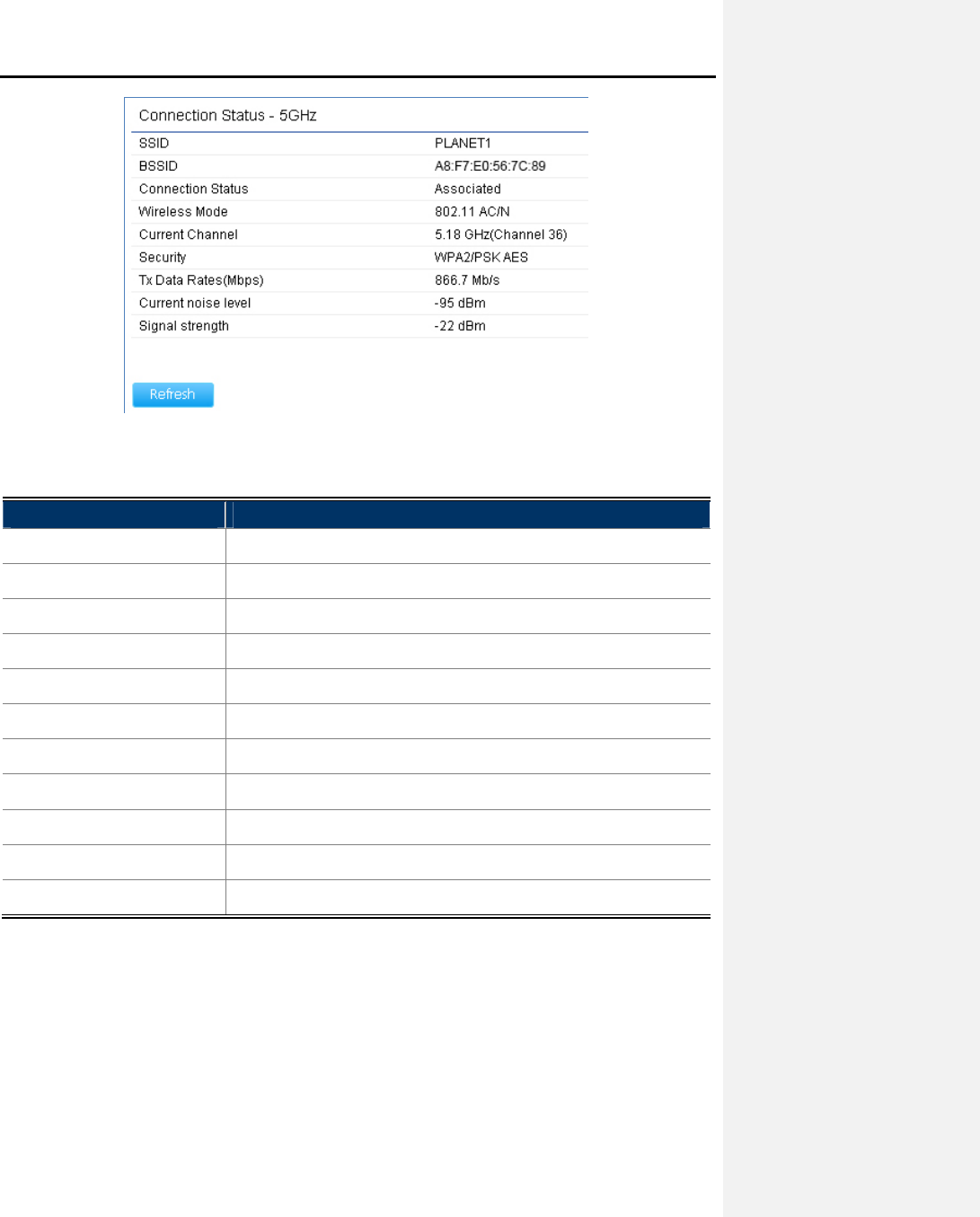
User Manual of WBS-502AC
-30-
Figure 4-9 Connection Status
The page includes the following settings:
Object Description
• Network Type The current operation mode of the device.
• SSID The SSID of the connected AP.
• BSSID The MAC Address of the connected AP.
• Connection Status The status of the connection.
• Wireless Mode The current wireless mode of the AP.
• Current Channel The current channel used of this connection.
• Security The encryption method of the AP.
• Tx Data Rates (Mbps) The current data rates of the connection.
• Current Noise Level The current noise level of the connection
• Signal Strength The current signal strength of the connected AP.
• Refresh Click Refresh to update the current data.
4.3 Network
4.3.1 IP Settings
Click “Network Basic” to configure the LAN IP address.
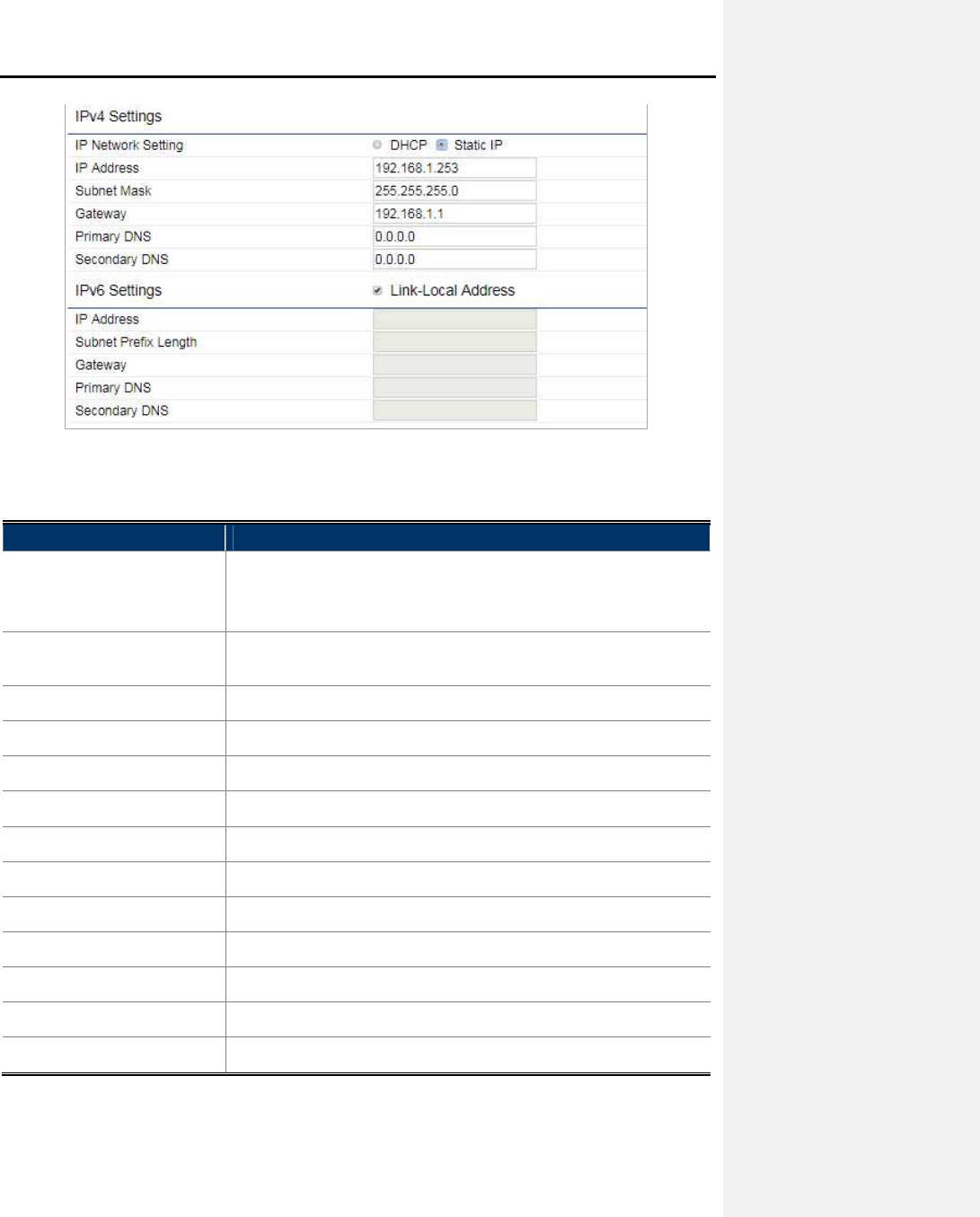
User Manual of WBS-502AC
-31-
Figure 4-10 LAN IP Settings
The page includes the following settings:
Object Description
• IP Network Setting
Select Obtain an IP address automatically (DHCP) to receive the IP
from DHCP server.
Select Specify an IP address to configure the AP to use static IP.
• IP Address The LAN IP of the AP.
The default is 192.168.1.253. You can change it according to your needs.
• IP Subnet Mask The LAN subnet mask of the AP.
• Default Gateway Enter the Gateway IP address of the AP.
• Primary DNS Enter the primary DNS server of the AP.
• Secondary DNS Enter the secondary DNS server of the AP.
• Use Link-Local Address Click to enable a link-local address for the AP.
• IPv6 IP Address Enter the IPv6 LAN IP of the AP.
• IPv6 Subnet Prefix Length Enter the secondary DNS server of the AP.
• IPv6 Default Gateway Enter the IPv6 Gateway IP address of the AP.
• IPv6 Primary DNS Enter the IPv6 primary DNS server of the AP.
• IPv6 Secondary DNS Enter the IPv6 secondary DNS server of the AP.
• Save Click Save to apply the new settings.
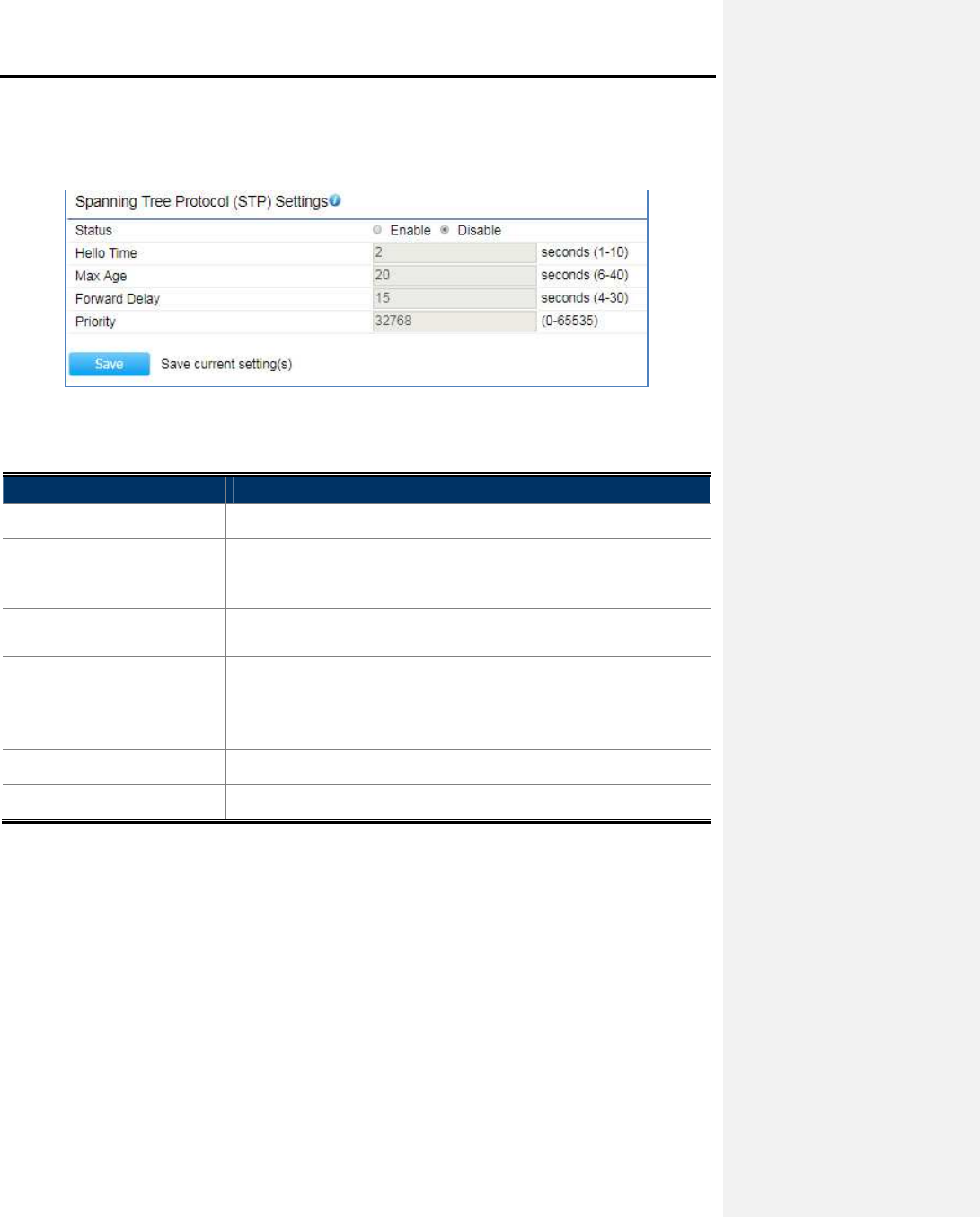
User Manual of WBS-502AC
-32-
4.3.2 Spanning Tree Settings
The Spanning Tree Protocol (STP) allows network to provide a redundant link in the event of a link failure.
Click “Network Basic” to enable/disable Spanning Tree Settings.
Figure 4-11 Spanning Tree Settings
The page includes the following settings:
Object Description
• Spanning Tree Status Click Enable to enable or click Disable to disable the option.
• Hello Time
Specify Hello Time in seconds. This value determines how often the AP
sends hello packets to communicate information about the topology
throughout the entire Bridged Local Area Network.
• Max Age Specify Max Age in seconds. If another bridge in the spanning tree does
not send a hello packet for a long period of time, it is assumed to be dead.
• Forward Delay
Specify Forward Delay in seconds. Forwarding delay time is the time
spent in each of the Listening and Learning states before the Forwarding
state is entered. This delay is provided so that when a new bridge comes
onto a busy network, it looks at some traffic before participating.
• Priority Specify the Priority number. Smaller numbers have greater priority.
• Save Click Save to save the setting.
4.4 Router (WISP Mode Only)
4.4.1 DHCP Server Settings
Go to the “Network Wireless” page to configure the device as “WISP” and then go to “Router LAN
Settings” to configure the device’s LAN IP settings.
On this page, enable the DHCP server to assign IP address to local wired/wireless clients after the device is
connected to the remote AP supplied by wireless ISP.
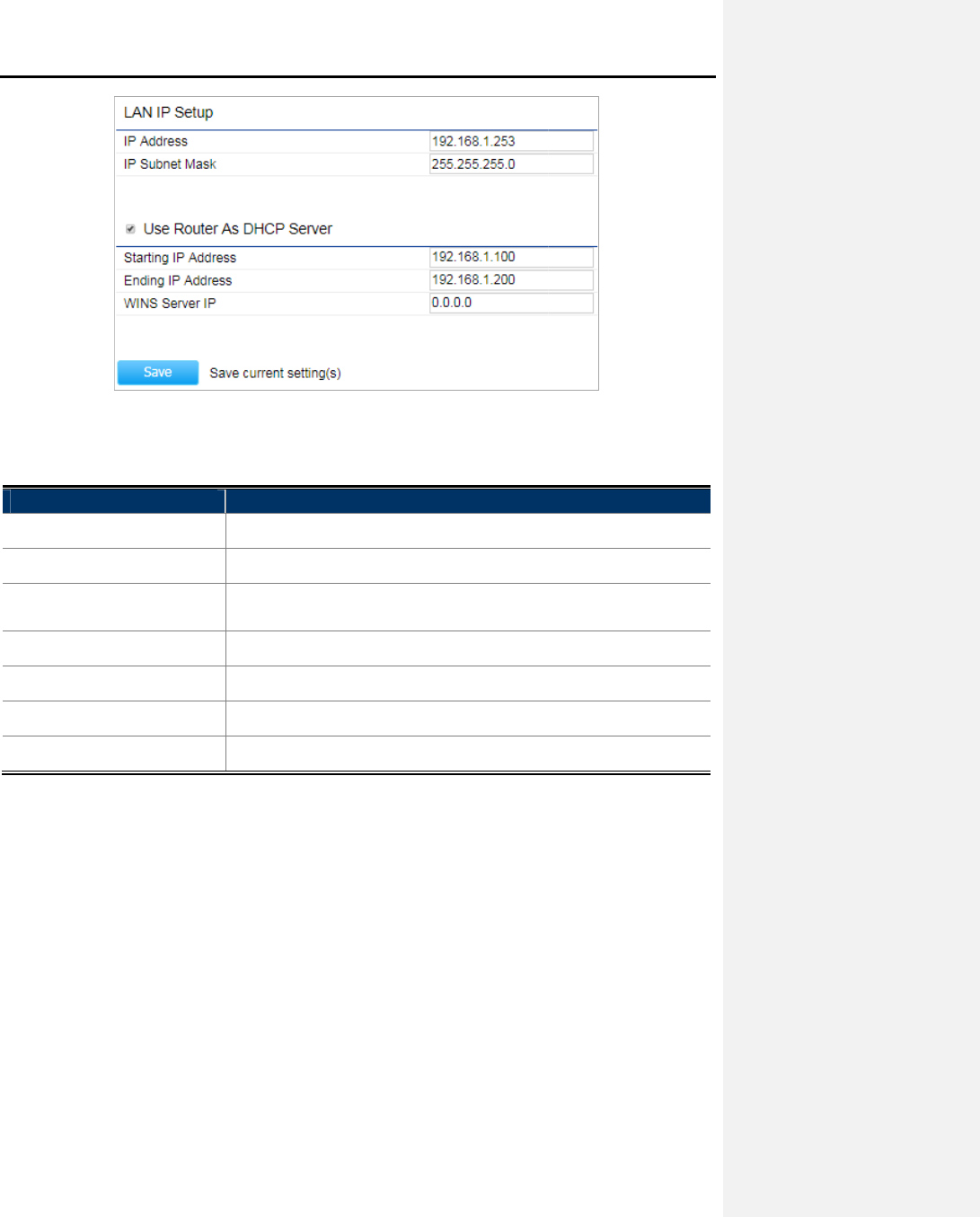
The page includes the following settings
Object
Description
• IP Address
The
• IP Subnet Mask
The
• Use Router As DHCP
Server
Select
• Starting IP Address
Specify the starting IP address for
• Ending IP Address
Specify the
• WINS Server IP
Enter the IP address of the WINS server.
• Save
Click
4.4.2 WAN Settings
Go to the “Network Wireless”
page to configure the device as
Settings”
to configure the device’s WAN settings.
User
Manual of
-33-
Figure 4-12 DHCP Server Settings
The page includes the following settings
:
Description
The
LAN IP of the AP.
The
LAN subnet mask of the AP.
Select
it to enable DHCP server.
In here the device is acting as a router.
Specify the starting IP address for
the
DHCP range.
Specify the
ending IP address for the
DHCP range.
Enter the IP address of the WINS server.
Click
Save to save the setting.
page to configure the device as
“WISP” and the
n
to configure the device’s WAN settings.
The WAN settings should be
provided
Manual of
WBS-502AC
In here the device is acting as a router.
DHCP range.
DHCP range.
n
go to “Router WAN
provided
by the ISP.
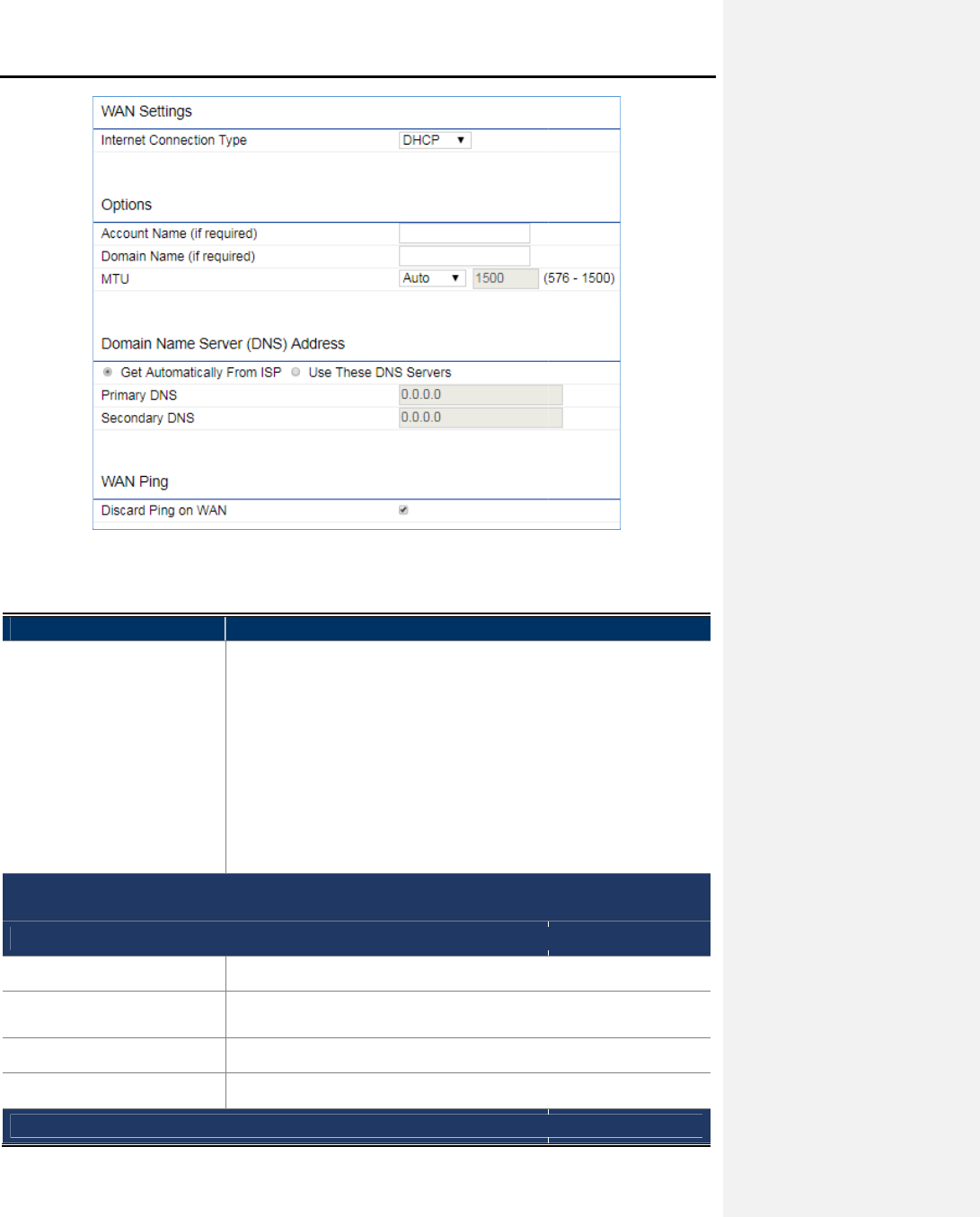
The page includes the following common settings in each Internet Connection Type
Object
Description
• Internet Connection Type
•
•
•
•
Option: This section may
vary depend
Refer to settings of each corresponding section from 5.4.2.1 to 5.4.2.4
Domain Name Server (DNS)
Address
• Get Automatically From ISP
Select it
• Use These DNS Servers
Select it
manually.
• Primary DNS
Enter the primary DNS server address.
• Secondary DNS
Enter the secondary DNS server address.
WAN Ping
User
Manual of
-34-
Figure 4-13 WAN Settings – All
The page includes the following common settings in each Internet Connection Type
:
Description
•
DHCP: Dynamic IP ad
dressing assigns a different IP
time a device connects to an ISP
service provider.
•
Static IP:
Setting a static IP address allows an administrator
specific IP address for the router and guarantees
assigned a different address.
•
PPPoE: Point-to-
Point Protocol over Ethernet (PPPoE) is
by ISPs that provide DSL modems to
connect to the Internet.
•
PPTP: The Point-to-Point Tunneling P
rotocol (PPTP) is
association with virtual private networks
(VPNs).
vary depend
ing on the Internet Connection Type.
Refer to settings of each corresponding section from 5.4.2.1 to 5.4.2.4
Address
Select it
to obtain the DNS automatically from the DHCP server.
Select it
to set up the Primar
y DNS and Secondary DNS servers
manually.
Enter the primary DNS server address.
Enter the secondary DNS server address.
Manual of
WBS-502AC
dressing assigns a different IP
address each
service provider.
Setting a static IP address allows an administrator
to set a
specific IP address for the router and guarantees
that it cannot be
Point Protocol over Ethernet (PPPoE) is
used mainly
connect to the Internet.
rotocol (PPTP) is
used in
(VPNs).
to obtain the DNS automatically from the DHCP server.
y DNS and Secondary DNS servers

• Discard Ping on WAN
Check
the WAN interface.
4.4.2.1.
DHCP
Select DHCP and the device will
automatically obtain IP addresses, subnet masks and gateway addresses from
the ISP.
The page includes the following specific settings in DHCP type
Object
Description
• Account Name (if required)
Enter the account name provided
• Domain Name (if required)
Enter the domain name provided
• MTU
The maximum transmission unit (MTU)
permitted for an
DHCP
4.4.2.2.
Static IP
If your ISP offers you static IP In
ternet connection type, select
p
rimary DNS and secondary DNS information provided by
User
Manual of
-35-
Check
it to enable pings on the WAN interface or
d
the WAN interface.
automatically obtain IP addresses, subnet masks and gateway addresses from
Figure 4-14 WAN Settings – DHCP
The page includes the following specific settings in DHCP type
:
Description
Enter the account name provided
by your ISP.
Enter the domain name provided
by your ISP.
The maximum transmission unit (MTU)
specifies the largest packet size
permitted for an
internet transmission. The factory default MTU size
DHCP
is 1500. The MTU size can be set
between 576 and
ternet connection type, select
Static IP
and then enter IP address, subnet mask,
rimary DNS and secondary DNS information provided by
ISP in the
corresponding fields.
Manual of
WBS-502AC
d
isable to block pings on
automatically obtain IP addresses, subnet masks and gateway addresses from
specifies the largest packet size
internet transmission. The factory default MTU size
for
between 576 and
1500.
and then enter IP address, subnet mask,
corresponding fields.
格式化: 間距 套
用前:
用前:
0.5 行
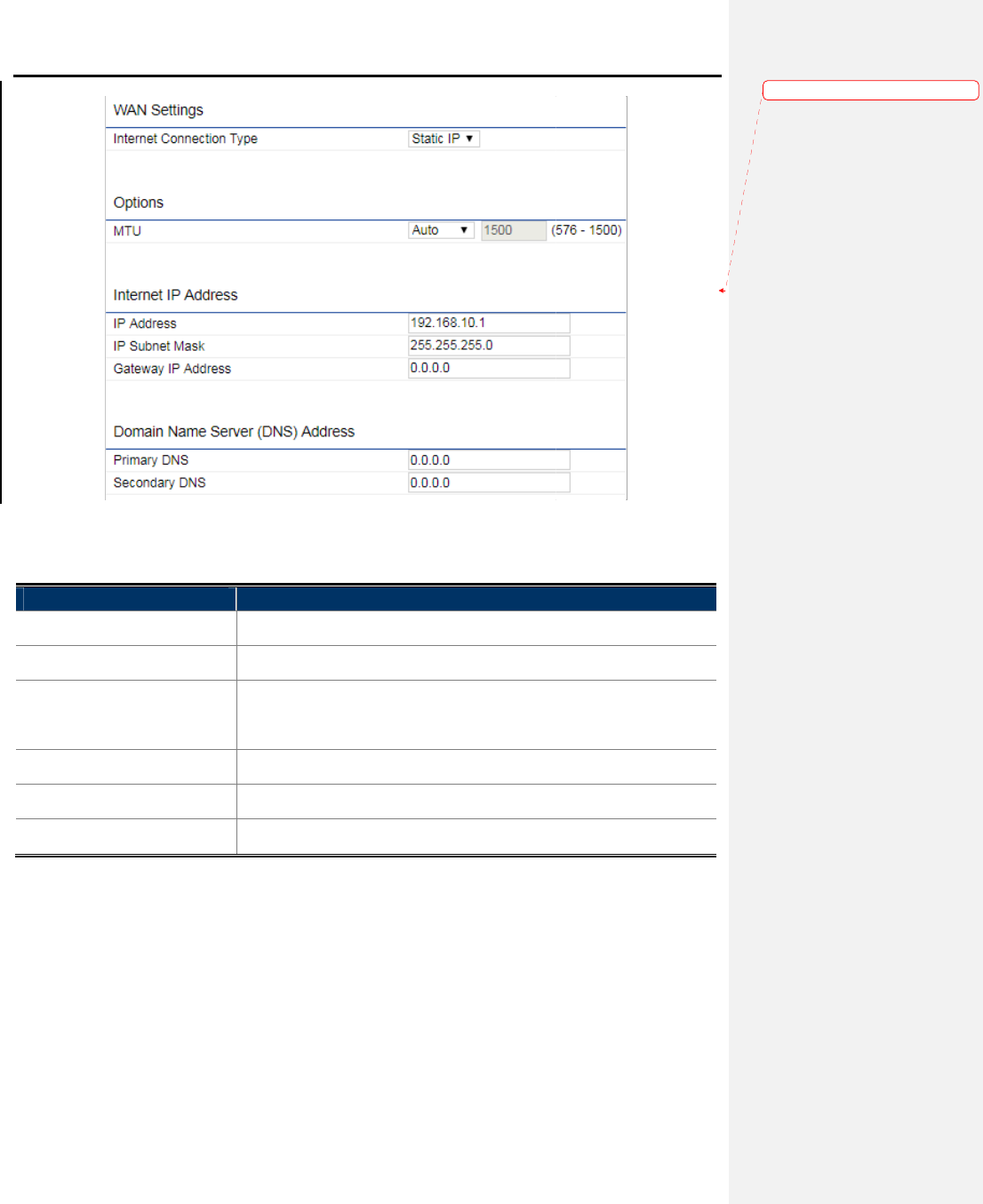
Figure
The page includes the following specific settings in Static IP type
Object
Description
• Account Name (if required)
Enter the account name provided
• Domain Name (if required)
Enter the
• MTU
The maximum transmission unit (MTU)
permitted for an
static IP is 1500. The MTU size can be set
• IP Address
Enter the
• IP Subnet Mask
Enter the
• Gateway IP Address
Enter the
4.4.2.3.
PPPoE
Select PPPOE if ISP
is using a PPPoE connection and provide you with PPPoE user name and password
User
Manual of
-36-
Figure
4-15 WAN Settings – Static IP
The page includes the following specific settings in Static IP type
:
Description
Enter the account name provided
by your ISP.
Enter the
domain name provided by your ISP.
The maximum transmission unit (MTU)
specifies the largest packet size
permitted for an
internet transmission. The factory default MTU size
static IP is 1500. The MTU size can be set
between 576 and 1500.
Enter the
device’s WAN IP address
provided by ISP
Enter the
device’s WAN IP
subnet mask provided by ISP
Enter the
device’s WAN Gateway IP
provided by ISP
is using a PPPoE connection and provide you with PPPoE user name and password
Manual of
WBS-502AC
specifies the largest packet size
internet transmission. The factory default MTU size
for
between 576 and 1500.
provided by ISP
.
subnet mask provided by ISP
.
provided by ISP
.
is using a PPPoE connection and provide you with PPPoE user name and password
.
格式化: 間距 套
用前:
用前:
0.5 行
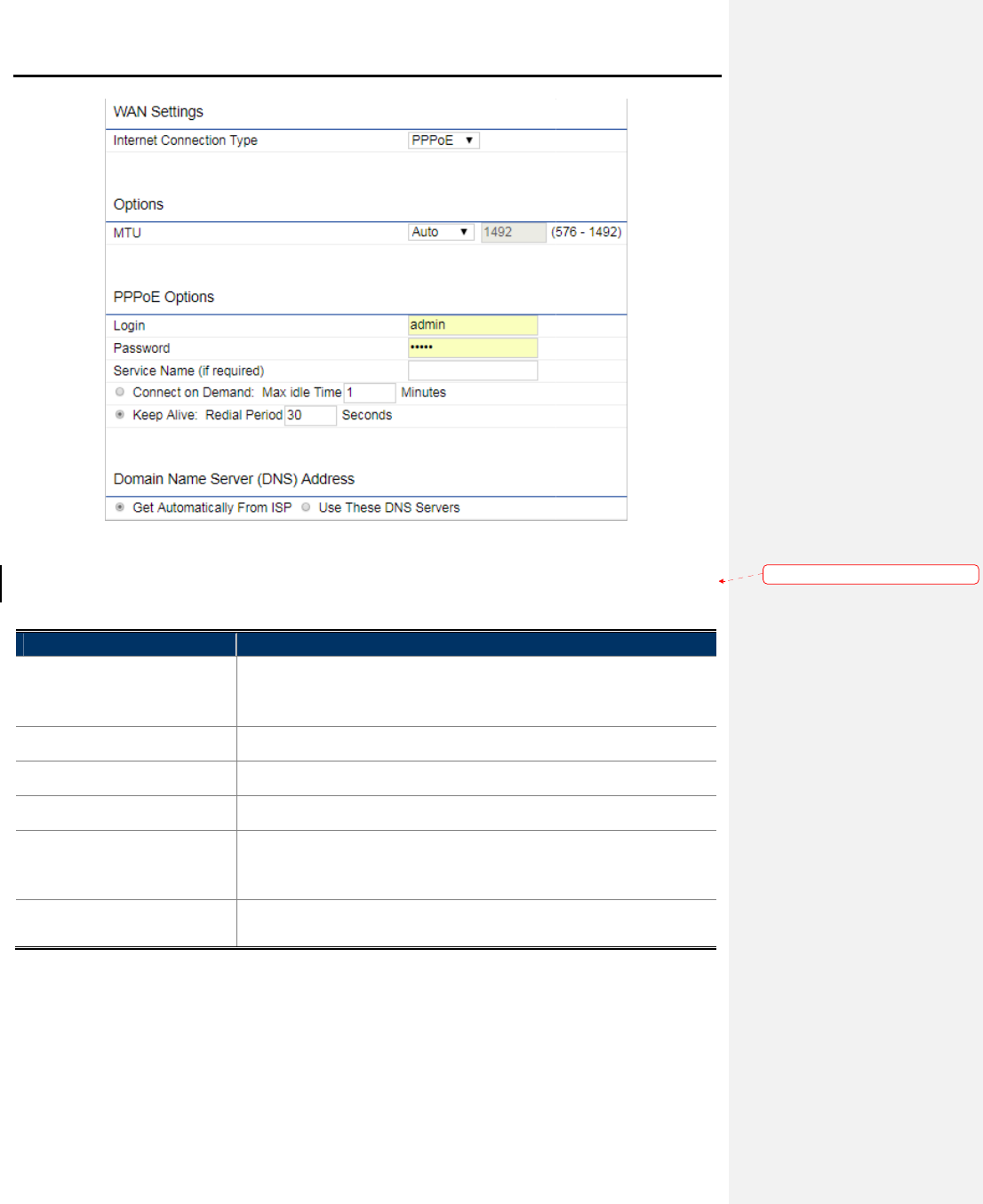
The page includes the following specific settings in PPPoE type
Object
Description
• MTU
The
permitted for an
PPPoE
• Login
Enter the username
• Password
Enter the password
• Service Name (if required)
Enter the service name of an ISP
• Connect on Demand
Select
disconnect when it reach
automatically connect when user tries to access the network.
• Keep Alive
Select whether to keep the Internet connection always on, or enter a
redial period once the internet loses connection.
User
Manual of
-37-
Figure 4-16 WAN Settings – PPPOE
The page includes the following specific settings in PPPoE type
:
Description
The
maximum transmission unit (MTU)
specifies the largest packet size
permitted for an
internet transmission. The factory default MTU size
PPPoE
is 1492. The MTU size can be set
between 576 and
Enter the username
provided by ISP.
Enter the password
provided by ISP.
Enter the service name of an ISP
(optional).
Select
it to
specify the maximum idle time. Internet connection
disconnect when it reach
es the maximum idle
time, but it
automatically connect when user tries to access the network.
Select whether to keep the Internet connection always on, or enter a
redial period once the internet loses connection.
Manual of
WBS-502AC
specifies the largest packet size
internet transmission. The factory default MTU size
for
between 576 and
1492.
specify the maximum idle time. Internet connection
will
time, but it
will
automatically connect when user tries to access the network.
Select whether to keep the Internet connection always on, or enter a
格式化: 間距 套
用前:
用前:
0.5 行
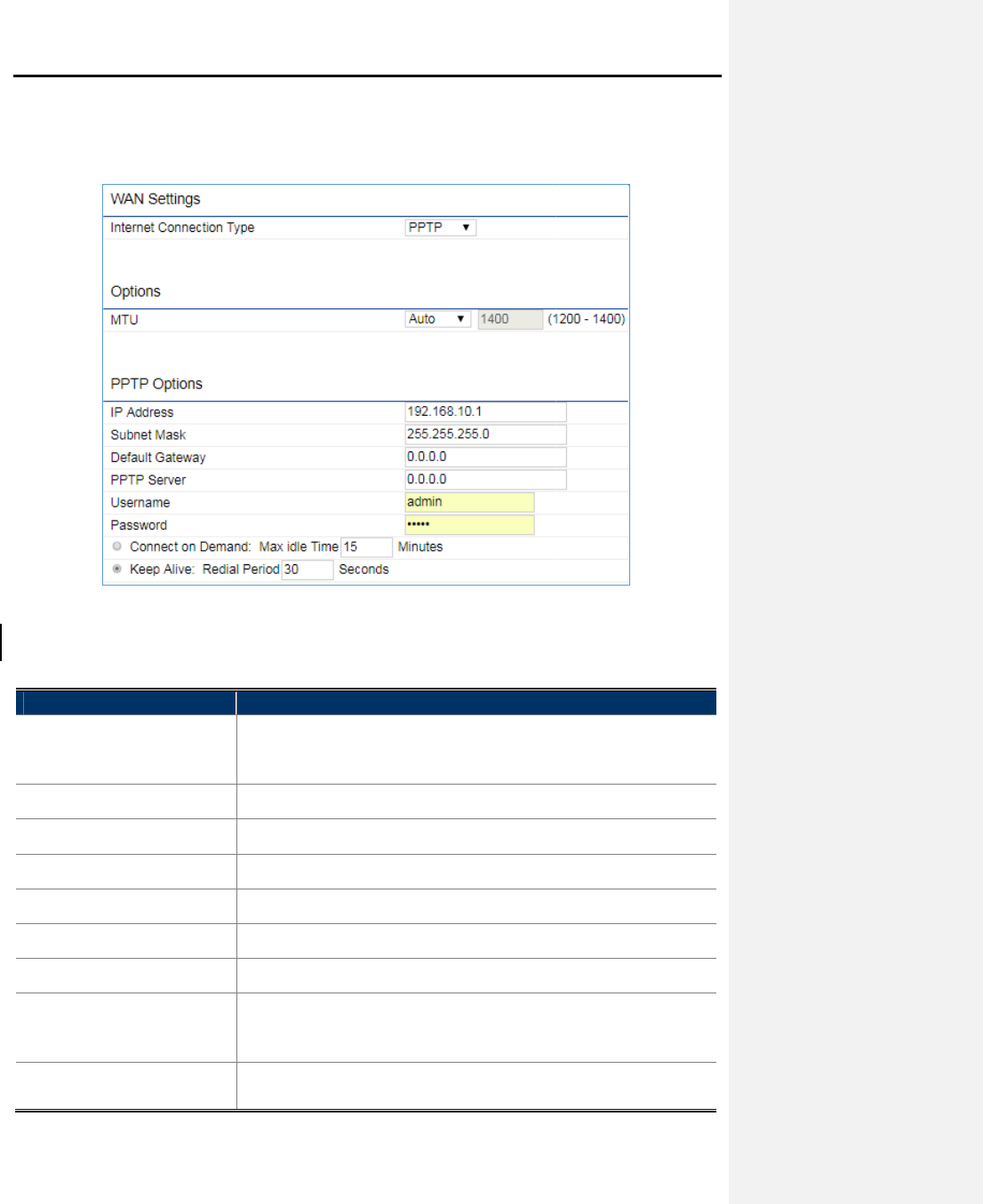
4.4.2.4.
PPTP
Select PPTP if ISP is using a PPTP
connection
The page includes the following specific settings in PPTP type
Object
Description
• MTU
The maximum transmission unit (MTU)
permitted for an
PPTP
• IP Address
Enter the
• Subnet Mask
Enter the
• Default Gateway
Enter the
• PPTP Server
Enter the IP address of the PPTP
• Username
Enter the username
• Password
Enter the password
• Connect on Demand
Select
disconnect when it reach
automatically connect when user tries to access the network.
• Keep Alive
Select whether to keep the Internet connection always on, or enter a
redial
User
Manual of
-38-
connection
.
Figure 4-17 WAN Settings – PPTP
The page includes the following specific settings in PPTP type
:
Description
The maximum transmission unit (MTU)
specifies the largest packet size
permitted for an
internet transmission. The factory default MTU size
PPTP
is 1400. The MTU size can be set
between
Enter the
device’s WAN IP address
provided by ISP
Enter the
device’s WAN IP
subnet mask provided by ISP
Enter the
device’s WAN Gateway IP
provided by ISP
Enter the IP address of the PPTP
server.
Enter the username
provided by ISP.
Enter the password
provided by ISP.
Select
it to specify the
maximum idle time. Internet connection
disconnect when it reach
es the maximum idle
time, but it will
automatically connect when user tries to access the network.
Select whether to keep the Internet connection always on, or enter a
redial
period once the internet loses connection.
Manual of
WBS-502AC
specifies the largest packet size
internet transmission. The factory default MTU size
for
between
1200 and 1400.
provided by ISP
.
subnet mask provided by ISP
.
provided by ISP
.
maximum idle time. Internet connection
will
time, but it will
automatically connect when user tries to access the network.
Select whether to keep the Internet connection always on, or enter a
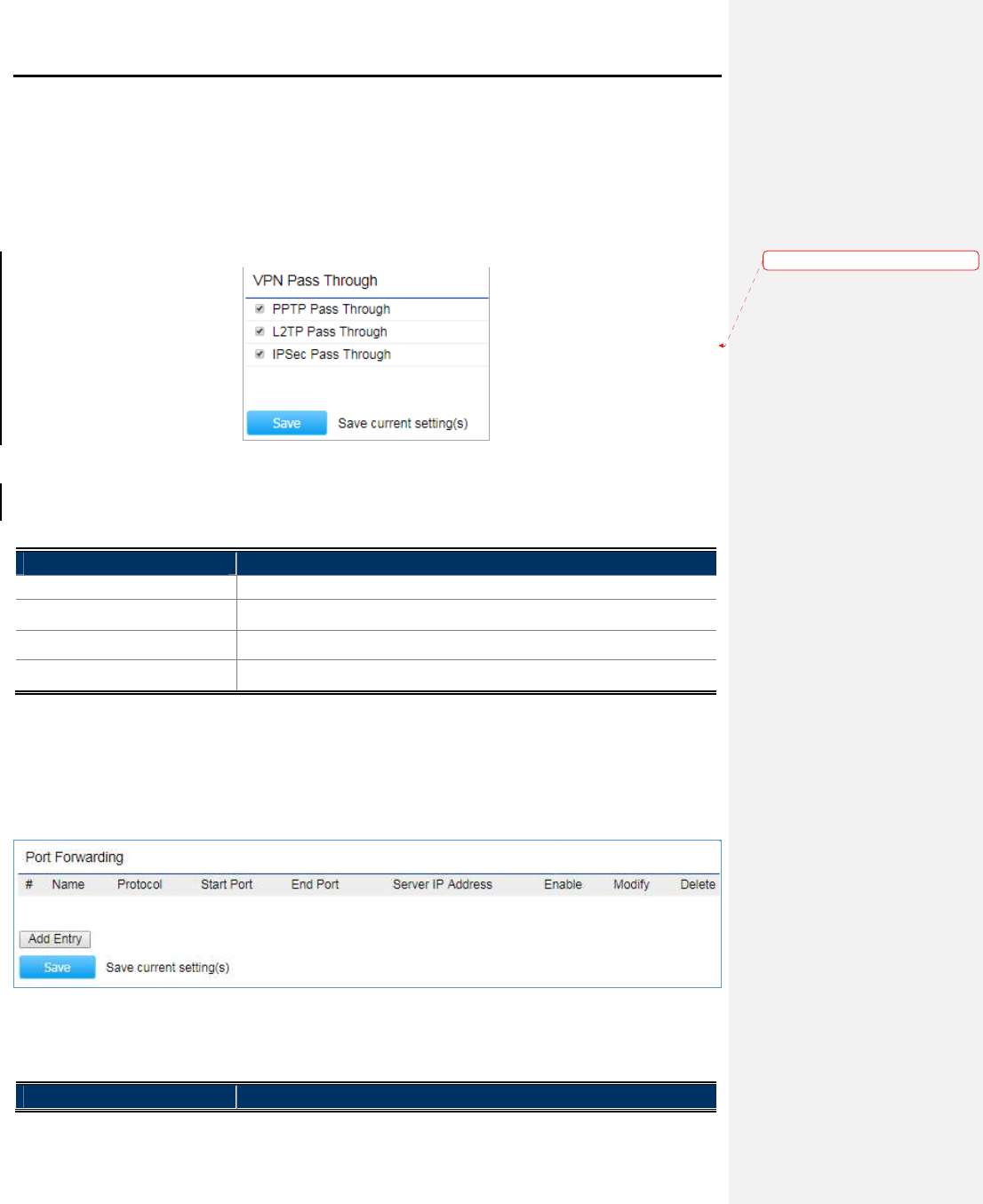
4.4.3 VPN Passthrough
VPN Passthrough allows a secure virtual private network (VPN) connection between two
options on this
page opens a VPN port and enables connections to pass through the
Go to the “Network Wireless”
page to configure the device as
Through”
to enable VPN passthrough you required in
The page includes the following settings
Object
Description
• PPTP Passthrough
Check this option to enable PPTP pass
• L2TP Passthrough
Check this option to enable
• IPSec Passthrough
Check this option to enable
• Save
Click
4.4.4 Port Forwarding
Go to the “Network Wireless”
page to configure the device as
Forwarding” to
configure the port forwarding
The page includes the following settings
Object
Description
User
Manual of
-39-
VPN Passthrough allows a secure virtual private network (VPN) connection between two
page opens a VPN port and enables connections to pass through the
AP
page to configure the device as
“WISP” and then
go to
to enable VPN passthrough you required in
WISP mode.
Figure 4-18 VPN Passthrough
The page includes the following settings
:
Description
Check this option to enable PPTP pass
-
through mode.
Check this option to enable
L2TP pass-
through mode.
Check this option to enable
IPSec pass-
through mode.
Click
Save to save the setting.
page to configure the device as
“WISP”
and the
configure the port forwarding
rule.
Figure 4-19 Port Forwarding
The page includes the following settings
:
Description
Manual of
WBS-502AC
VPN Passthrough allows a secure virtual private network (VPN) connection between two
sites. Enabling the
AP
without interruption.
go to
“Router VPN Pass
through mode.
through mode.
through mode.
and the
n go to “Router Port
格式化: 間距 套
用前:
用前:
0.5 行
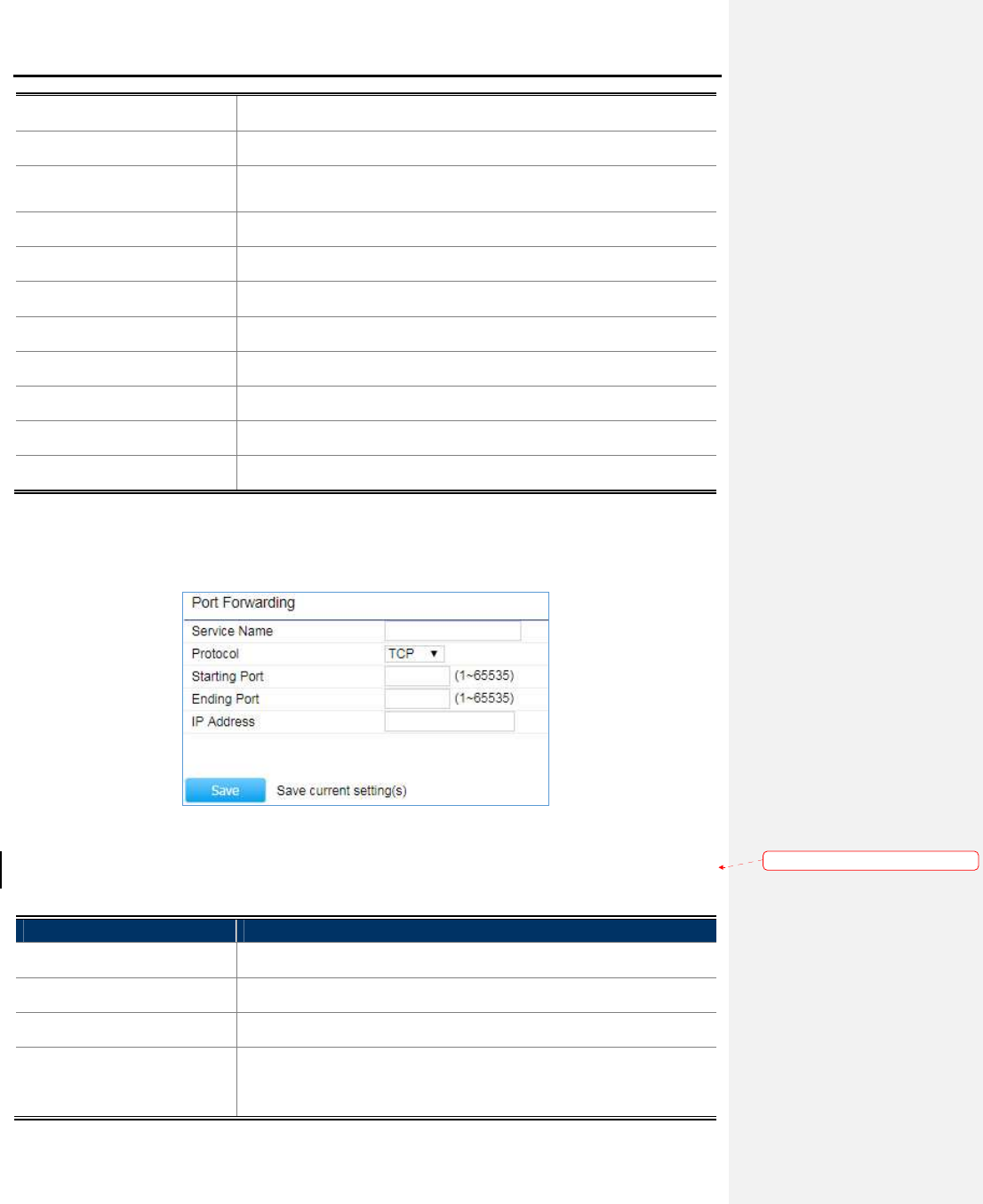
User Manual of WBS-502AC
-40-
• # Displays the sequence number of the forwarded port.
• Name Displays the name of the forwarded port.
• Protocol Displays the protocol to use for mapping from the following: TCP, UDP or
Both.
• Start Port Displays the LAN port number that WAN client packets will be forward to.
• End Port Displays the port number that the WAN client packets are received.
• Server IP Address Displays the IP address of the server for the forwarded port.
• Enable Click to enable or disable the forwarded port profile.
• Modify Click to modify the forwarded port profile.
• Delete Click to delete the forwarded port profile.
• Add Entry Click Add Entry to add the new forwarding rule.
• Save Click Save to save the setting.
When clicking Add Entry, the following window pops up and fill in the fields required to add a new forwarding
rule.
Figure 4-20 Port Forwarding
The page includes the following settings:
Object Description
• Service Name Enter a name for the port forwarding rule.
• Protocol Select a protocol for the application: Choices are TCP or UDP, or both.
• Starting Port (1~65535) Enter a starting port number.
• Ending Port (1~65535)
Enter an ending port number.
All ports numbers between the starting and ending ports will forward
users to the IP address specified in the IP Address field.
格式化: 間距 套用前: 0.5 行

• IP Address
Enter the
users will be redirected.
• Save
Click
4.4.5 DMZ Settings
The DMZ function allows the device to redirect all packets
address on the LAN. The difference between the virtual server and the DMZ function
redirects a particular service or Internet application, such as FTP, to a particular LAN client or server,
DMZ redirects all
packets, regardless of the service, going to the WAN IP address to a particular LAN client or
server.
Go to the “Network Wireless”
page to configure the device as
Settings” to enable/configure DMZ.
The page includes the following settings
Object
Description
• DMZ Hosting
Select Enable DMZ to activate DMZ functionality.
• DMZ Address
Enter an IP address of a device on the LAN.
• Save
Click
4.4.6
Dos Protection
The DoS Protection function
can protect the device from
ping attack.
Go to the “Network Wireless”
page to configure the device as
Protection” to enable
DoS protection
User
Manual of
-41-
Enter the
IP address of the server computer on the LAN network where
users will be redirected.
Click
Save to save the new forwarding rule.
The DMZ function allows the device to redirect all packets
going to the WAN port IP address to a
address on the LAN. The difference between the virtual server and the DMZ function
redirects a particular service or Internet application, such as FTP, to a particular LAN client or server,
packets, regardless of the service, going to the WAN IP address to a particular LAN client or
page to configure the device as
“WISP”
and the
Figure 4-21 DMZ
The page includes the following settings
:
Description
Select Enable DMZ to activate DMZ functionality.
Enter an IP address of a device on the LAN.
Click
Save to save the setting.
can protect the device from
being attacked by TCP-
SYN Flood, UDP Flood
page to configure the device as
“WISP” and then
go to
DoS protection
.
Manual of
WBS-502AC
IP address of the server computer on the LAN network where
going to the WAN port IP address to a
particular IP
address on the LAN. The difference between the virtual server and the DMZ function
is that a virtual server
redirects a particular service or Internet application, such as FTP, to a particular LAN client or server,
whereas a
packets, regardless of the service, going to the WAN IP address to a particular LAN client or
and the
n go to “Router DMZ
SYN Flood, UDP Flood
and
go to
“Management Dos
格式化: 間距 套
用前:
用前:
0.5 行
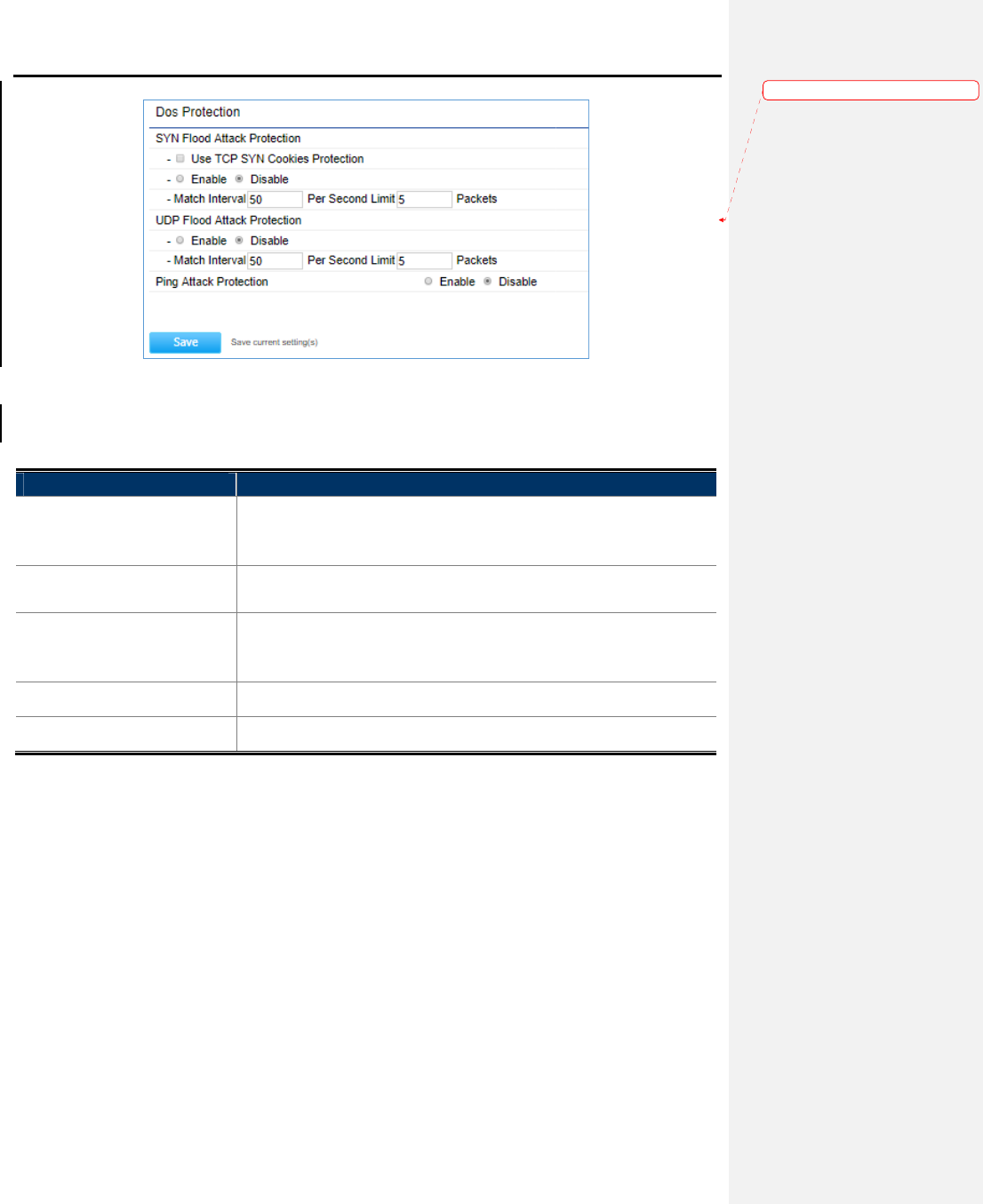
The page includes the following settings
Object
Description
• SYN Flood Attack
Protection
Enter a value between
Packets numbers is beyond the set value, the Router will start
blocking function immediately.
• Use TCP SYN Cookies
Protection
Select it to use
• UDP Flood Attack
Protection
Enter a value betwe
number is beyond the set value, the Router will
function immediately.
• Ping Attack Protection
Select Enable
• Save
Click
4.5 Wireless
In this section,
wireless related settings in different operation modes
4.5.1 Wireless Settings
Click “Network Wireless”
to configure the wireless basic settings. The wireless settings
vary according to the selected operation mode.
User
Manual of
-42-
Figure 4-22 DoS Protection
The page includes the following settings
:
Description
Enter a value between
1 ~ 10000. When the
current TCP
Packets numbers is beyond the set value, the Router will start
blocking function immediately.
Select it to use
TCP SYN Cookies Protection.
Enter a value betwe
en 1 ~ 10000
. When the current U
number is beyond the set value, the Router will
start
function immediately.
Select Enable
to ignore/forbid ping packet.
Click
Save to save the setting.
wireless related settings in different operation modes
are provided.
to configure the wireless basic settings. The wireless settings
vary according to the selected operation mode.
Manual of
WBS-502AC
current TCP
-SYN-Flood
Packets numbers is beyond the set value, the Router will start
up the
. When the current U
DP-Flood Packets
start
up the blocking
to configure the wireless basic settings. The wireless settings
on this page may
格式化: 間距 套
用前:
用前:
0.5 行
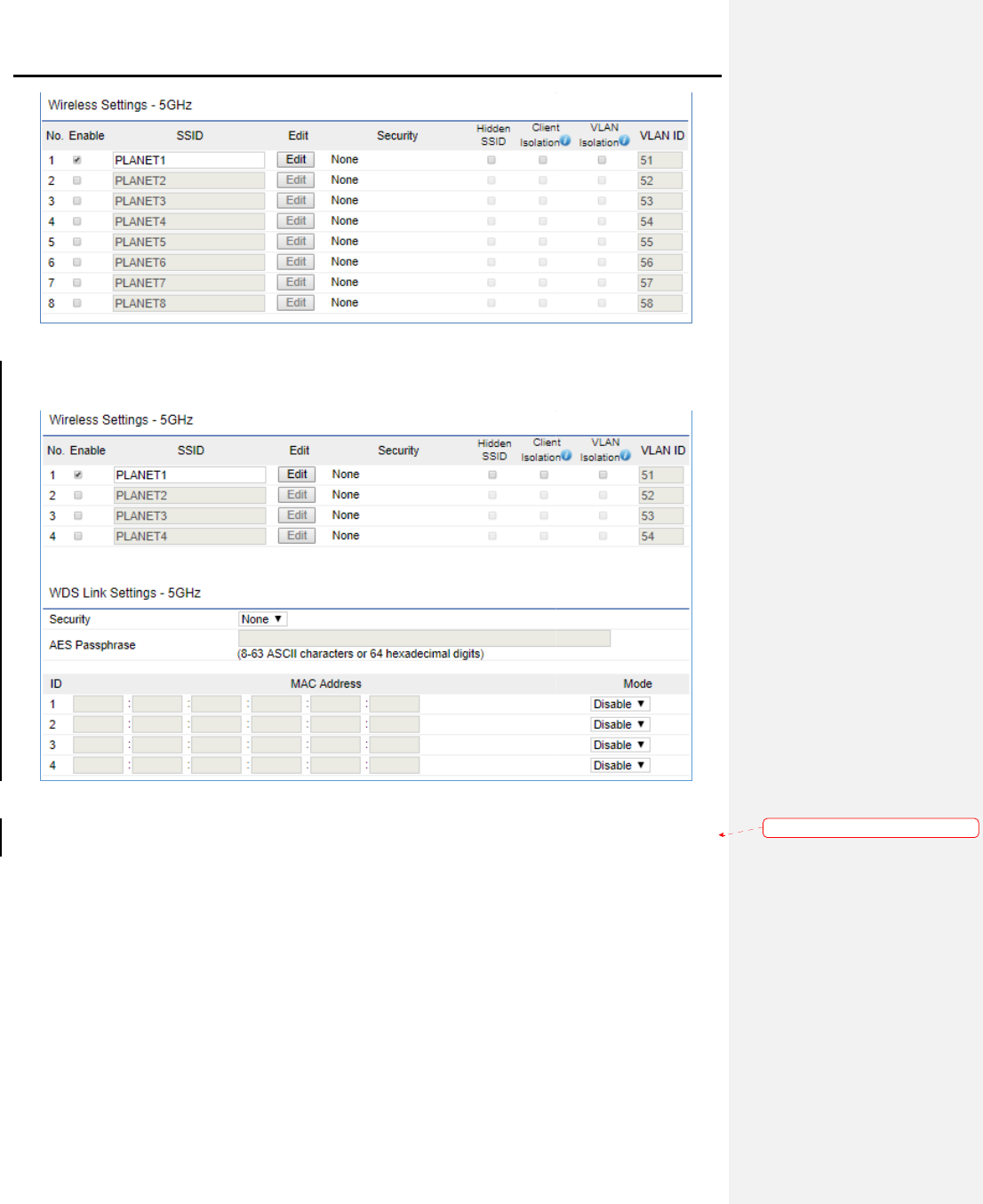
Figure
Figure
In the AP/WDS AP mode, click the
Edit
Profile” page to configure
the SSID profile
wireless network.
User
Manual of
-43-
Figure
4-23 Wireless Settings – AP Mode
Figure
4-24 Wireless Settings – WDS AP Mode
Edit
button on the “Wireless Settings – 5GHz”
section
the SSID profile
includes the wireless security and wireless traffic shaping
Manual of
WBS-502AC
section
to enter the “SSID
includes the wireless security and wireless traffic shaping
for the
格式化: 間距 套
用前:
用前:
0.5 行
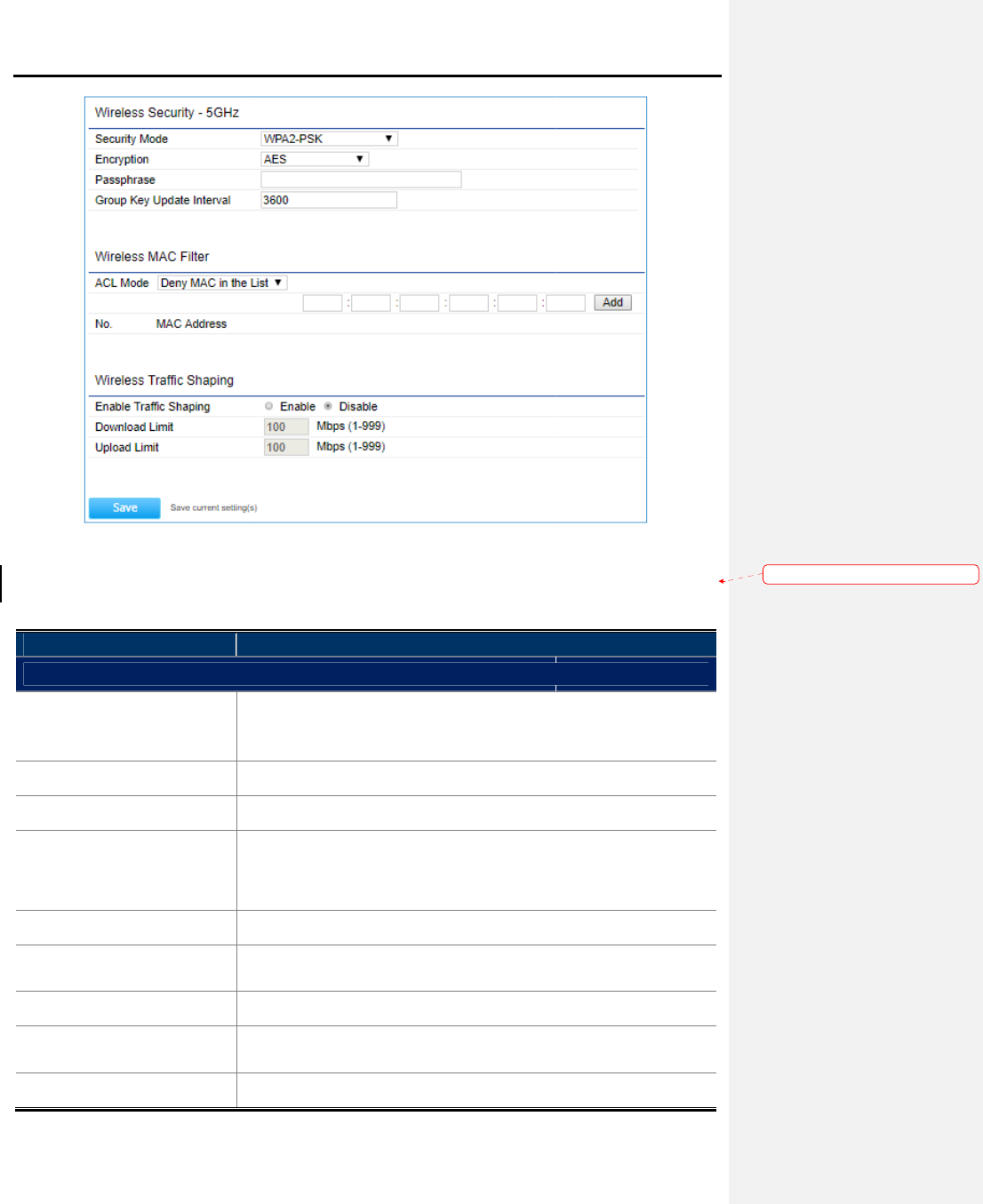
Figure
The
wireless settings of AP or WDS AP mode include
Object
Description
Wireless Settings – 5GHz
• No.
Displays
In the AP mode, up to
In the WDS
• Enable
Click
• SSID
Specify the SSID for the current profile.
• Edit
C
page
wireless traffic shaping
• Security
Displays
• Hidden SSID
Check this option to hide the SSID from
not appear in the site survey.
• Client Isolation
Click this option to prevent
• VLAN Isolation
Enable it to r
the radio button.
• VLAN ID
Specify the VLAN tag for the
User
Manual of
-44-
Figure
4-25 Wireless Profile – AP/WDS AP Mode
wireless settings of AP or WDS AP mode include
the following settings:
Description
Displays
the sequence number of the entries.
In the AP mode, up to
8 SSIDs
can be configured
In the WDS
AP mode, up to 4 SSIDs
can be configured
Click
it to enable the SSID interface.
Specify the SSID for the current profile.
C
lick the Edit button of the selected SSID
to enter the
page
to configure the SSID profile
includes the wireless security and
wireless traffic shaping
for the wireless network.
Displays
the current wireless security of the specific SSID.
Check this option to hide the SSID from
clients. If checked, the SSID will
not appear in the site survey.
Click this option to prevent
communication between client devices.
Enable it to r
estrict clients communicating with different VIDs by selecting
the radio button.
Specify the VLAN tag for the
SSID.
Manual of
WBS-502AC
can be configured
as different VAPs.
can be configured
as different VAPs.
to enter the
“SSID Profile”
includes the wireless security and
the current wireless security of the specific SSID.
clients. If checked, the SSID will
communication between client devices.
estrict clients communicating with different VIDs by selecting
格式化: 間距 套
用前:
用前:
0.5 行
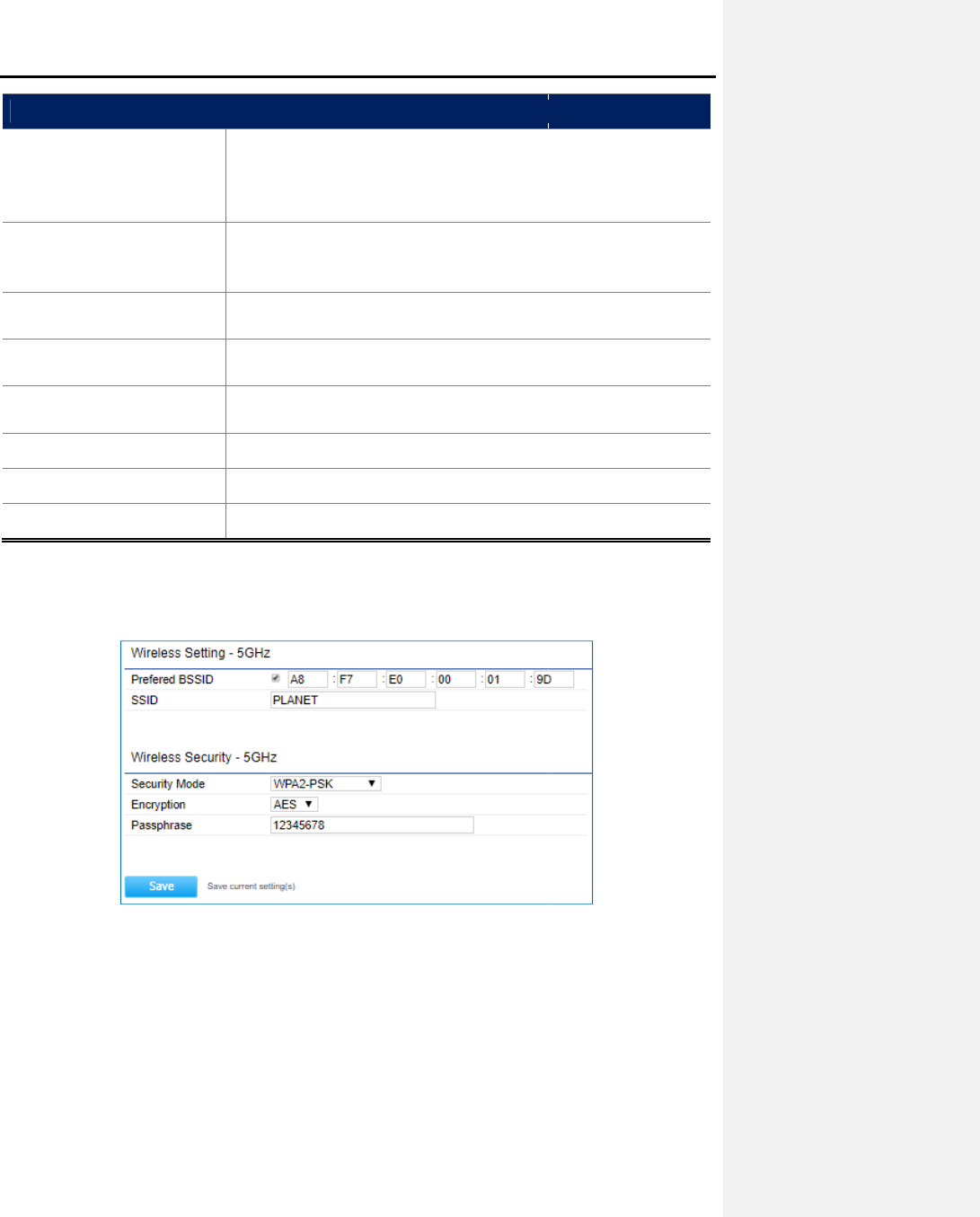
Wireless Profile Settings
(Security, MAC ACL, Wireless Traffic Shaping)
• Security Mode
Select the suitable security mode from the drop
wireless network.
WPA2
WPA2
• ACL Mode
Determines whether network access is granted or denied to clients whose
MAC addresses appear in the MAC Address
option includes
MAC Address
Displays
device.
Add
Enter the
and then c
Enable Traffic Shaping
Enable or disable the regulation of
improved QoS.
• Download Limit
Sp
• Upload Limit
Sp
• Save
Click
In the CB/WDS STA/CR mode, click
Scan
configure the wireless
profile settings as following page.
Figure 4
-
After click Save, the wireless configuration can be observed
User
Manual of
-45-
(Security, MAC ACL, Wireless Traffic Shaping)
Select the suitable security mode from the drop
-
down list to encrypt the
wireless network.
The options include
Disabled, WEP, WPA
WPA2
-PSK, WPA-
PSK Mixed, WPA, WPA2, and WPA Mixed
WPA2
-PSK mode is strongly recommended.
Determines whether network access is granted or denied to clients whose
MAC addresses appear in the MAC Address
table on this page.
option includes
Disable, Deny MAC in the list, or Allow MAC
Displays
the MAC Address that will be
denied/allowed
device.
Enter the
wireless MAC address of the client in front of the
and then c
lick Add to
add the new entry to the MAC filtering list.
Enable or disable the regulation of
packet flow leaving an interface for
improved QoS.
Sp
ecify the wireless transmission
speed used for downloading.
Sp
ecify the wireless transmission
speed used for uploading.
Click
Save to save changes.
Scan
in the “AP Detection” field to
associate to the AP. Then, you can
profile settings as following page.
-
26 Wireless Profile – CB/WDS STA/CR Mode
After click Save, the wireless configuration can be observed
in the
Wireless Settings
Manual of
WBS-502AC
down list to encrypt the
Disabled, WEP, WPA
-PSK,
PSK Mixed, WPA, WPA2, and WPA Mixed
. The latest
Determines whether network access is granted or denied to clients whose
table on this page.
The
Disable, Deny MAC in the list, or Allow MAC
in the list.
denied/allowed
access to this
wireless MAC address of the client in front of the
Add button
add the new entry to the MAC filtering list.
packet flow leaving an interface for
speed used for downloading.
speed used for uploading.
associate to the AP. Then, you can
Wireless Settings
– 5GHz section.

Figure 4-
27
The
page includes the following settings
Object
Description
• Prefer BSSID
Ent
Survey, this
• SSID
Specify the SSID if known. This field is
select an Access
• Security Mode
Select the suitable security mode from the drop
wireless network.
WPA2
WPA2
• No.
Displays
• SSID
Displays
• Edit
C
• Security
Displays
• Save
Click
4.5.2 WDS Link Settings
Go to the “Network Wireless”
page to configure the device as
then you can
configure the WDS link
Figure
User
Manual of
-46-
27
Wireless Settings – CB/WDS STA/CR Mode
page includes the following settings
:
Description
Ent
er the MAC address if known. If
you select an Access Point in the Site
Survey, this
field is completed automatically.
Specify the SSID if known. This field is
completed
select an Access
Point in the Site Survey.
Select the suitable security mode from the drop
-
wireless network.
The options include
Disabled, WEP, WPA
WPA2
-PSK, WPA-
PSK Mixed, WPA, WPA2, and
WPA2
-PSK mode is strongly recommended.
Displays
the sequence number of the entries.
Displays
the SSID for the current profile.
C
lick the Edit button to modify the
wireless security of associated AP.
Displays
the current wireless security of the specific SSID.
Click
Save to save changes.
page to configure the device as
“
WDS Access Point
configure the WDS link
settings.
Figure
4-28 WDS Link Settings – WDS AP Mode
Manual of
WBS-502AC
you select an Access Point in the Site
completed
automatically if you
-
down list to encrypt the
Disabled, WEP, WPA
-PSK,
PSK Mixed, WPA, WPA2, and
WPA Mixed. The latest
wireless security of associated AP.
the current wireless security of the specific SSID.
WDS Access Point
” or “WDS Bridge” and
格式化: 間距 套
用前:
格式化: 間距 套
用前:
用前:
0.5 行
用前:
0.5 行
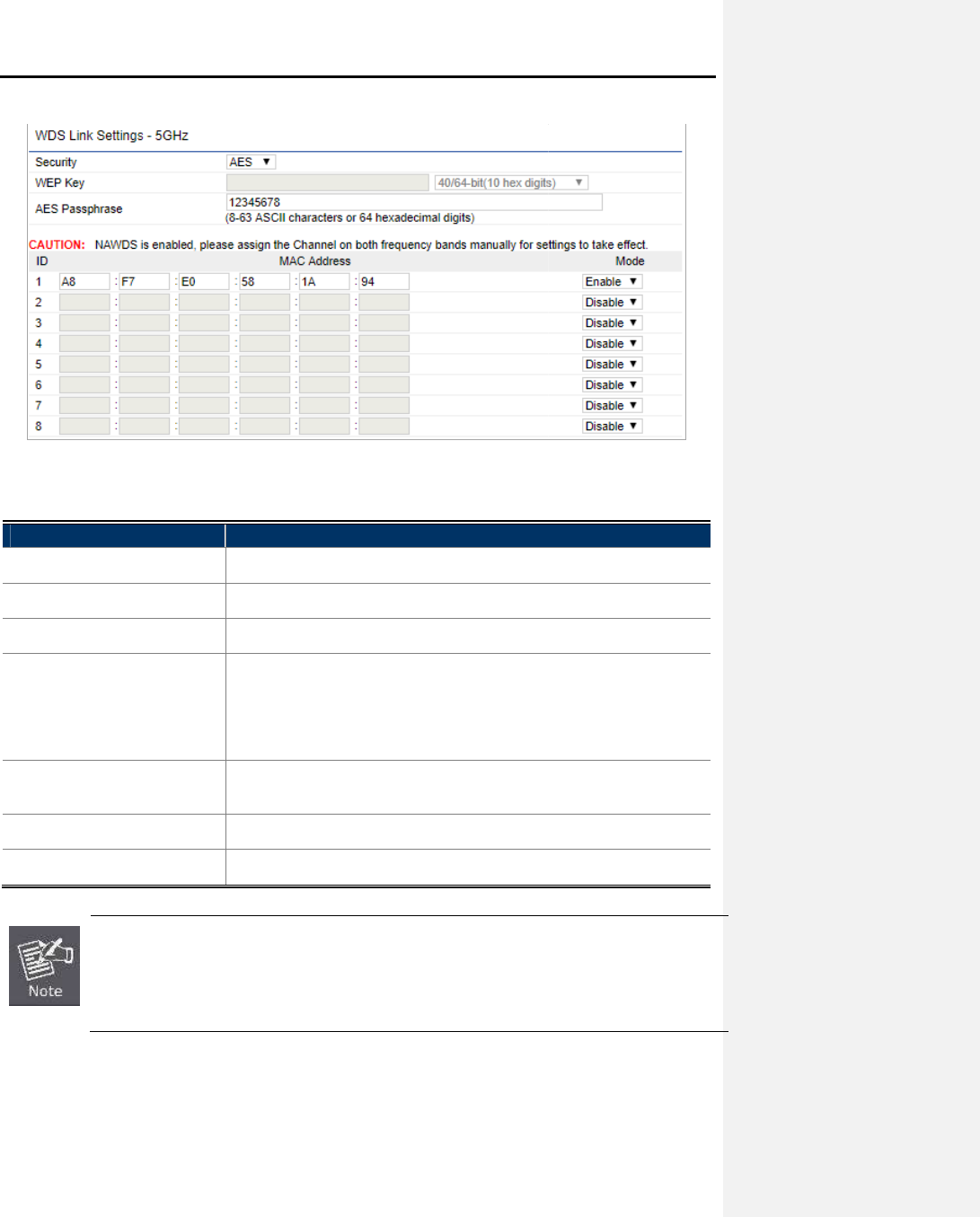
Figure
4
The page includes the following settings
Object
Description
• Security
Select the type of WDS
• WEP Key
Enter the WEP key if security
• AES Passphrase
Enter the AES
• ID
Displays
In
In the WDS Bridge mode, up to 8 nodes can be configured to use WDS
link.
• MAC Address
Enter the
wireless connectivity.
• Mode
Select Disable or Enable to
• Save
Click
NOTE:
1.
The WDS link settings is only available in
through wireless MAC address each other by using non
compatible with other brand
2.
The security setting in each site of WDS link must be
3.
The wireless channel must be fixed and must be the same in each site of WDS link.
4.5.3 Security Settings
Go to the “Network Wireless”
page to configure the
User
Manual of
-47-
4
-29 WDS Link Settings – WDS Bridge Mode
The page includes the following settings
:
Description
Select the type of WDS
security: None, WEP, or AES.
Enter the WEP key if security
is selected
as WEP.
Enter the AES
passphrase if security is selected
as
Displays
the sequence number of the entries.
In
the WDS AP mode, up to 4 nodes can be configured to use WDS link.
In the WDS Bridge mode, up to 8 nodes can be configured to use WDS
link.
Enter the
wireless MAC address of the AP
to which you want to
wireless connectivity.
Select Disable or Enable to
disable or enable WDS.
Click
Save to save changes.
The WDS link settings is only available in
WDS AP or
WDS Bridge mode and
through wireless MAC address each other by using non
-
standard protocol which may not
compatible with other brand
s or models
. Use the same model for full compatibility
The security setting in each site of WDS link must be
the same.
The wireless channel must be fixed and must be the same in each site of WDS link.
page to configure the
security settings.
Manual of
WBS-502AC
security: None, WEP, or AES.
as WEP.
as
AES.
the WDS AP mode, up to 4 nodes can be configured to use WDS link.
In the WDS Bridge mode, up to 8 nodes can be configured to use WDS
to which you want to
extend
disable or enable WDS.
WDS Bridge mode and
is communicating
standard protocol which may not
be
. Use the same model for full compatibility
as required.
The wireless channel must be fixed and must be the same in each site of WDS link.
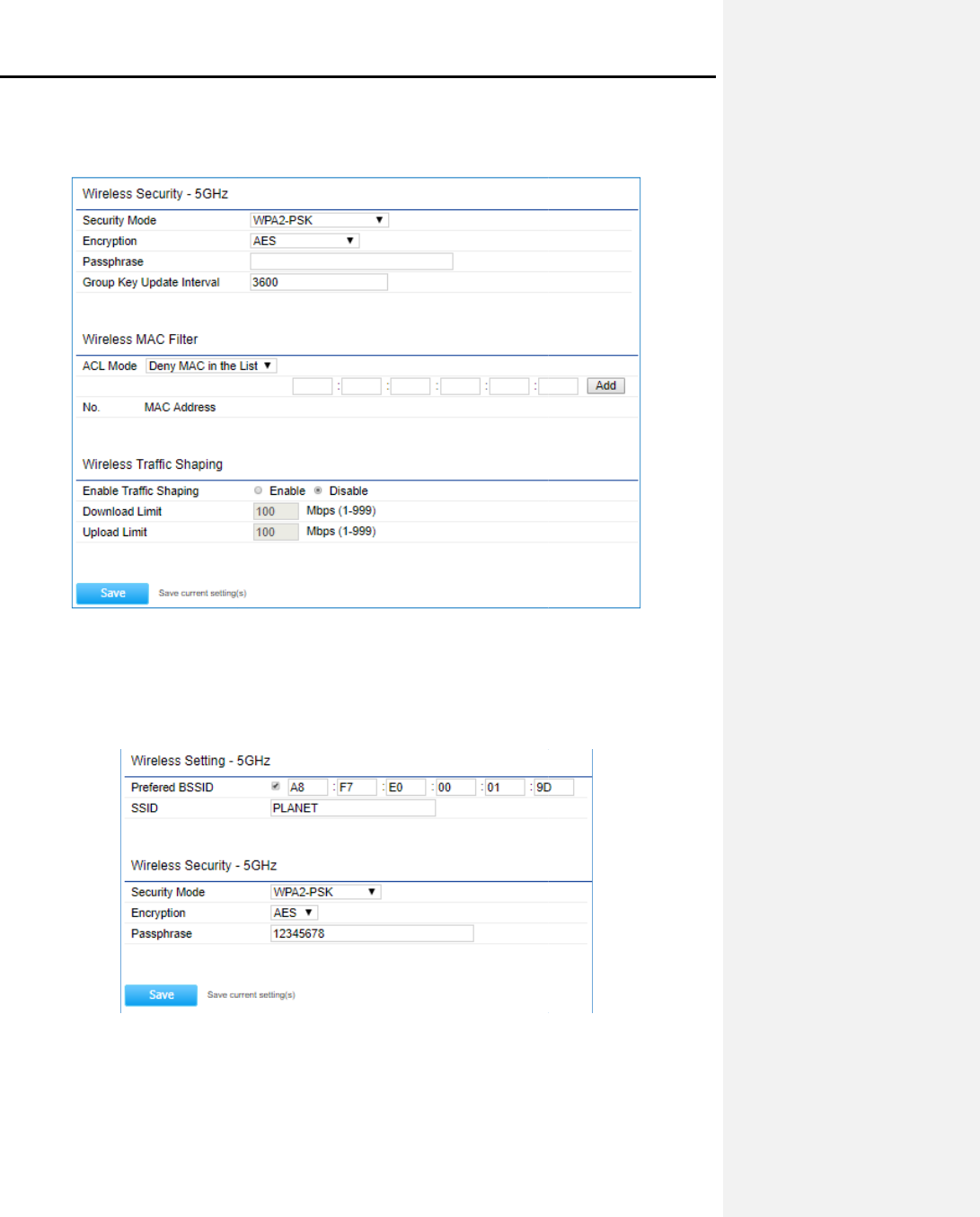
In the AP/WDS AP mode, click the
Edit
Profile”
page and configure the wireless security for the wireless network.
Figure
In the CB/WDS STA/CR mode, click
Edit
wireless security of the associated
AP
Figure 4
-
In the WDS AP or WDS Bridge
mode,
the WDS security
settings. The security settings in each site of the WDS link must be configured to the same.
User
Manual of
-48-
Edit
button in the “Wireless Settings – 5GHz”
section
page and configure the wireless security for the wireless network.
Figure
4-30 Security Settings – AP/WDS AP Mode
Edit
button in the “Wireless Settings – 5GHz”
section
AP
.
-
31 Security Settings – CB/WDS STA/CR Mode
mode,
select Security in the “WDS Link Settings –
5GHz
settings. The security settings in each site of the WDS link must be configured to the same.
Manual of
WBS-502AC
section
to enter the “SSID
section
to modify the
5GHz
” section to configure
settings. The security settings in each site of the WDS link must be configured to the same.
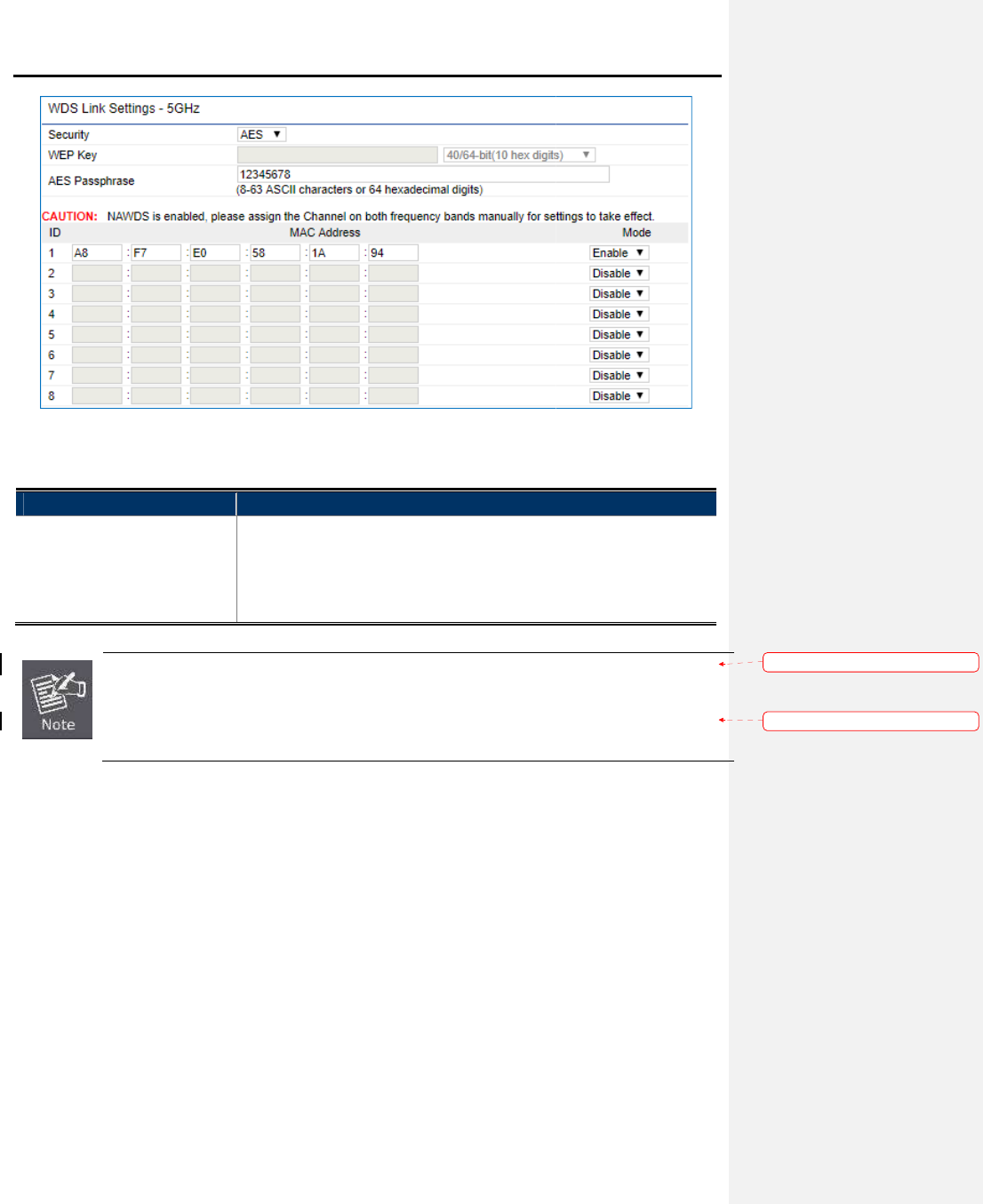
Figure
The option includes the following settings
Object
Description
• Security Mode
Select the suitable security mode from the drop
wireless network.
WPA2
WPA2
1.
The WEP and WPA/WPA2 with TKIP d
are not
available in
2. In the 802.11
AC/N or 802.11A/N
WPA/WPA2 with TKIP, the connection mode/speed will be changed to 802.11a.
Disabled
Authentication is disabled and no password/key is required to connect to the access point.
WEP
WEP (Wired Equivalent Privacy) is a
encryption.
User
Manual of
-49-
Figure
4-32 Security Settings – WDS Bridge Mode
The option includes the following settings
:
Description
Select the suitable security mode from the drop
-
wireless network.
The options include
Disabled, WEP, WPA
WPA2
-PSK, WPA-
PSK Mixed, WPA, WPA2, and
WPA2
-PSK mode is strongly recommended.
The WEP and WPA/WPA2 with TKIP d
oes not support in the
802.11n mode and these options
available in
the 802.11n mode.
AC/N or 802.11A/N
mixed mode, if the security
is configured
WPA/WPA2 with TKIP, the connection mode/speed will be changed to 802.11a.
Authentication is disabled and no password/key is required to connect to the access point.
WEP (Wired Equivalent Privacy) is a
basic encryption. For a higher
level of security consider using
Manual of
WBS-502AC
-
down list to encrypt the
Disabled, WEP, WPA
-PSK,
PSK Mixed, WPA, WPA2, and
WPA Mixed. The latest
802.11n mode and these options
is configured
to WEP and
WPA/WPA2 with TKIP, the connection mode/speed will be changed to 802.11a.
Authentication is disabled and no password/key is required to connect to the access point.
level of security consider using
the WPA
格式化: 間距 套
用前:
格式化: 間距 套
用後:
用前:
0.25 行
用後:
0.5 行
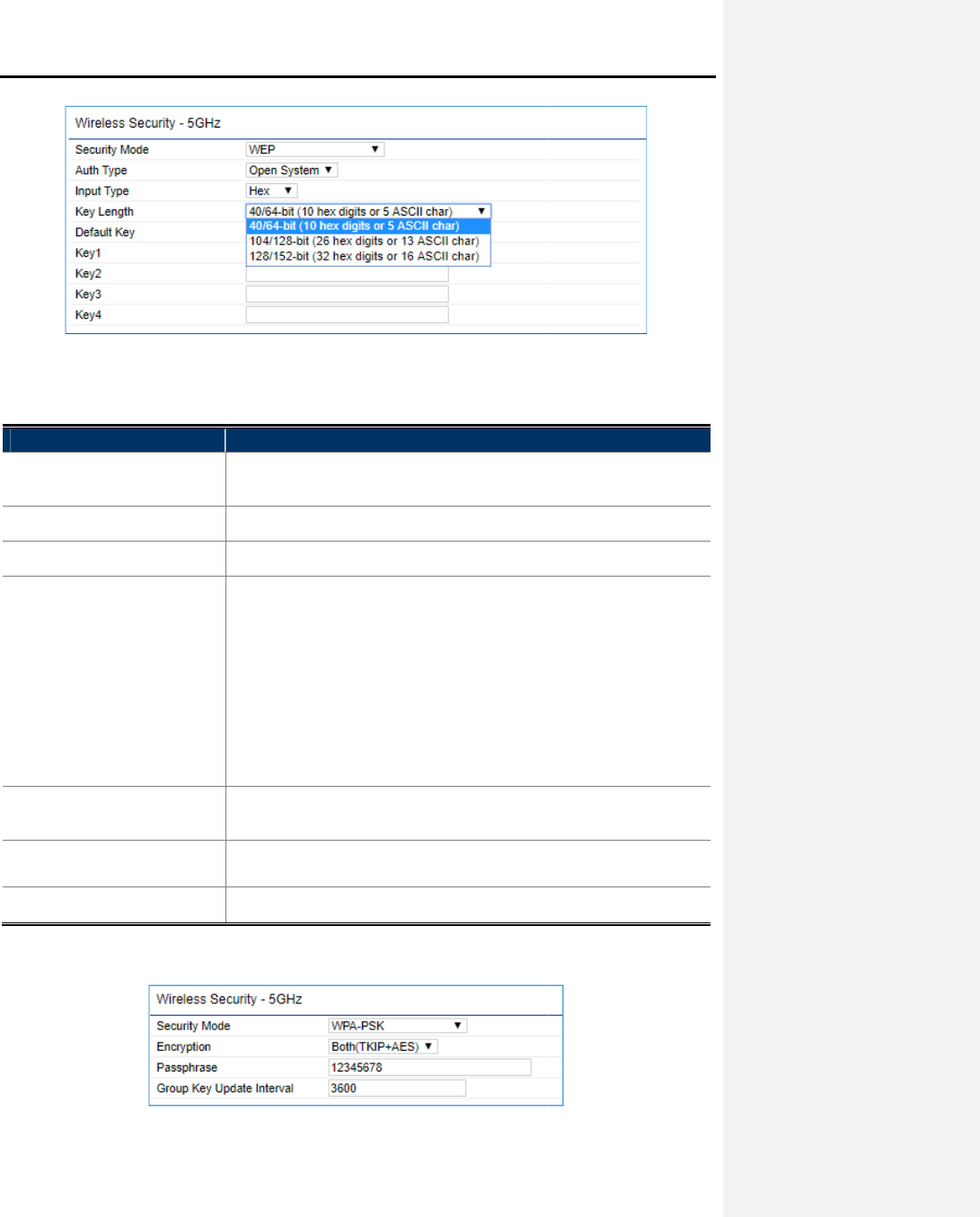
Figure
The security mode includes the following settings
Object
Description
• Security Mode
Select
using WEP encryption method.
• Auth Type
Select Open System or Shared.
• Input Type
Select an input type of Hex or ASCII.
• Key Length
Level of WEP encryption
Select a 64
• Default Key
Select 1
default.
• Key1 – Key4
Specify a password for the security key index. For
character is masked by a dot.
• Save
Click
WPA-PSK
Figure
User
Manual of
-50-
Figure 4-33 Security Settings – WEP
The security mode includes the following settings
:
Description
Select
WEP from the drop-down list to
configure the wireless network
using WEP encryption method.
Select Open System or Shared.
Select an input type of Hex or ASCII.
Level of WEP encryption
is
applied to all WEP keys.
Select a 64
-/128-/152-bit password length.
40/64-bit:
enter 10 hexadecimal digits (any combination of 0
A-
F and null key is not permitted) or 5 ASCII characters.
104/128-bit: enter 26
hexadecimal digits (any combination of 0
a-f, A-F and null key is not permitted) or 13
ASCII characters.
128/152-bit: enter 32
hexadecimal digits (any combination of 0
a-f, A-F and null key is not permitted) or 16
ASCII characters.
Select 1
–
4 to specify which of the four WEP keys the device
default.
Specify a password for the security key index. For
character is masked by a dot.
Click
Save to save the settings.
Figure
4-34 Security Settings – WPA-PSK
Manual of
WBS-502AC
configure the wireless network
applied to all WEP keys.
enter 10 hexadecimal digits (any combination of 0
-9, a-f,
F and null key is not permitted) or 5 ASCII characters.
hexadecimal digits (any combination of 0
-9,
ASCII characters.
hexadecimal digits (any combination of 0
-9,
ASCII characters.
4 to specify which of the four WEP keys the device
uses as its
Specify a password for the security key index. For
security, each typed
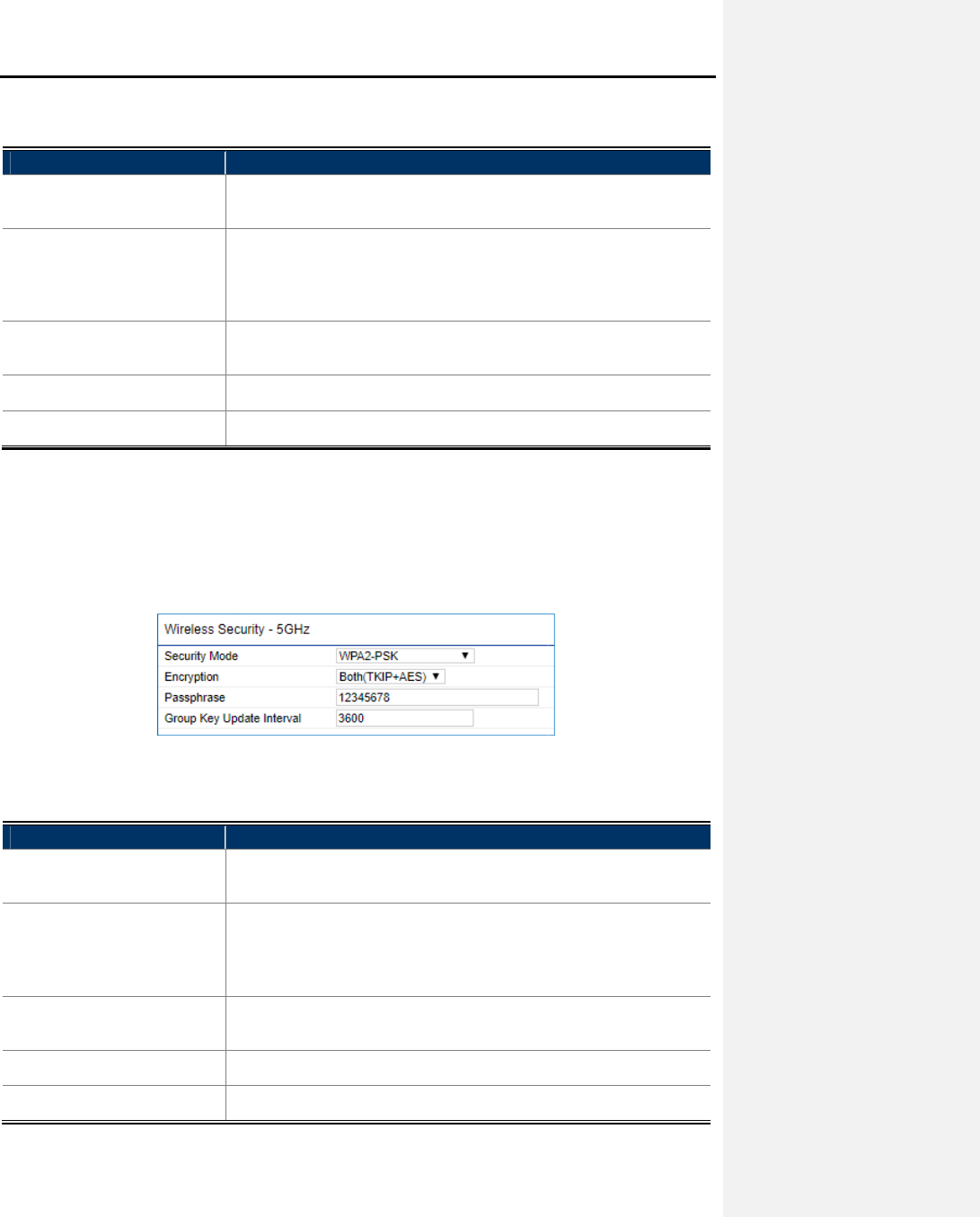
The security mode includes the following settings
Object
Description
• Security Mode
Select WPA
network using WPA
• Encryption
Select TKIP
• Passphrase
Specify the
masked by a dot.
• Group Key Update Interval
Specify how often, in seconds, the group key changes.
• Save
Click
WPA2-PSK
The latest
WPA2 protocol features compliance with the full IEEE 802.11i standard and uses Advanced
Encryption Standard (AES) in addition to TKIP encryption protocol to guarantee better security than that
provided by WEP or WPA.
Figure
The security mode includes the following settings
Object
Description
• Security Mode
Select WPA2
network using WPA2
• Encryption
Select TKIP or AES
• Passphrase
Specify the security password.
masked by a dot.
• Group Key Update Interval
Specify how often, in seconds, the group key changes.
• Save
Click
User
Manual of
-51-
The security mode includes the following settings
:
Description
Select WPA
-PSK from the drop-
down list to configure the wireless
network using WPA
-PSK encryption method.
Select TKIP
or AES, or both
as the encryption type.
Both: uses TKIP and AES.
TKIP: automatic encryption with WPA-
PSK; requires passphrase.
AES: automatic encryption with WPA2-
PSK; requires
Specify the
security password. For security, each typed character is
masked by a dot.
Specify how often, in seconds, the group key changes.
Click
Save to save the settings.
WPA2 protocol features compliance with the full IEEE 802.11i standard and uses Advanced
Encryption Standard (AES) in addition to TKIP encryption protocol to guarantee better security than that
Figure
4-35 Security Settings – WPA2-PSK
The security mode includes the following settings
:
Description
Select WPA2
-PSK from the drop-
down list to configure the wireless
network using WPA2
-PSK encryption method.
Select TKIP or AES
, or both
as the encryption type.
Both: uses TKIP and AES.
TKIP: automatic encryption with WPA-
PSK; requires passphrase.
AES: automatic encryption with WPA2-
PSK; requires
Specify the security password.
For security, each typed character is
masked by a dot.
Specify how often, in seconds, the group key changes.
Click
Save to save the settings.
Manual of
WBS-502AC
down list to configure the wireless
as the encryption type.
PSK; requires passphrase.
PSK; requires
passphrase.
security password. For security, each typed character is
Specify how often, in seconds, the group key changes.
WPA2 protocol features compliance with the full IEEE 802.11i standard and uses Advanced
Encryption Standard (AES) in addition to TKIP encryption protocol to guarantee better security than that
down list to configure the wireless
as the encryption type.
PSK; requires passphrase.
PSK; requires
passphrase.
For security, each typed character is
Specify how often, in seconds, the group key changes.
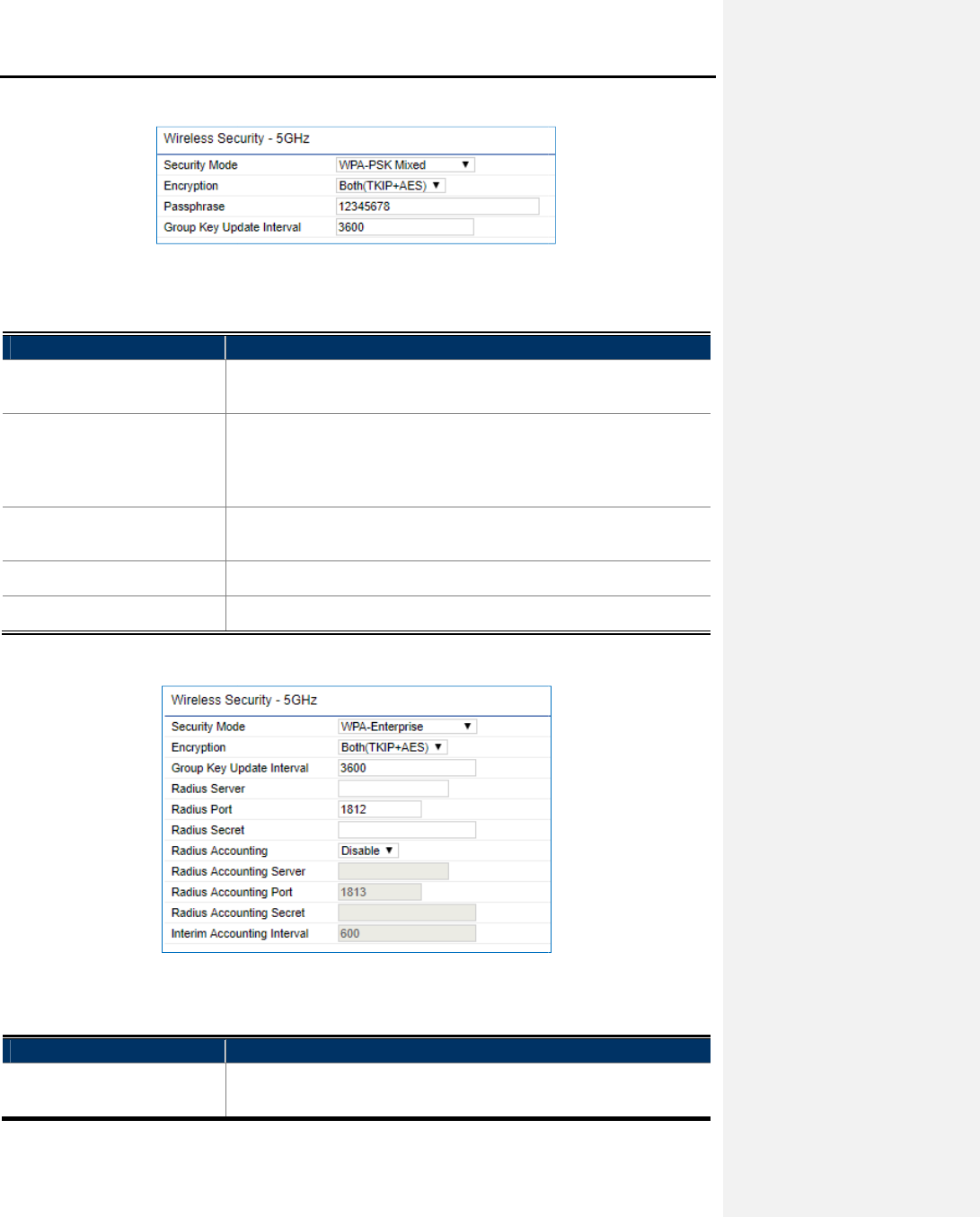
WPA-PSK Mixed
Figure
The security mode includes the following settings
Object
Description
• Security Mode
Select
network using
• Encryption
Select
• Passphrase
Specify the security password. For security, each
masked by a dot.
• Group Key Update Interval
Specify how often, in seconds, the group key changes.
• Save
Click
WPA (WPA Enterprise)
Figure 4
-
The security mode includes the following settings
Object
Description
• Security Mode
Select
using
User
Manual of
-52-
Figure
4-36 Security Settings – WPA-PSK Mixed
The security mode includes the following settings
:
Description
Select
WPA-PSK Mixed from the drop-
down list to configure the wireless
network using
WPA-PSK Mixed
encryption method.
Select
TKIP or AES, or both
as the encryption type.
Both: uses TKIP and AES.
TKIP: automatic encryption with WPA-
PSK; requires passphrase.
AES: automatic encryption with WPA2-
PSK; requires
Specify the security password. For security, each
masked by a dot.
Specify how often, in seconds, the group key changes.
Click
Save to save the settings.
-
37 Security Settings – WPA (WPA Enterprise)
The security mode includes the following settings
:
Description
Select
WPA from the drop-
down list to configure the wireless network
using
WPA encryption method.
Manual of
WBS-502AC
down list to configure the wireless
encryption method.
as the encryption type.
PSK; requires passphrase.
PSK; requires
passphrase.
Specify the security password. For security, each
typed character is
Specify how often, in seconds, the group key changes.
down list to configure the wireless network
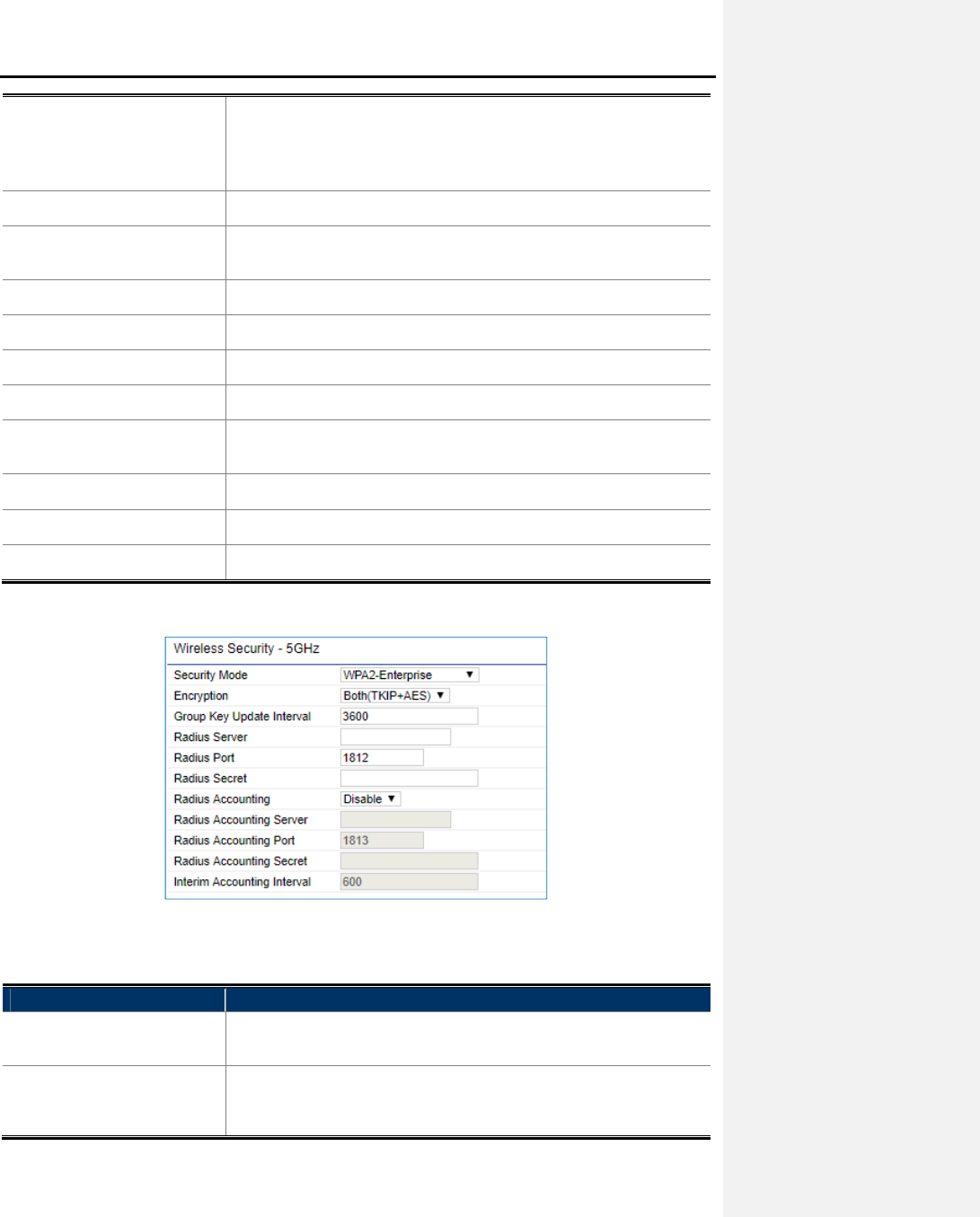
• Encryption
Select
• Radius Server
Specify the IP address of the RADIUS server.
• Radius Port
Specify the port number that your RADIUS server
Default port is 1812.
• Radius Secret
Specify RADIUS secret furnished by the
• Group Key Update Interval
Specify how often, in seconds, the group key changes.
• Radius Accounting
Select to enable or disable RADIUS accounting.
• Radius Accounting Server
Specify the IP address of the RADIUS accounting server.
• Radius Accounting Port
Specify the port number that your RADIUS accounting server uses for
authentication. Default
• Radius Accounting Secret
Specify RADIUS accounting secret furnished by the RADIUS server.
• Interim Accounting Interval
Specify the interim accounting interval (60
• Save
Click
WPA2 (WPA2 Enterprise)
Figure 4-
38
The security mode includes the following settings
Object
Description
• Security Mode
Select
using
• Encryption
Select TKIP or AES
User
Manual of
-53-
Select
TKIP or AES, or both
as the encryption type.
Both: uses TKIP and AES.
TKIP: automatic encryption with WPA-
PSK; requires passphrase.
AES: automatic encryption with WPA2-
PSK; requires
Specify the IP address of the RADIUS server.
Specify the port number that your RADIUS server
Default port is 1812.
Specify RADIUS secret furnished by the
RADIUS server.
Specify how often, in seconds, the group key changes.
Select to enable or disable RADIUS accounting.
Specify the IP address of the RADIUS accounting server.
Specify the port number that your RADIUS accounting server uses for
authentication. Default
port is 1813.
Specify RADIUS accounting secret furnished by the RADIUS server.
Specify the interim accounting interval (60
-
600 seconds).
Click
Save to save the settings.
38
Security Settings – WPA2 (WPA2 Enterprise)
The security mode includes the following settings
:
Description
Select
WPA2 from the drop-
down list to configure the wireless network
using
WPA2 encryption method.
Select TKIP or AES
, or both
as the encryption type.
Both: uses TKIP and AES.
TKIP: automatic encryption with WPA-
PSK; requires passphrase.
Manual of
WBS-502AC
as the encryption type.
PSK; requires passphrase.
PSK; requires
passphrase.
Specify the port number that your RADIUS server
uses for authentication.
RADIUS server.
Specify how often, in seconds, the group key changes.
Specify the IP address of the RADIUS accounting server.
Specify the port number that your RADIUS accounting server uses for
Specify RADIUS accounting secret furnished by the RADIUS server.
600 seconds).
down list to configure the wireless network
as the encryption type.
PSK; requires passphrase.

User Manual of WBS-502AC
-54-
AES: automatic encryption with WPA2-PSK; requires passphrase.
• Radius Server Specify the IP address of the RADIUS server.
• Radius Port Specify the port number that your RADIUS server uses for authentication.
Default port is 1812.
• Radius Secret Specify RADIUS secret furnished by the RADIUS server.
• Group Key Update Interval Specify how often, in seconds, the group key changes.
• Radius Accounting Select to enable or disable RADIUS accounting.
• Radius Accounting Server Specify the IP address of the RADIUS accounting server.
• Radius Accounting Port Specify the port number that your RADIUS accounting server uses for
authentication. Default port is 1813.
• Radius Accounting Secret Specify RADIUS accounting secret furnished by the RADIUS server.
• Interim Accounting Interval
Specify the interim accounting interval (60 - 600 seconds).
• Save Click Save to save the settings.
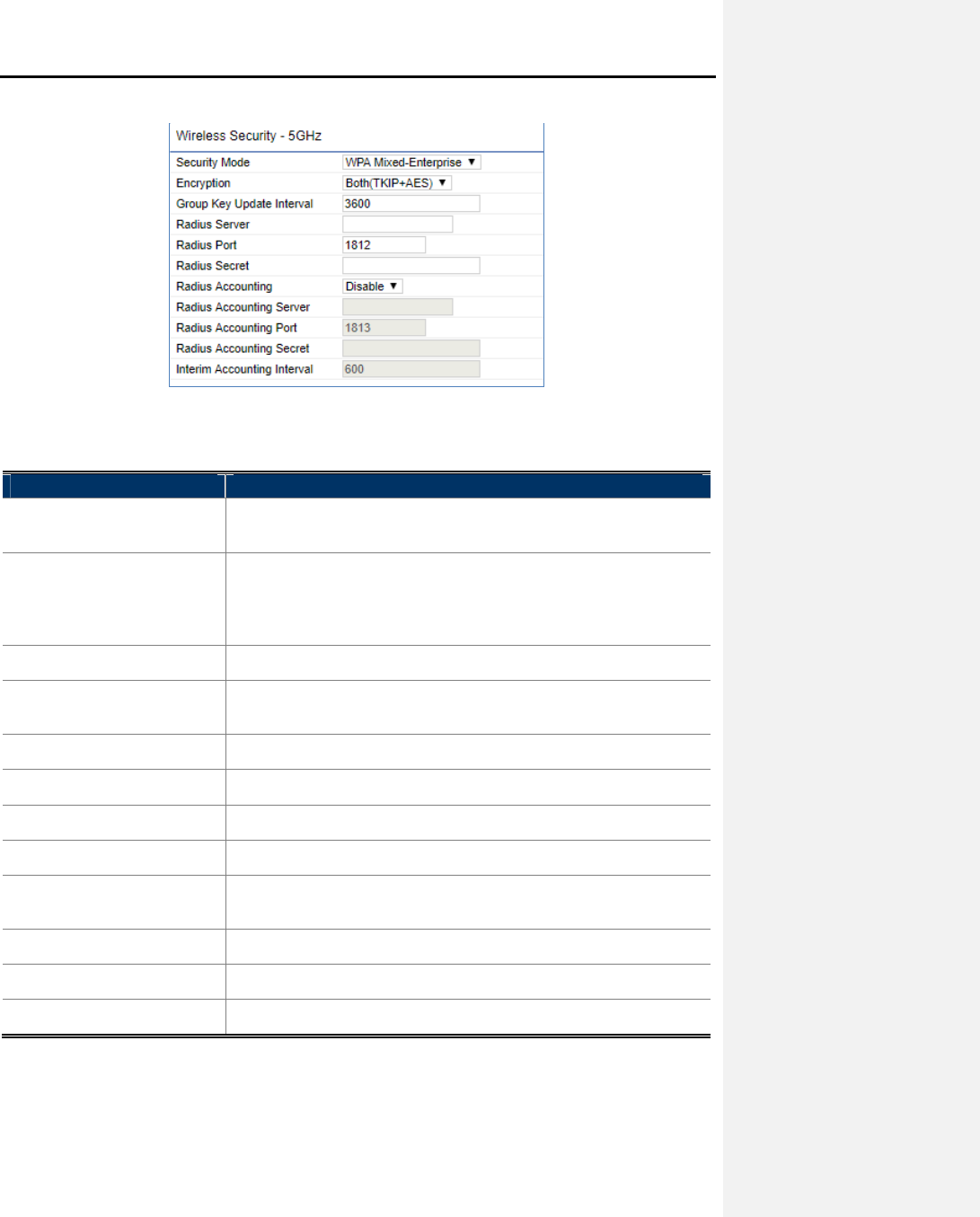
WPA Mixed (WPA
Mixed Enterprise)
Figure 4-39
Security Settings
The security mode includes the following settings
Object
Description
• Security Mode
Select
network using
• Encryption
Select TKIP or AES
• Radius Server
Specify the IP address of the RADIUS server.
• Radius Port
Specify
Default port is 1812.
• Radius Secret
Specify RADIUS secret furnished by the
• Group Key Update Interval
Specify how often, in seconds, the group key changes.
• Radius Accounting
Select to enable or disable RADIUS accounting.
• Radius Accounting Server
Specify the IP address of the RADIUS accounting server.
• Radius Accounting Port
Specify the port number that your RADIUS accounting server uses for
authentication. Default port is
• Radius Accounting Secret
Specify RADIUS accounting secret furnished by the RADIUS server.
• Interim Accounting Interval
Specify the interim accounting interval (60
• Save
Click
User
Manual of
-55-
Mixed Enterprise)
Security Settings
– WPA Mixed (WPA Mixed
Enterprise)
The security mode includes the following settings
:
Description
Select
WPA Mixed from the drop-
down list to configure the wireless
network using
WPA Mixed encryption method.
Select TKIP or AES
, or both
as the encryption type.
Both: uses TKIP and AES.
TKIP: automatic encryption with WPA-
PSK; requires passphrase.
AES: automatic encryption with WPA2-
PSK; requires
Specify the IP address of the RADIUS server.
Specify
the port number that your RADIUS server
Default port is 1812.
Specify RADIUS secret furnished by the
RADIUS server.
Specify how often, in seconds, the group key changes.
Select to enable or disable RADIUS accounting.
Specify the IP address of the RADIUS accounting server.
Specify the port number that your RADIUS accounting server uses for
authentication. Default port is
1813.
Specify RADIUS accounting secret furnished by the RADIUS server.
Specify the interim accounting interval (60
-
600 seconds).
Click
Save to save the settings.
Manual of
WBS-502AC
Enterprise)
down list to configure the wireless
as the encryption type.
PSK; requires passphrase.
PSK; requires
passphrase.
the port number that your RADIUS server
uses for authentication.
RADIUS server.
Specify how often, in seconds, the group key changes.
Specify the IP address of the RADIUS accounting server.
Specify the port number that your RADIUS accounting server uses for
Specify RADIUS accounting secret furnished by the RADIUS server.
600 seconds).
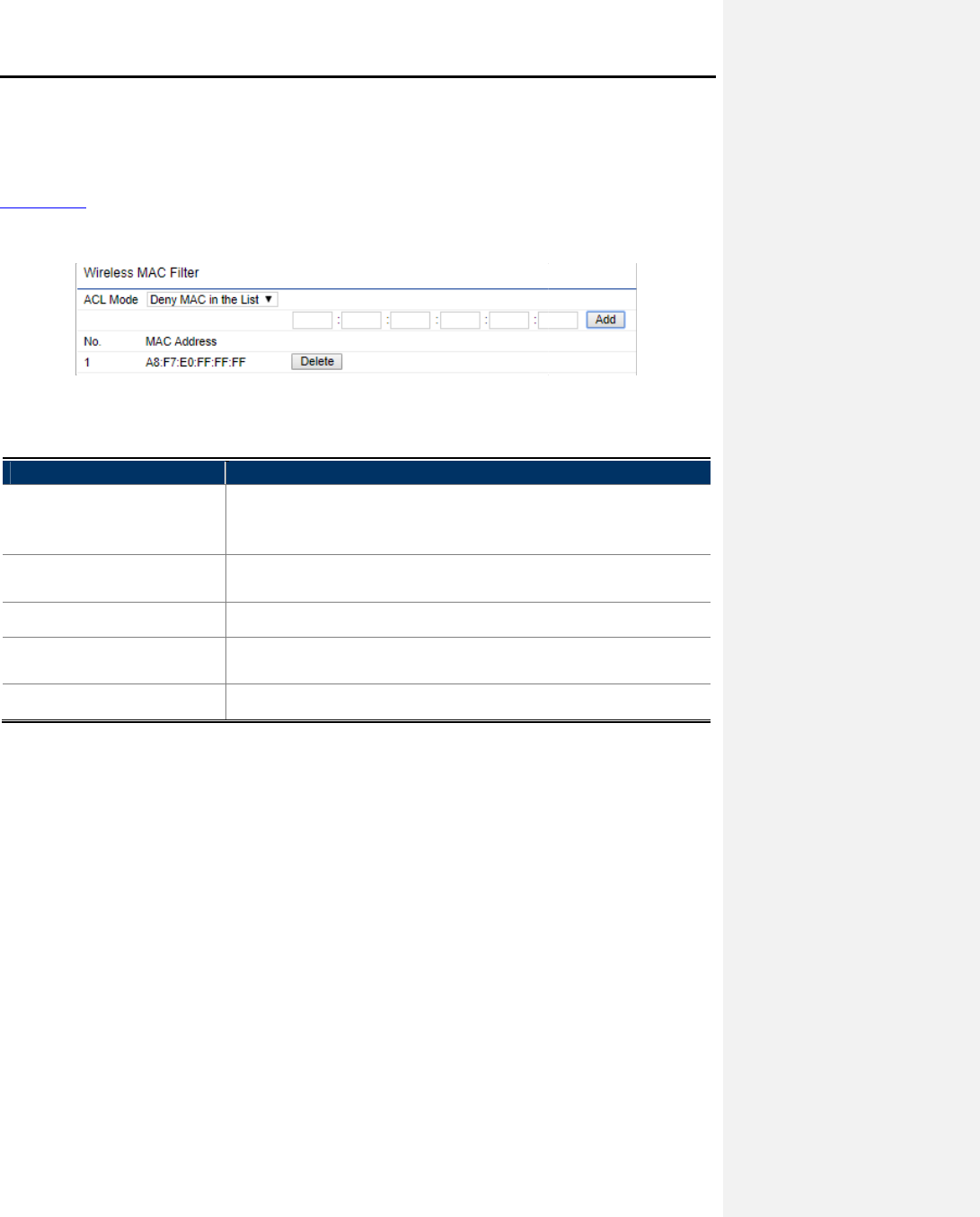
4.5.4 Wireless MAC Filter
Wireless MAC Filters are used to allow or deny network access to wireless clients according to their MAC
addresses. You can manually add a MAC address to restrict the permission to access the device or refer to
section 5.2.3
to kick the associated client from the wireless client list.
Click “Wireless Wireless
MAC Filter
The page
includes the following settings
Object
Description
• ACL Mode
Determines whether network access is granted or denied to clients whose
MAC addresses appear in the MAC Address
option includes
• Add
Enter the
and then c
• No.
Displays
• MAC Address
Displays
device.
• Delete
Click
User
Manual of
-56-
Wireless MAC Filters are used to allow or deny network access to wireless clients according to their MAC
addresses. You can manually add a MAC address to restrict the permission to access the device or refer to
to kick the associated client from the wireless client list.
MAC Filter
”
to configure the wireless access control settings.
Figure 4-40 Wireless MAC Filter
includes the following settings
:
Description
Determines whether network access is granted or denied to clients whose
MAC addresses appear in the MAC Address
table on this page.
option includes
Disable, Deny MAC in the list, or Allow
Enter the
wireless MAC address of the client in front of the
and then c
lick Add to
add the new entry to the MAC filtering list.
Displays
the sequence number of the entries.
Displays
the MAC Address that will be
denied/allowed
device.
Click
Delete to remove the entry from the list.
Manual of
WBS-502AC
Wireless MAC Filters are used to allow or deny network access to wireless clients according to their MAC
addresses. You can manually add a MAC address to restrict the permission to access the device or refer to
to configure the wireless access control settings.
Determines whether network access is granted or denied to clients whose
table on this page.
The
Disable, Deny MAC in the list, or Allow
MAC in the list.
wireless MAC address of the client in front of the
Add button
add the new entry to the MAC filtering list.
denied/allowed
access to this
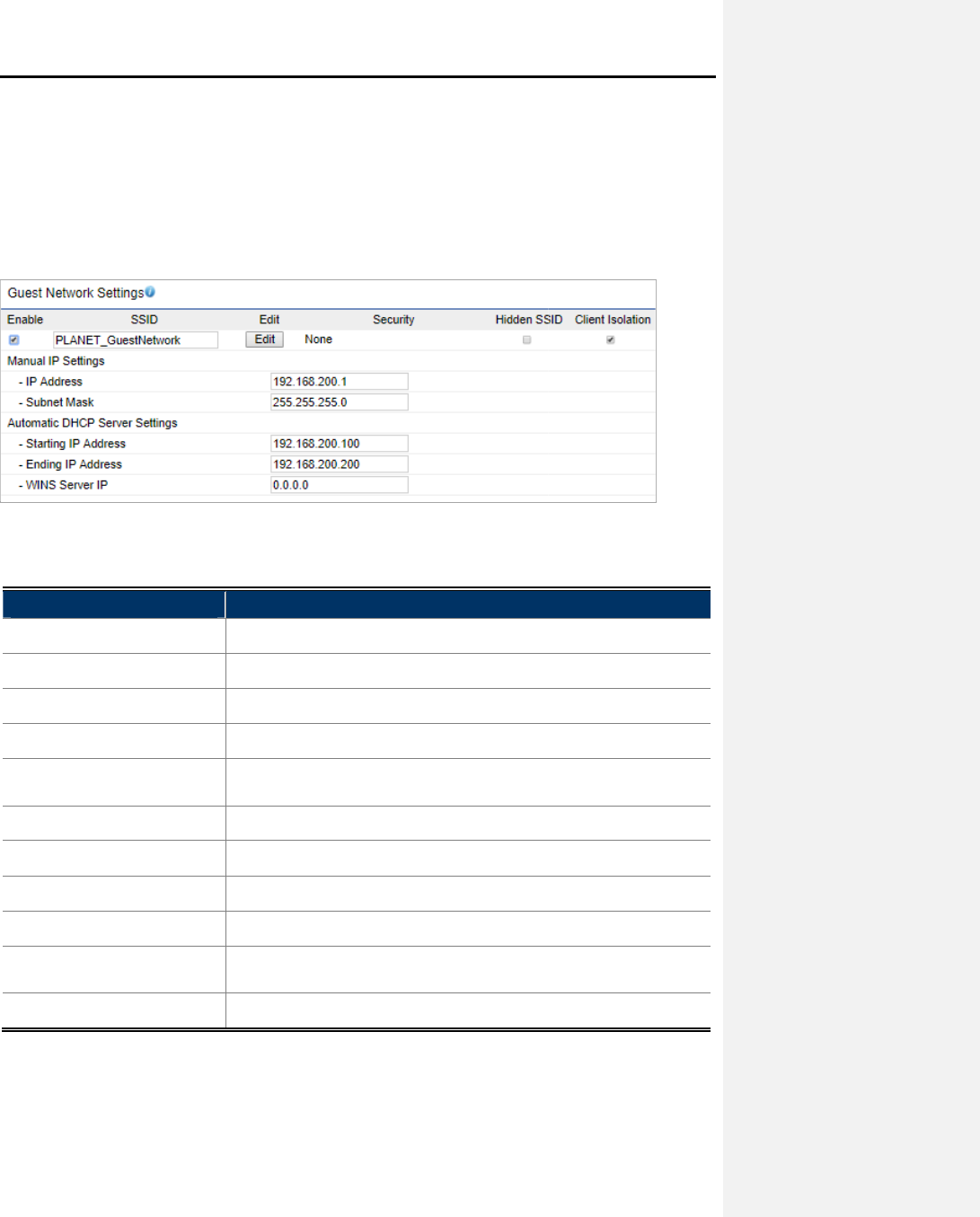
4.5.5 Guest Network
Settings
Go to the “Network Wireless”
page to configure the device as
and then you can configure the G
uest Network
The Guest Network allows segregate temporary guest wifi usage with individual SSID, security and DHCP
settings. Click Edit to configure the
security
Figure
The page includes the following settings
Object
Description
• Enable
Click
• SSID
Specifies the SSID for the current profile.
• Edit
Click
• Security
Displays
• Hidden SSID
Check this option to hide the SSID from
not appear in
• Client Isolation
Check this option to prevent communication between client devices.
• IP Address
IP address of this device when enabled the guest network.
• Subnet Mask
Subnet mask of this device when enabled the guest network.
• Starting IP Address
The first IP Address in the range of
• Ending IP Address
The last IP Address in the range of
server.
• WINS Server IP
Enter the IP address of the WINS server.
4.5.6 RSSI Threshold
Go to the “Network Wireless”
page to configure the device as
User
Manual of
-57-
Settings
page to configure the device as
“Access Point” or “
WDS
uest Network
Settings in the bottom of the page.
The Guest Network allows segregate temporary guest wifi usage with individual SSID, security and DHCP
security
for the guest network.
Figure
4-41 Wireless - Guest Network Settings
The page includes the following settings
:
Description
Click
Enable to enable the guest network wifi.
Specifies the SSID for the current profile.
Click
Edit
to configure the wireless security of the guest network wifi.
Displays
the current security setting of the guest network wifi.
Check this option to hide the SSID from
clients. If checked, the SSID will
not appear in
the site survey.
Check this option to prevent communication between client devices.
IP address of this device when enabled the guest network.
Subnet mask of this device when enabled the guest network.
The first IP Address in the range of
the addresses by the DHCP server.
The last IP Address in the range of
addresses
server.
Enter the IP address of the WINS server.
page to configure the device as
“Access Point” or “
WDS
Manual of
WBS-502AC
WDS
Access Point” mode
The Guest Network allows segregate temporary guest wifi usage with individual SSID, security and DHCP
to configure the wireless security of the guest network wifi.
the current security setting of the guest network wifi.
clients. If checked, the SSID will
Check this option to prevent communication between client devices.
IP address of this device when enabled the guest network.
Subnet mask of this device when enabled the guest network.
the addresses by the DHCP server.
addresses
assigned by the DHCP
WDS
Access Point” mode
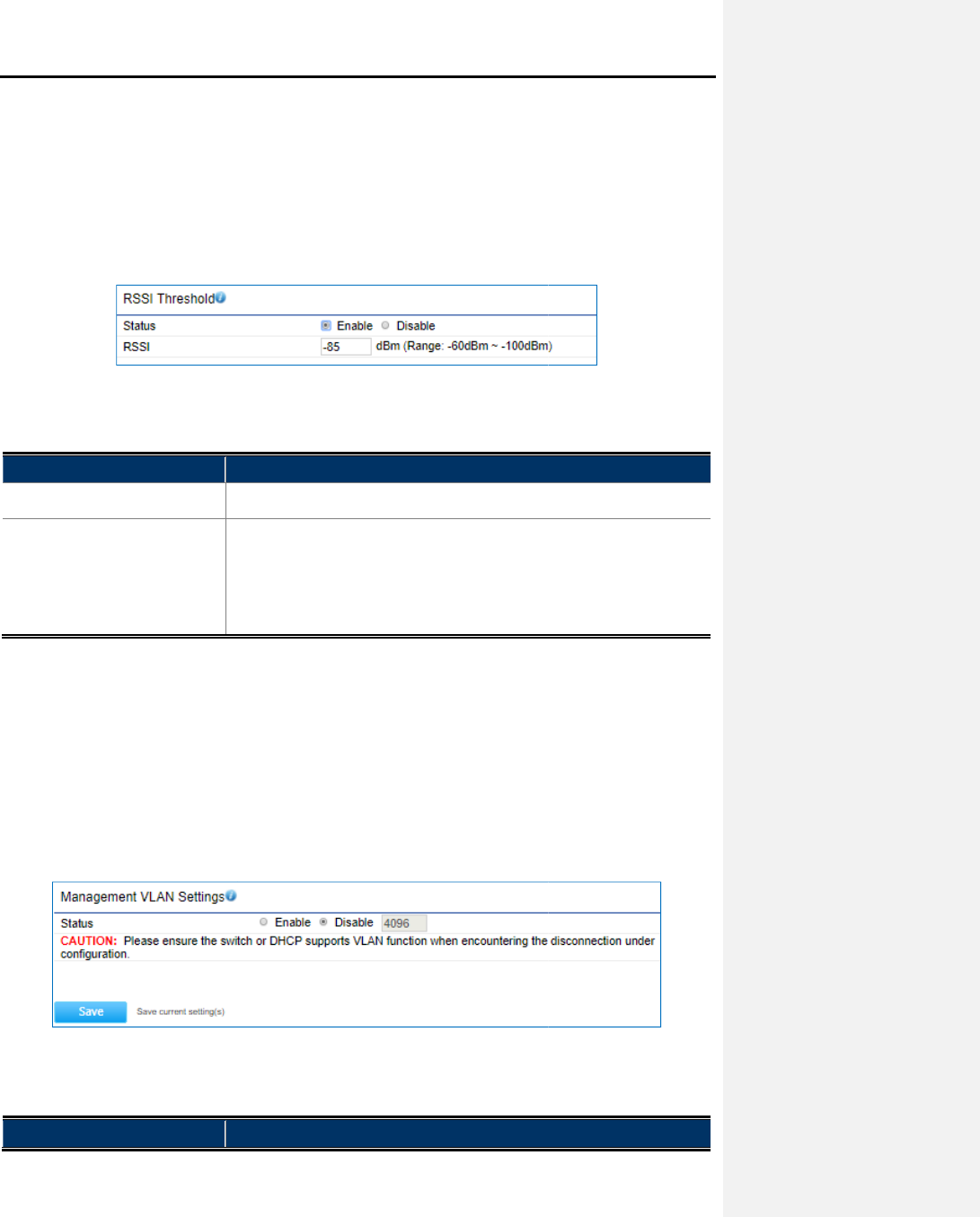
and then you can configure the
Guest Network Settings
and then you can configure the
RSSI Threshold
The RSSI Threshold
is used when a weakening wireless link between AP and client is detected below the
specific RSSI, the AP will encourage client to access the nearby AP with stronger signal, thus ensure stable
wireless connectivity.
Figure
The page includes the following settings
Object
Description
• Status
Click
• RSSI (Received Signal
Strength Index)
Specifies the
Range:
RSSI is an indication of
Therefore,
4.5.7 Management VLAN
Go to the “Network Wireless”
page to configure the device as
and then you can configure the
Management VLAN
If your network includes VLANs and if tagged packets need to pass through the Access Point,
management VLAN settings and
enter the
Figure
The page includes the following settings
Object
Description
User
Manual of
-58-
Guest Network Settings
in the bottom of the page.
RSSI Threshold
in the bottom of the page.
is used when a weakening wireless link between AP and client is detected below the
specific RSSI, the AP will encourage client to access the nearby AP with stronger signal, thus ensure stable
Figure
4-42 Wireless - RSSI Threshold
The page includes the following settings
:
Description
Click
Enable to enable the RSSI Threshold.
Specifies the
RSSI value
to limit the client access.
Range:
-60dBm ~ -100dBm
RSSI is an indication of
the power level being received by the antenna.
Therefore,
the higher the RSSI number, the stronger the signal.
page to configure the device as
“Access Point” or “
WDS
Management VLAN
Settings in the bottom of the
page.
If your network includes VLANs and if tagged packets need to pass through the Access Point,
enter the
VLAN ID. Otherwise, keep it disabled.
Figure
4-43 Wireless – Management VLAN
The page includes the following settings
:
Description
Manual of
WBS-502AC
is used when a weakening wireless link between AP and client is detected below the
specific RSSI, the AP will encourage client to access the nearby AP with stronger signal, thus ensure stable
to limit the client access.
the power level being received by the antenna.
the higher the RSSI number, the stronger the signal.
WDS
Access Point” mode
page.
If your network includes VLANs and if tagged packets need to pass through the Access Point,
enable the

User Manual of WBS-502AC
-59-
• Status Click Enable to enable the Management VLAN.
• Management VLAN ID Specifies the management VLAN ID for the wireless network.
Range: 1 ~ 4094
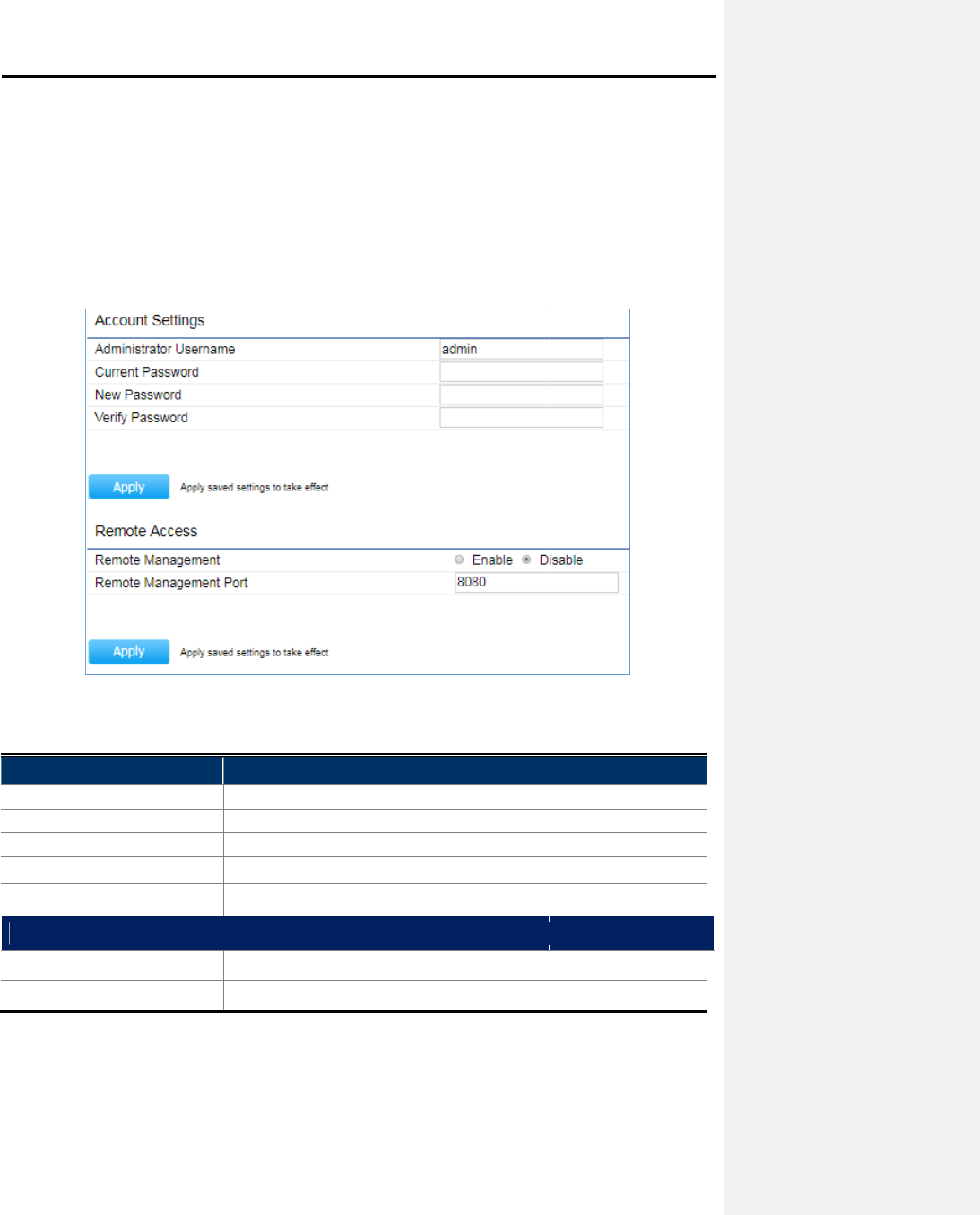
4.6 Management
On this page, you can
configure the system
settings, Time settings, Password settings,
Configuration backup and restore
, Factory default, and
4.6.1 Account
(Password Settings)
Click “System Manager Account
”
Figure
The page includes the following settings
Object
Description
• Administrator Username
Enter a new username for
• Current Password
Enter
• New Password
Enter a new password for logging in to the Web
• Verify Password
Re
• Apply
Click
Remote
Management: WISP mode only
• Remote Management
Click
• Remote Management Port
Enter the remote access port number.
4.6.2 SNMP Settings
SNMP is used in network management systems to monitor network
administrative attention.
User
Manual of
-60-
configure the system
settings for management purpose
, including
settings, Time settings, Password settings,
SNMP settings, CLI settings, Wi-
Fi schedule,
, Factory default, and
Auto reboot.
(Password Settings)
”
to configure
username and password of the login account.
Figure
4-44 Administration (Password Settings)
The page includes the following settings
:
Description
Enter a new username for
logging in to the Web
page.
Enter
the current password.
Enter a new password for logging in to the Web
page.
Re
-enter the new password for confirmation.
Click
Apply to apply all changes.
Management: WISP mode only
Click
Enable to enable remote access through
WAN.
Enter the remote access port number.
SNMP is used in network management systems to monitor network
-
attached devices for
Manual of
WBS-502AC
, including
Management VLAN
Fi schedule,
Firmware upgrade,
username and password of the login account.
page.
page.
WAN.
attached devices for
conditions that warrant
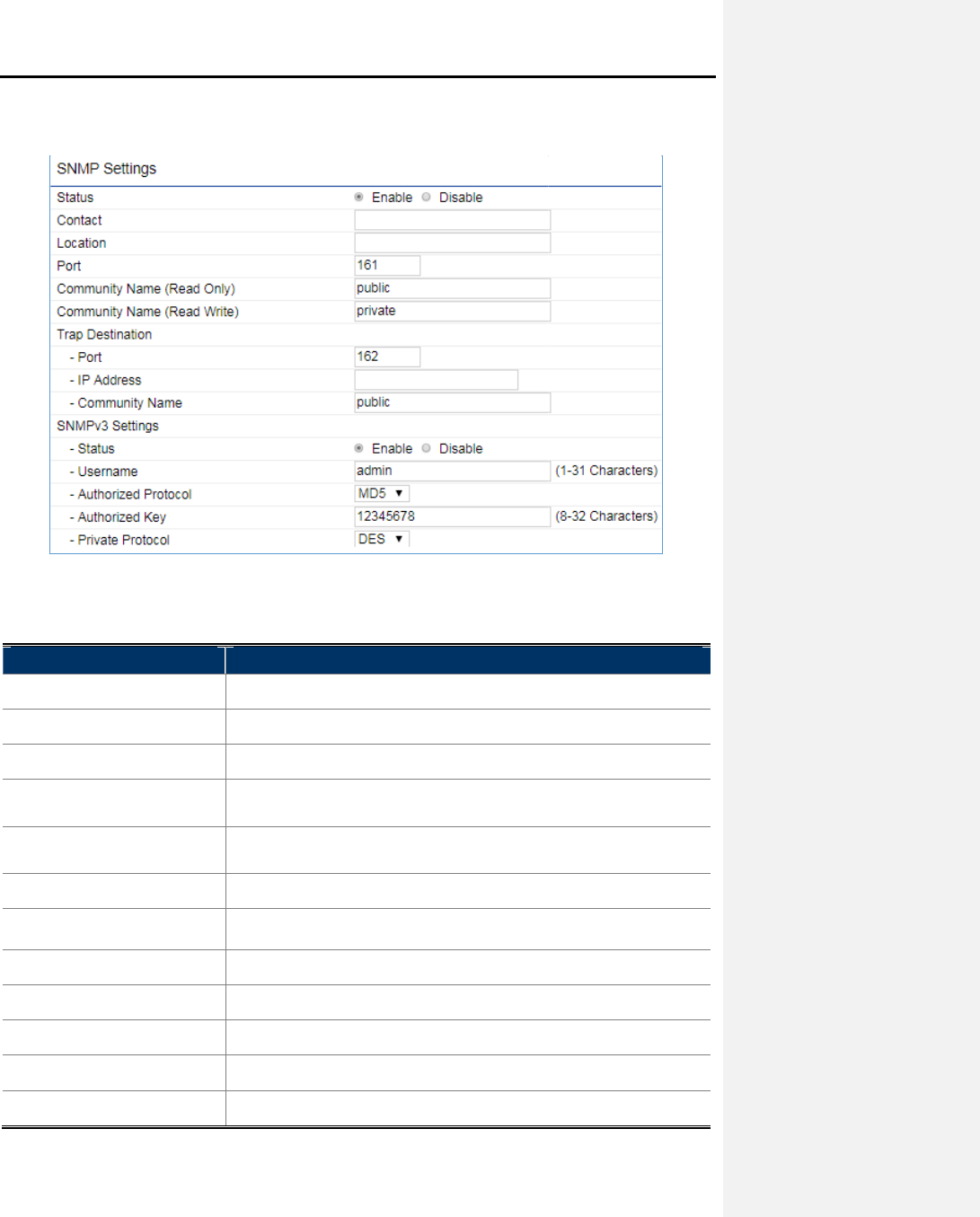
Click “Management Advanced”
to
The page includes the following settings
Object
Description
• SNMP
Enable or disable the SNMP service.
• Contact
Enter the contact details of the device.
• Location
Enter the location of the device.
• Community Name (Read
Only)
Enter the
access.
• Community Name
(Read/Write)
Enter the
write access.
• Trap Destination Address
Enter the IP address
• Trap Destination
Community Name
Enter the
• SNMPv3
Enable or Disable the SNMPv3 feature.
• User Name
Specify the username for SNMPv3.
• Auth Protocol
Select the authentication protocol type: MD5 or SHA.
• Auth Key (8-32 Characters)
Specify the authentication key for authentication.
• Priv Protocol
Select the privacy protocol type: DES.
User
Manual of
-61-
to
configure SNMP settings.
Figure 4-45 SNMP Settings
The page includes the following settings
:
Description
Enable or disable the SNMP service.
Enter the contact details of the device.
Enter the location of the device.
Enter the
password for accessing the SNMP community for
access.
Enter the
password for accessing the SNMP community for
write access.
Enter the IP address
where SNMP traps are to be sent.
Enter the
password of the SNMP trap
community.
Enable or Disable the SNMPv3 feature.
Specify the username for SNMPv3.
Select the authentication protocol type: MD5 or SHA.
Specify the authentication key for authentication.
Select the privacy protocol type: DES.
Manual of
WBS-502AC
password for accessing the SNMP community for
read-only
password for accessing the SNMP community for
read and
where SNMP traps are to be sent.
community.
Select the authentication protocol type: MD5 or SHA.
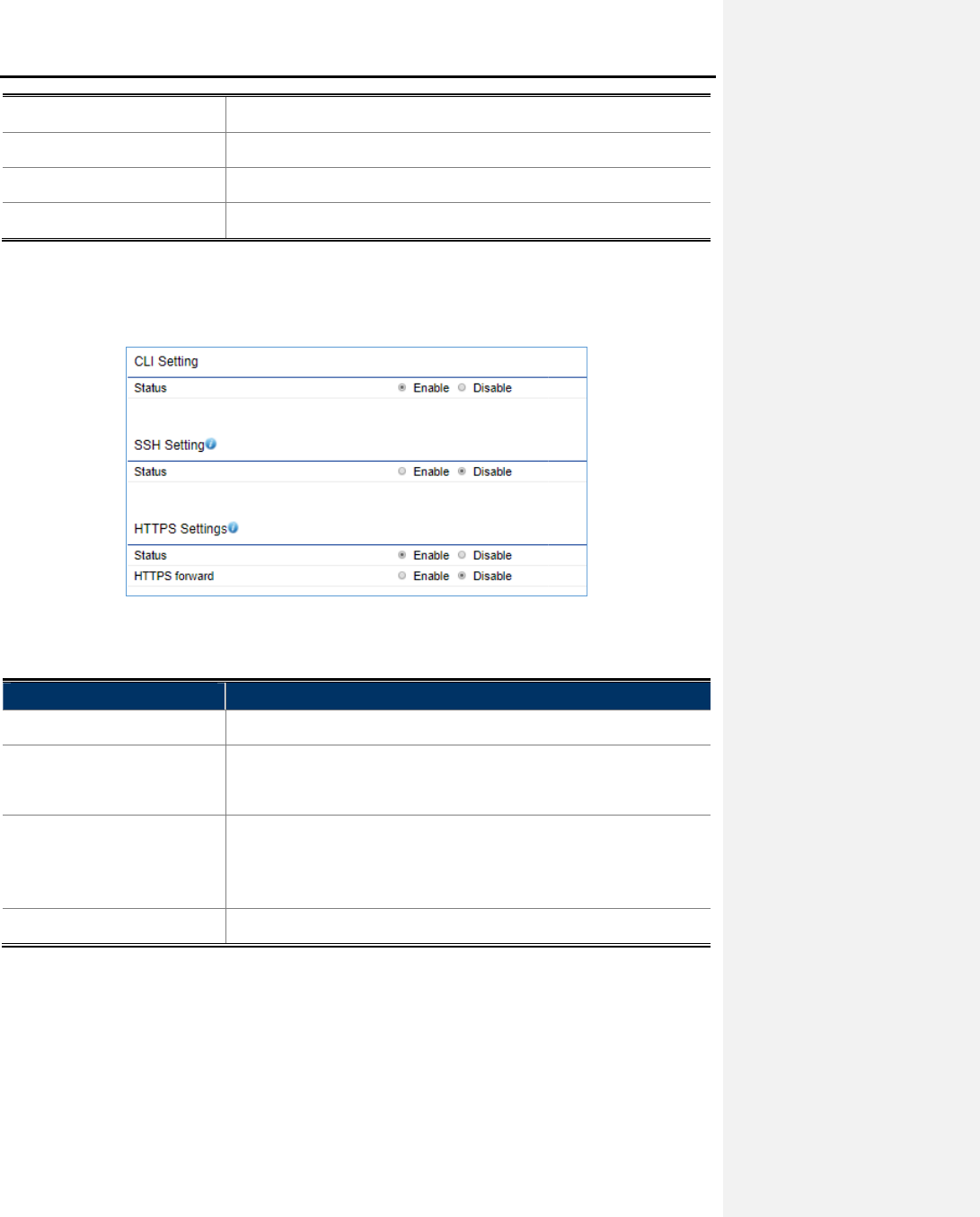
• Priv Key (8-32 Characters)
Specify the privacy key for privacy.
• Engine ID
Specify the engine ID for SNMPv3.
• Save/Apply
Click
• Cancel
Click
4.6.3
CLI/SSH/HTTPS Settings
Click “Management Advanced”
to
Figure
The page includes the following settings
Object
Description
• CLI
Enable or
• SSH
Enable Secure Shell (SSH) to make secure, encrypted
network. Secure Shell is a network
e
• HTTPS
Enable HTTPS to transfer and
Hypertext Transfer Protocol over SSL (Secure
protocol used by web servers to
securely.
• Apply
Click
4.6.4 Email Alert
You can use the Email Alert feature to send messages to the configured email address when particular system
events occur. Click “Management
User
Manual of
-62-
Specify the privacy key for privacy.
Specify the engine ID for SNMPv3.
Click
Save/Apply to apply all changes.
Click
Cancel to cancel the settings.
CLI/SSH/HTTPS Settings
to
configure CLI/SSH/HTTPS settings.
Figure
4-46 CLI/SSH/HTTPS Settings
The page includes the following settings
:
Description
Enable or
disable the device management
via a command line
Enable Secure Shell (SSH) to make secure, encrypted
network. Secure Shell is a network
protocol that allows data to be
e
xchanged using a secure
channel between two network
Enable HTTPS to transfer and
Displays
web content
Hypertext Transfer Protocol over SSL (Secure
Socket Layer) is a TCP/IP
protocol used by web servers to
transfer and
securely.
Click
Apply to apply all changes.
You can use the Email Alert feature to send messages to the configured email address when particular system
Advanced” to configure email alert settings.
Manual of
WBS-502AC
via a command line
interface.
Enable Secure Shell (SSH) to make secure, encrypted
connections in the
protocol that allows data to be
channel between two network
devices.
web content
securely. The
Socket Layer) is a TCP/IP
transfer and
Displays web content
You can use the Email Alert feature to send messages to the configured email address when particular system
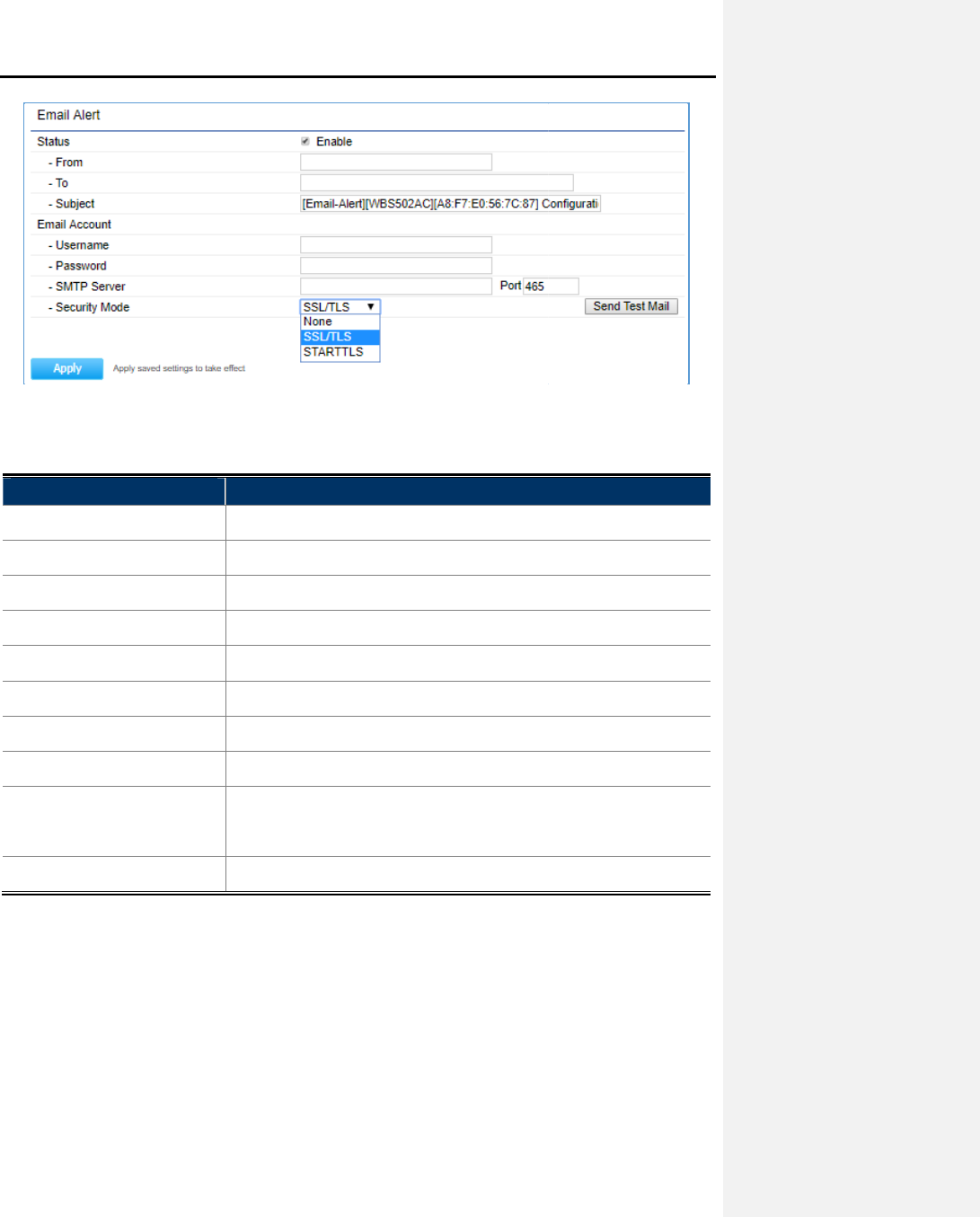
The page includes the following settings
Object
Description
• Status
Click
• From
Enter the email address to show the sender of the email.
• To
Enter the address to receive
• Subject
Enter the text to appear in the email subject line.
• Username
Enter the username for the email account that will be used to send emails.
• Password
Enter the password for the email account that will be used to send emails.
• SMTP Server
Enter the IP address or hostname of the outgoing SMTP server.
• Port
Enter the SMTP port number to use for outbound emails.
• Security Mode
Select the security mode of the SMTP server.
SSL/TLS: default port number is 465
STARTTLS:
• Apply
Click
4.6.5
Backup/Restore Settings
Click “System Manager
Firmware
User
Manual of
-63-
Figure 4-47 Email Alert Settings
The page includes the following settings
:
Description
Click
Enable to use email alert.
Enter the email address to show the sender of the email.
Enter the address to receive
email alerts.
Enter the text to appear in the email subject line.
Enter the username for the email account that will be used to send emails.
Enter the password for the email account that will be used to send emails.
Enter the IP address or hostname of the outgoing SMTP server.
Enter the SMTP port number to use for outbound emails.
Select the security mode of the SMTP server.
SSL/TLS: default port number is 465
STARTTLS:
default port number is 587
Click
Apply to apply all changes.
Backup/Restore Settings
Firmware
” and refer to the “Backup/Restore Settings
” section.
Manual of
WBS-502AC
Enter the email address to show the sender of the email.
Enter the username for the email account that will be used to send emails.
Enter the password for the email account that will be used to send emails.
Enter the IP address or hostname of the outgoing SMTP server.
Enter the SMTP port number to use for outbound emails.
” section.
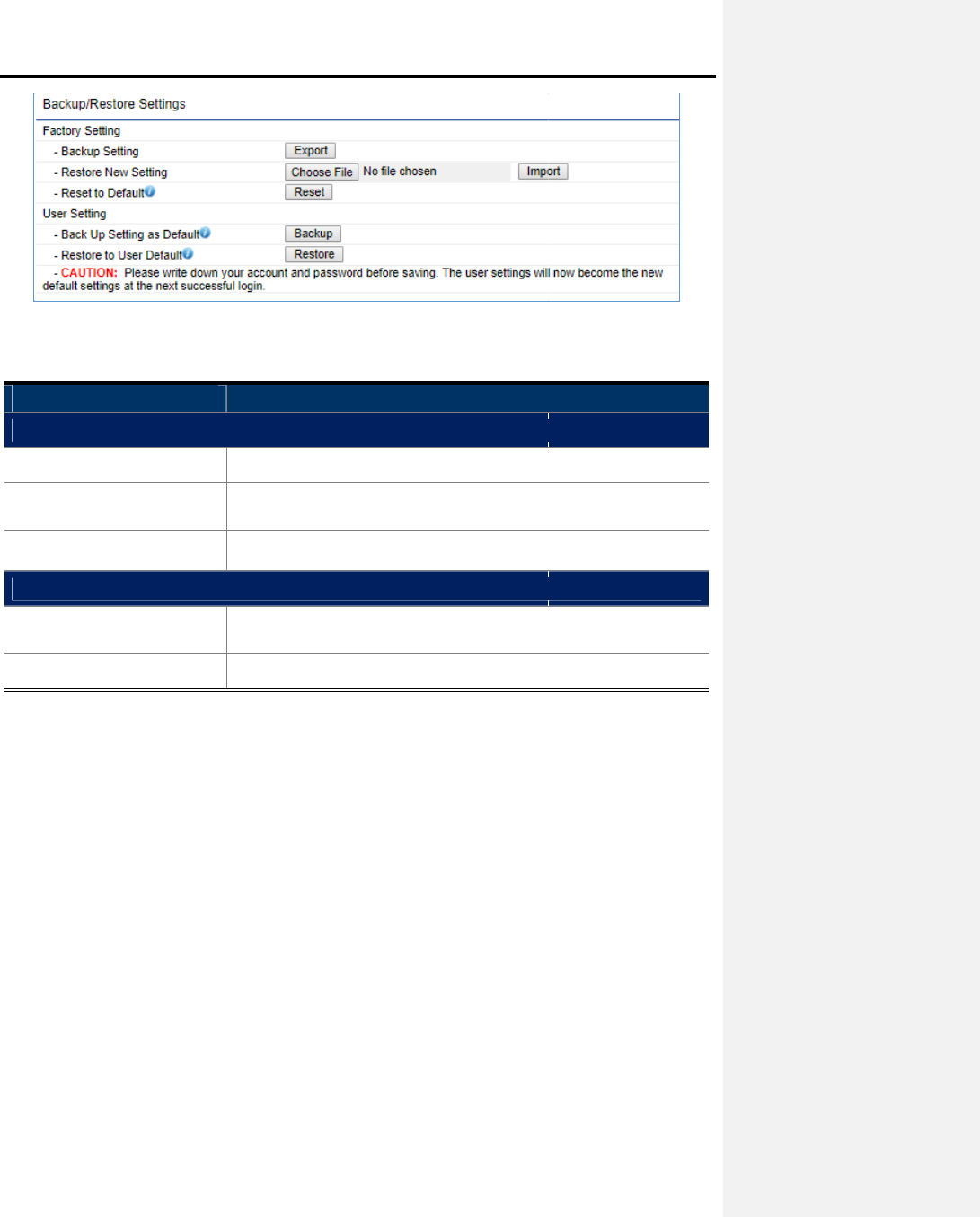
Figure
The page includes the following settings
Object
Description
Factory Setting
• Backup Setting
Click
• Restore New Setting
To restore settings that have been previously backed up, click
File
• Revert to Factory Default
Settings
Click
User Setting
• Backup Setting as Default
Click
device’s memory for the default settings.
• Restore to User Default
Click
4.6.6 WiFi Scheduler
4.6.6.1.
Auto Reboot Settings
Click “Management
WiFi Scheduler
This page allows you to enable and configure system
according to the
frequency in different time formats of interval.
User
Manual of
-64-
Figure
4-48 Backup/Restore Settings
The page includes the following settings
:
Description
Click
Export
to save the current configured settings.
To restore settings that have been previously backed up, click
File
to select the file, and click Import.
Click
Reset to restore the device
to its factory default settings.
Click
Backup
to backup the user settings you would like to
device’s memory for the default settings.
Click
Restore
to restore user settings to the factory standard settings.
WiFi Scheduler
” and the following page will be displayed.
This page allows you to enable and configure system
auto reboot interval. The d
evice can regularly
frequency in different time formats of interval.
Manual of
WBS-502AC
to save the current configured settings.
To restore settings that have been previously backed up, click
Choose
to its factory default settings.
to backup the user settings you would like to
save to the
to restore user settings to the factory standard settings.
evice can regularly
reboot
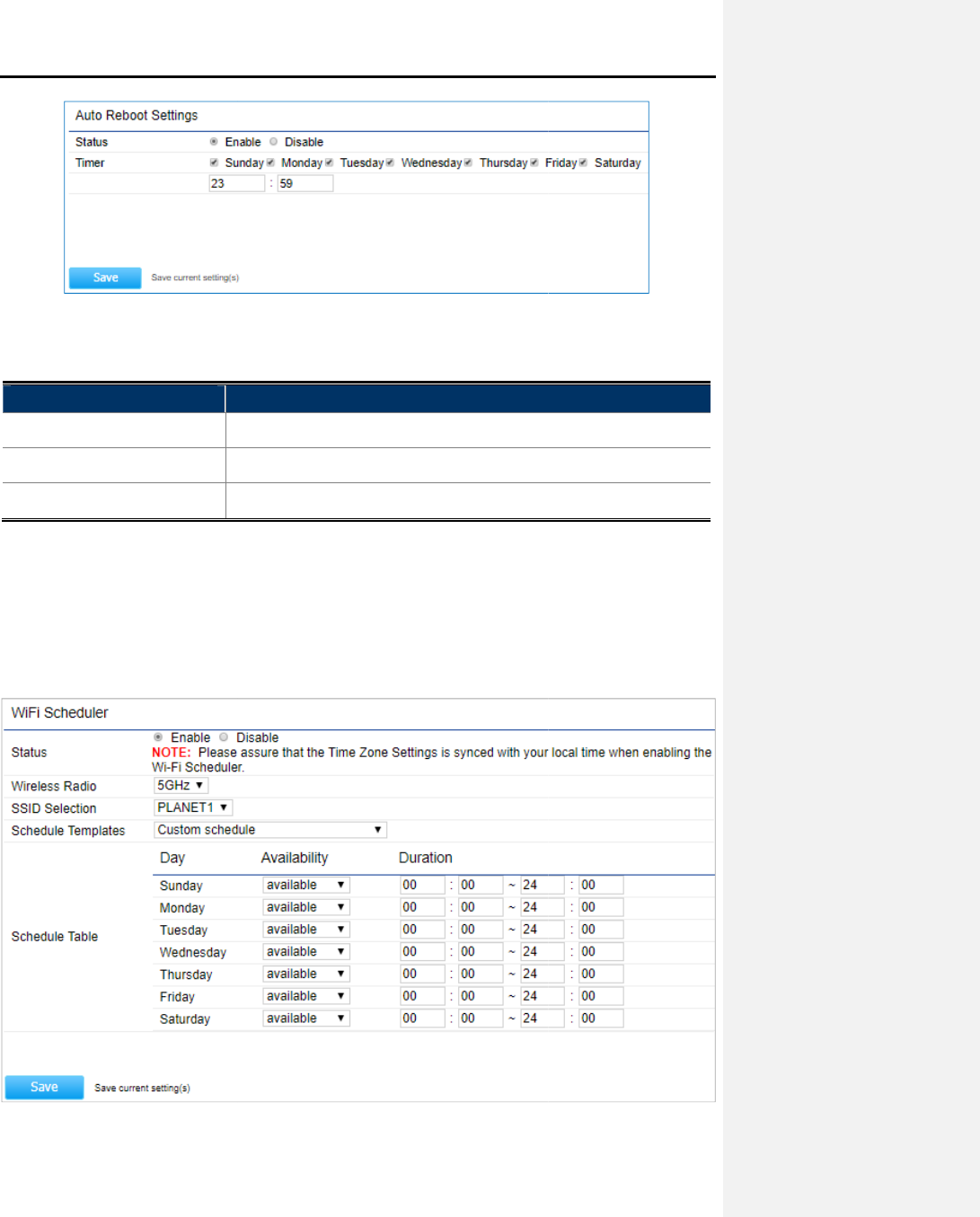
The page includes the following settings
Object
Description
• Auto Reboot Settings
Select Enable to set
• Timer
Select the day and enter the time you would like
• Save
Click
4.6.6.2.
WiFi Scheduler
Click “Management
WiFi Scheduler
This page allows you to configure
wireless on/off schedule rule
wireless radio according to the
specific
User
Manual of
-65-
Figure 4-49 Auto Reboot Settings
The page includes the following settings
:
Description
Select Enable to set
up this function.
Select the day and enter the time you would like
to reboot automatically.
Click
Save to save all changes.
WiFi Scheduler
” and the following page will be displayed.
wireless on/off schedule rule
. The d
evice can regularly
specific
scheduling rule.
Figure 4-50 WiFi scheduler
Manual of
WBS-502AC
to reboot automatically.
evice can regularly
enable/disable
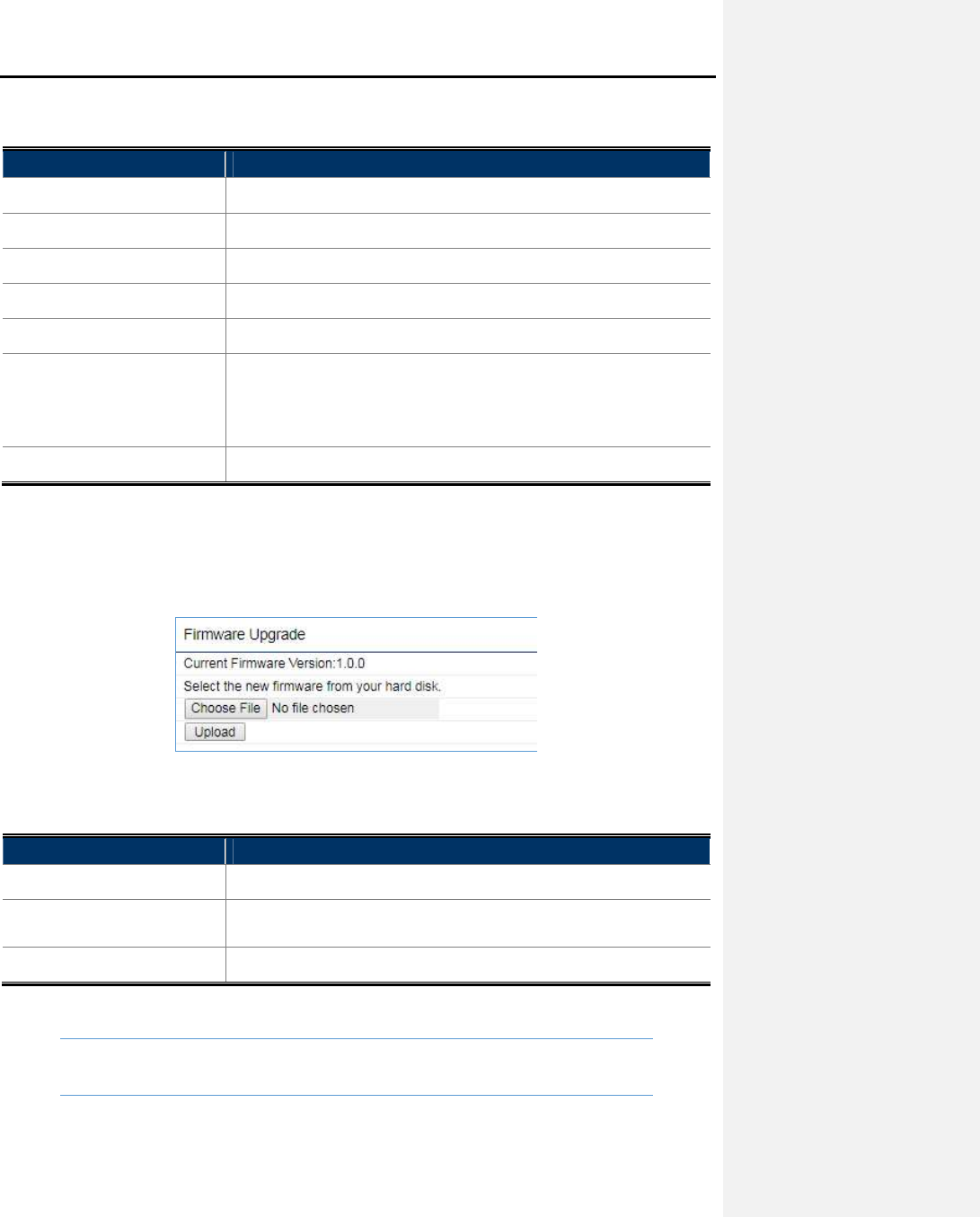
User Manual of WBS-502AC
-66-
The page includes the following settings:
Object Description
• Status Select Enable to set up this function.
• Wireless Radio Select frequency from the drop-down list for the preferred band type.
• SSID Selection Select the SSID that you want to configure the wifi schedule.
• Schedule Templates Select a schedule template from the drop-down list.
• Schedule Table Choose “available” or “unavailable” on the specific day.
• Duration
Configure the wifi radio on/off according to the duration time you planned.
The format is [HH:MM ~ HH:MM] (Start Time ~ End Time).
HH: range from 0-24
MM: range from 0-59
• Save Click Save to save all changes.
4.6.7 Firmware Upgrade
Click “System Manager Firmware” and refer to the “Firmware Upgrade” section to upgrade the device’s
firmware.
Figure 4-51 Firmware Upgrade
The page includes the following settings:
Object Description
• Current Firmware Version Displays the current firmware version.
• Choose File Click Choose File to locate and select the upgrade file from your local
hard disk.
• Upload Click Upload to upgrade the firmware.
Firmware Upgrade Procedure
The following procedure will guide you to how to upgrade the firmware.
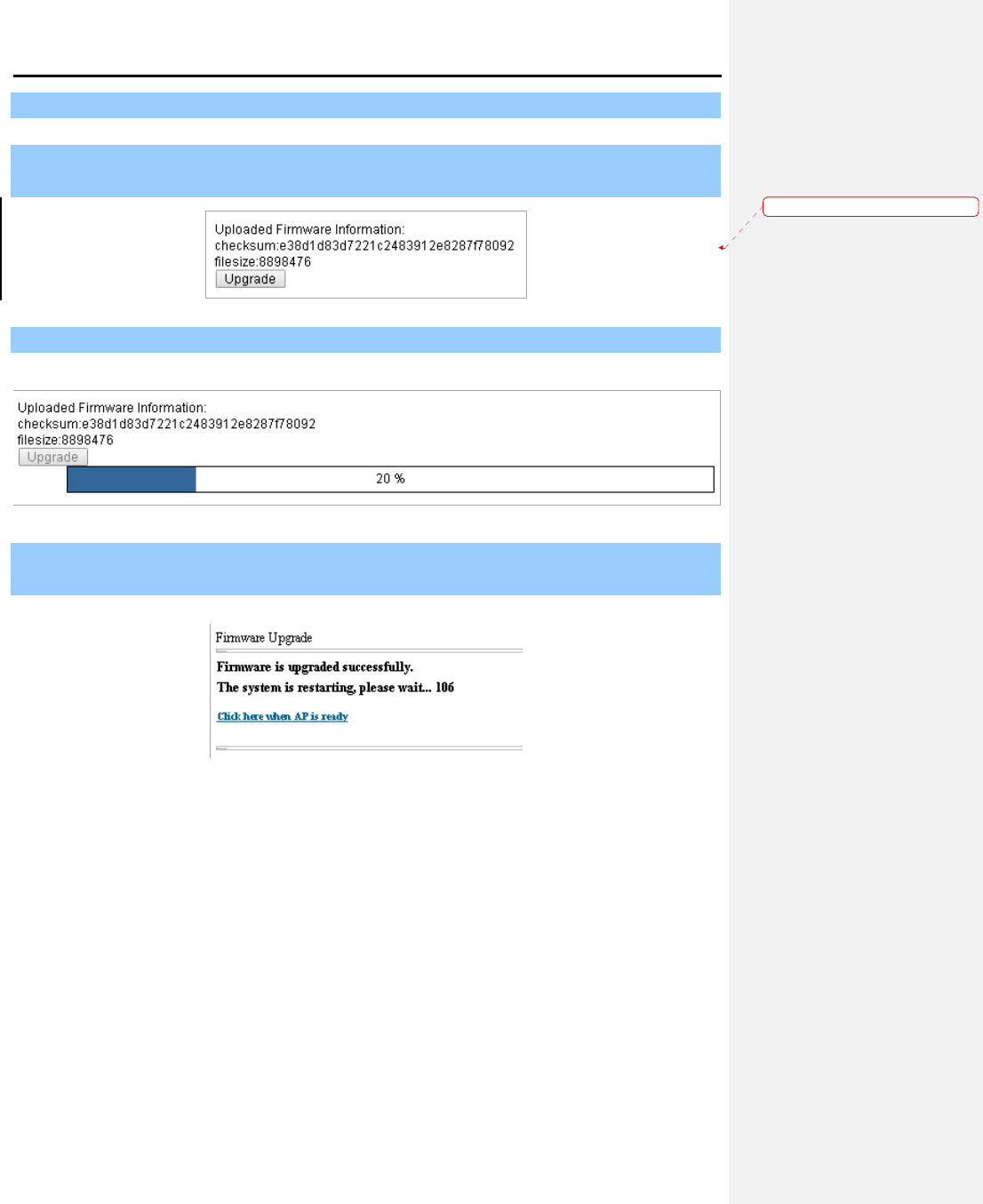
User Manual of WBS-502AC
-67-
Step 1. Click the Choose File button to locate the firmware file path. Then, click the Upload button.
Step 2. The firmware checksum information appears to help you confirm whether the file is correct. Once
confirmed, click the Upgrade button to begin the upgrade process.
Step 3. Wait for the process until it is finished.
Step 4. When the upgrade is finished, the system will auto reboot and you can click the hyperlink “Click here
when AP is ready” after the system restarts.
4.6.8 Time Settings
Click “Management Time Settings” to configure time zone and NTP server settings to be in sync with the
device’s time.
格式化: 間距 套用前: 0.5 行
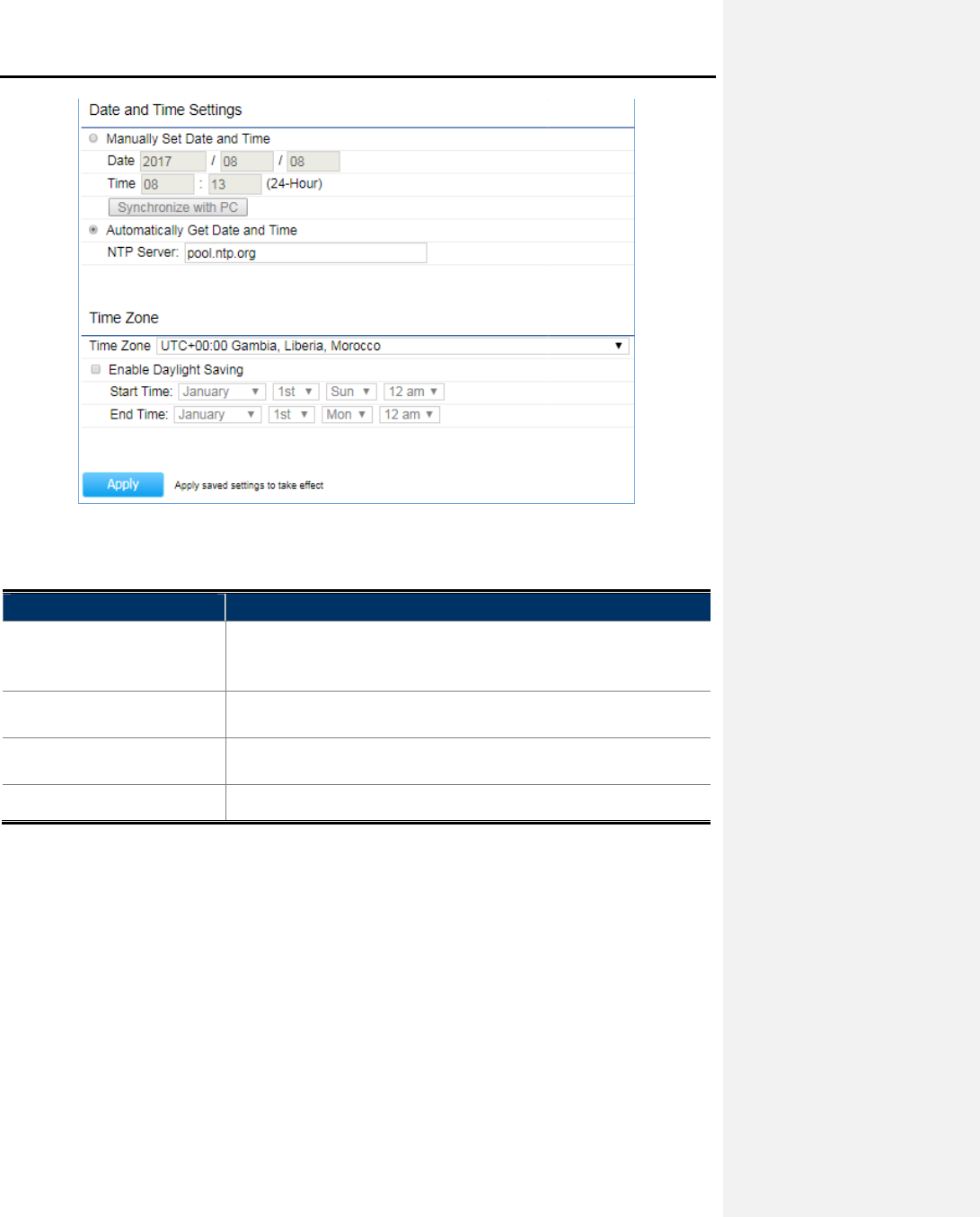
The page includes the following settings
Object
Description
• Manually Set Date and Time
Enter the date and time values in
Synchronize with PC
administrator’s
• Automatically Get Date and
Time
Select a time zone from the
enter the IP
• Enable Daylight Saving
Click to enable or disable daylight
times from the Start
• Apply
Click
User
Manual of
-68-
Figure 4-52 Time Settings
The page includes the following settings
:
Description
Enter the date and time values in
the date and time fields or click the
Synchronize with PC
to get th
e date and time values from the
administrator’s
PC.
Select a time zone from the
drop-
down list and check whether you want to
enter the IP
address of an NTP server or use the default NTP server.
Click to enable or disable daylight
savings time. Select t
times from the Start
Time and Stop Time drop-
down lists.
Click
Apply to apply all changes.
Manual of
WBS-502AC
the date and time fields or click the
e date and time values from the
down list and check whether you want to
address of an NTP server or use the default NTP server.
savings time. Select t
he start and stop
down lists.
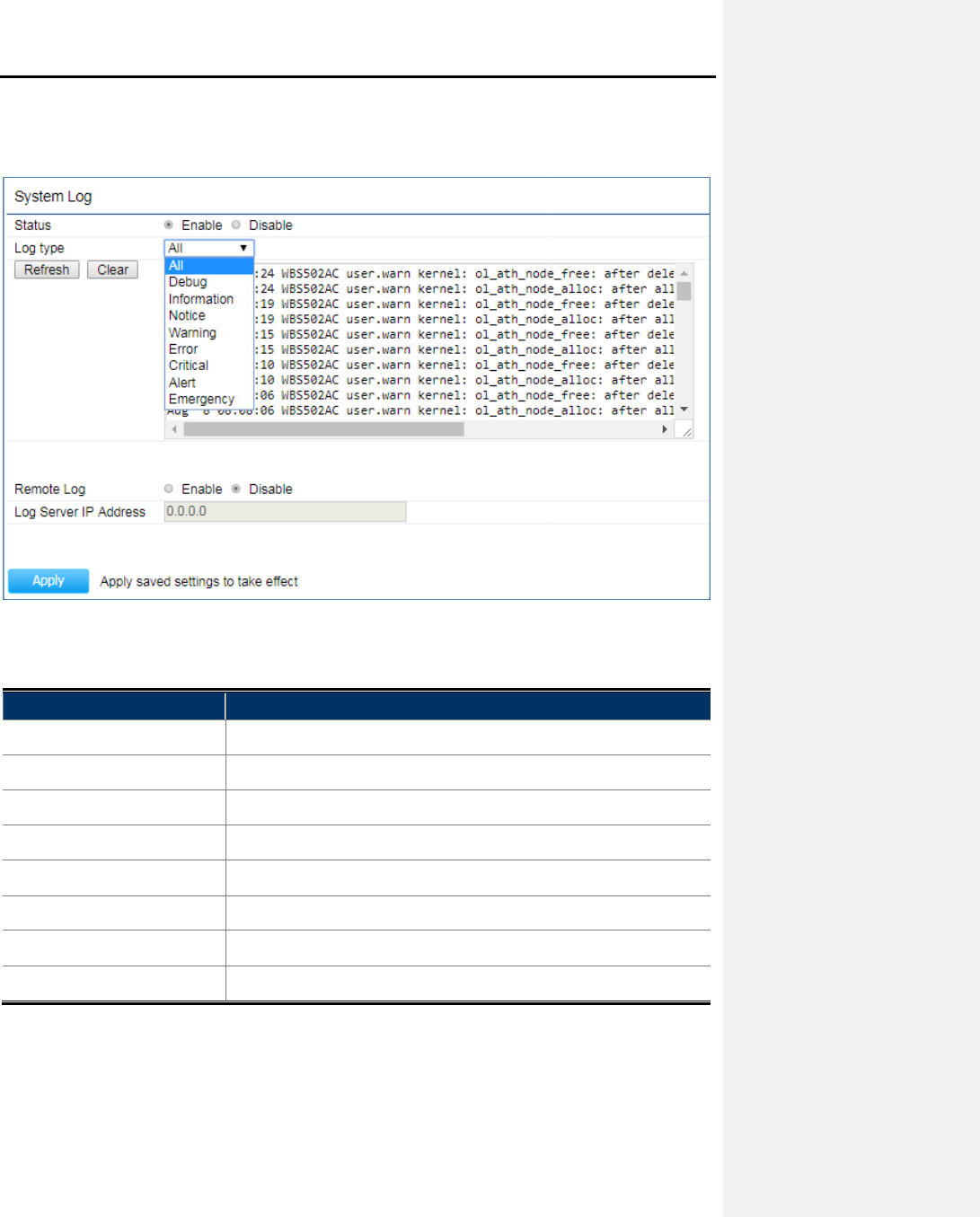
4.6.9 Log
Click “System Manager Log”
to view the
The
page includes the following settings
Object
Description
• Status
Select
• Log type
Select log type to filter the records.
• Save
Click
• Refresh
Click
• Clear
Click
• Remote Log
Select
• Log Server IP Address
Enter the remote log server IP address to record the system log.
• Apply
Click
4.6.10 Tools
Click “Management Tools” to
test the connection and performance through the built
User
Manual of
-69-
to view the
system log.
Figure 4-53 System Log
page includes the following settings
:
Description
Select
Enable to enable the system log.
Select log type to filter the records.
Click
Save to save the records.
Click
Refresh to update the current data.
Click
Clear to erase the records.
Select
Enable to enable the remote log function.
Enter the remote log server IP address to record the system log.
Click
Apply to apply all changes.
test the connection and performance through the built
Manual of
WBS-502AC
Enter the remote log server IP address to record the system log.
test the connection and performance through the built
-in diagnostics utilities.
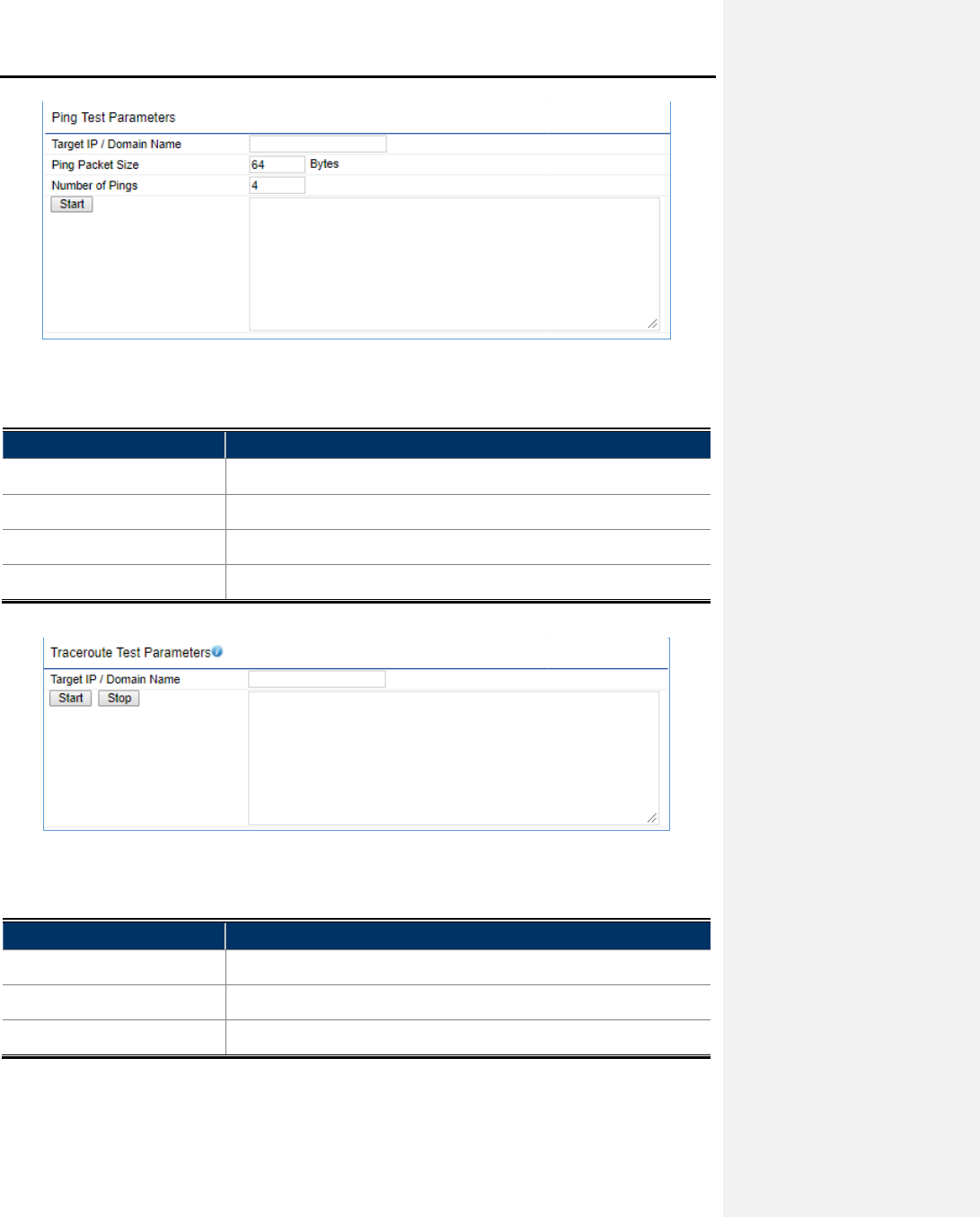
The section
includes the following settings
Object
Description
• Target IP / Domain Name
Enter the IP address you would like to
• Ping Packet Size
Enter the packet size of each ping.
• Number of Pings
Enter the number of times you want to ping.
• Start
Click
The section
includes the following settings
Object
Description
• Trace route target
Enter an IP address or domain name you want to
• Start
Click
• Stop
Click
User
Manual of
-70-
Figure 4-54 Tools - Ping
includes the following settings
:
Description
Enter the IP address you would like to
ping.
Enter the packet size of each ping.
Enter the number of times you want to ping.
Click
Start to begin pinging.
Figure 4-55 Tools - Traceroute
includes the following settings
:
Description
Enter an IP address or domain name you want to
Click
Start to begin the traceroute operation.
Click
Stop to terminate the traceroute operation.
Manual of
WBS-502AC
trace.
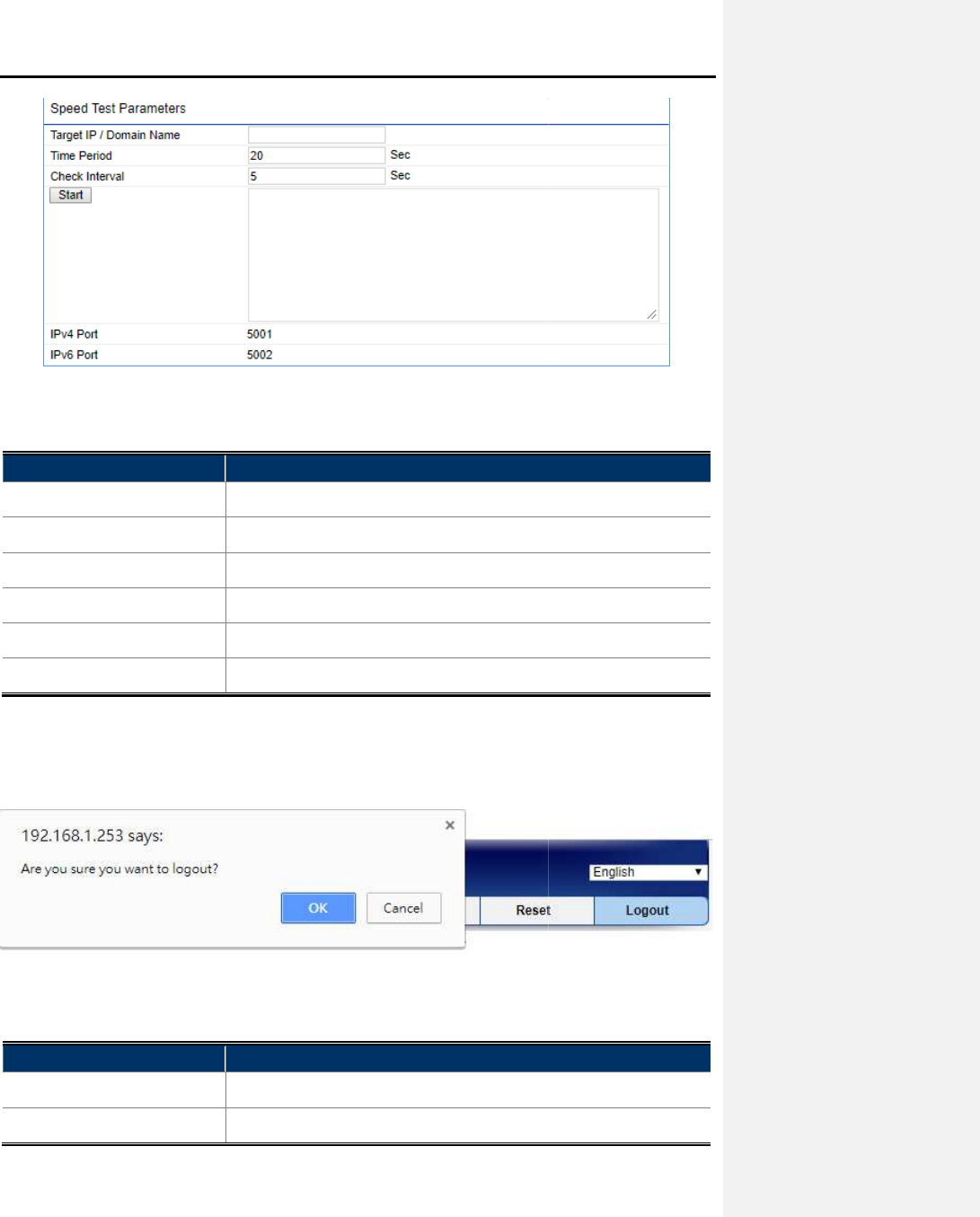
The section
includes the following settings
Object
Description
• Target IP / Domain Name
Enter the IP address you would like to
• Time period
Enter time period for the speed test.
• Check Interval
Enter the interval for the speed test.
• Start
Click
• IPv4 Port
Displays
• IPv6 Port
Displays
4.6.11 Logout
Click “Logout” on the upper-
right corner of the page
The page includes the following settings
Object
Description
• OK
Click
• Cancel
Click
User
Manual of
-71-
Figure 4-56 Tools – Speed Test
includes the following settings
:
Description
Enter the IP address you would like to
test.
Enter time period for the speed test.
Enter the interval for the speed test.
Click
Start to begin the speed test operation.
Displays
the IPv4 port number of the device.
Displays
the IPv6 port number of the device.
right corner of the page
to log out the system.
Figure 4-57 Logout
The page includes the following settings
:
Description
Click
OK to log out the system.
Click
Cancel to cancel the operation.
Manual of
WBS-502AC

User Manual of WBS-502AC
-72-
Appendix A: Troubleshooting
If you find the AP is working improperly or stop responding to you, please read this troubleshooting first before
contacting the Planet Tech Support for help. Some problems can be solved by yourself within a very short time.
Scenario Solution
The AP is not responding to me when I
want to access it by web browser.
Please check the connection of the power cord and the
Ethernet cable of this AP. All cords and cables should be
correctly and firmly inserted to the AP.
If all LEDs on this AP are off, please check the status of
power adapter, and make sure it is correctly powered.
You must use the same IP address section that AP uses.
Are you using MAC or IP address filter? Try to connect the
AP by another computer and see if it works; if not, please
reset the AP to the factory default settings (Press the ‘reset’
button for over 10 seconds).
Set your computer to static IP address, and see if the
Planet Smart Discovery can find the AP or not.
If you did a firmware upgrade and this happens, contact the
Planet Tech Support for help.
If all the solutions above don’t work, contact the Planet
Tech Support for help.
I can’t get connected to the Internet. Check the Internet connection status from the router that is
connected with the AP.
Please be patient. Sometimes Internet is just that slow.
If you have connected a computer to Internet directly
before, try to do that again, and check if you can get
connected to Internet with your computer directly attached
to the device provided by your Internet service provider.
Check PPPoE / L2TP / PPTP user ID and password in your
router again.
Call your Internet service provider and check if there’s
something wrong with their service.
If you just can’t connect to one or more website, but you
can still use other internet services, please check
URL/Keyword filter.
Try to reset the AP and try again later.
Reset the device provided by your Internet service provider.
Try to use IP address instead of hostname. If you can use
IP address to communicate with a remote server, but can’t
use hostname, please check DNS setting.
I can’t locate my AP by my wireless device.
‘Broadcast ESSID’ set to off?
The antenna is properly secured.

User Manual of WBS-502AC
-73-
Are you too far from your AP? Try to get closer.
Please remember that you have to input ESSID on your
wireless client manually, if ESSID broadcast is disabled.
File downloading is very slow or breaks
frequently.
Are you using QoS function? Try to disable it and try again.
Internet is slow sometimes; try to be patient.
Try to reset the AP and see if it’s better after that.
Try to know what computers do on your local network. If
someone’s transferring big files, other people will think
Internet is really slow.
If this never happens before, call you Internet service
provider to know if there is something wrong with their
network.
I can’t log into the web management
interface; the password is wrong.
Make sure you’re connecting to the correct IP address of
the AP.
Password is case-sensitive. Make sure the ‘Caps Lock’
light is not illuminated.
If you really forget the password, do a hard reset.
The AP becomes hot. This is not a malfunction if you can keep your hand on the
AP’s case.
If you smell something wrong or see the smoke coming out
from AP or A/C power adapter, please disconnect the AP
and A/C power adapter from utility power (make sure it’s
safe before you’re doing this!), and call your dealer for help.
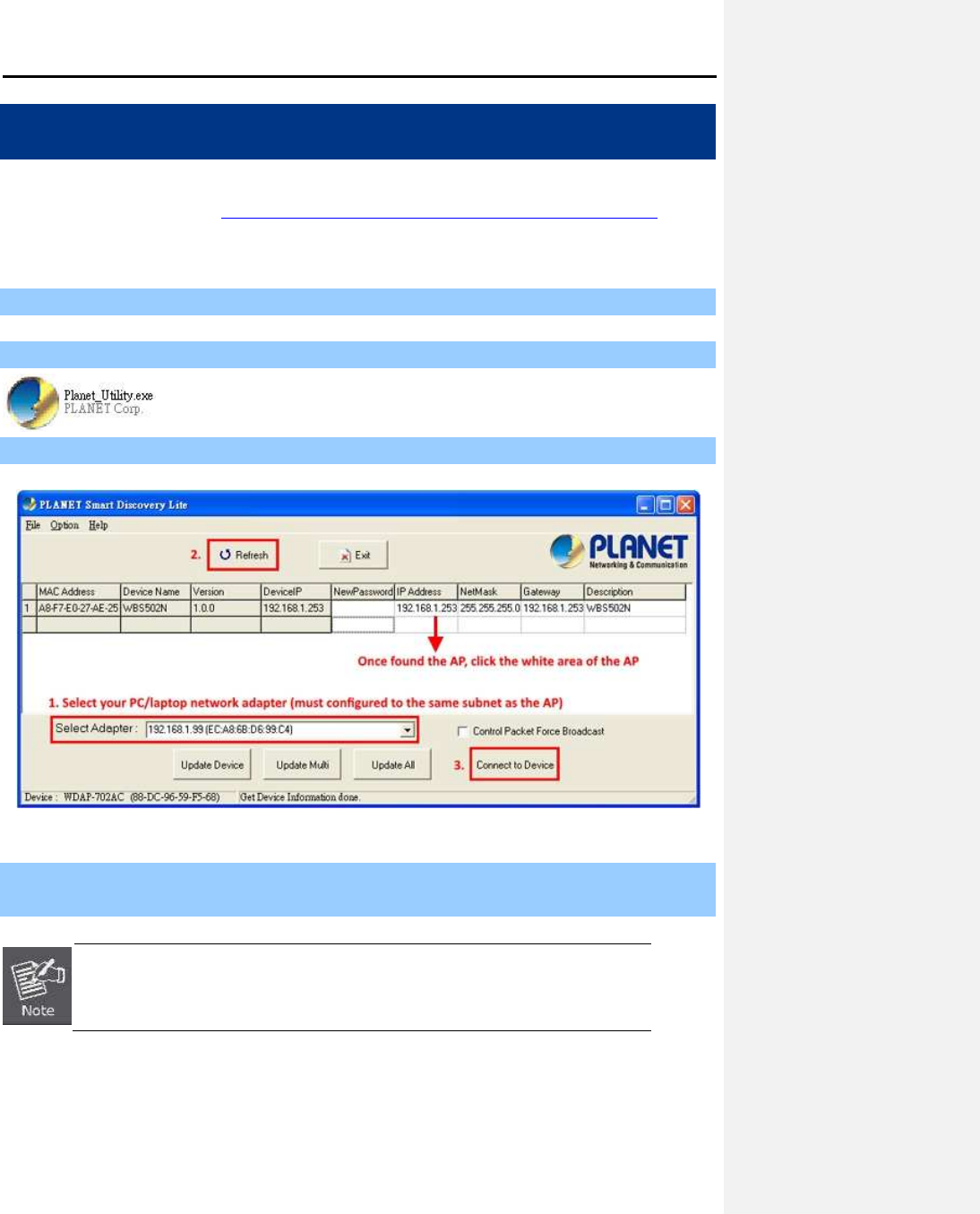
User Manual of WBS-502AC
-74-
Appendix B: Use Planet Smart Discovery to find AP
To easily discover the WBS-502AC in your Ethernet environment, the Planet Smart Discovery Utility is an ideal
solution. The utility is available at: http://www.planet.com.tw/en/product/images/48590/Planet_Utility.zip
The following instructions will guide you to how to use the Planet Smart Discovery Utility.
Step 1. Deposit the Planet Smart Discovery Utility in administrator PC.
Step 2. Execute this utility.
Step 3. Click the “Refresh” button as shown below to update the list of the currently connected devices.
Figure B-1 PLANET Smart Discovery
Step 4. Select the AP from the list and then click the “Connect to Device” button to link to the Web
Management Configuration Page.
The fields in white background can be modified directly, and then you can apply the new
setting by clicking the “Update Device” button.

User Manual of WBS-502AC
-75-
EC Declaration of Conformity
English Hereby, PLANET Technology Corporation,
declares that this 900Mbps 802.11ac Wireless
Outdoor CPE is in compliance with the essential
requirements and other relevant provisions of
Directive 1999/5/EC.
Lietuviškai Šiuo PLANET Technology Corporation,, skelbia,
kad 900Mbps 802.11ac Wireless Outdoor CPE
tenkina visus svarbiausius 1999/5/EC direktyvos
reikalavimus ir kitas svarbias nuostatas.
Česky Společnost PLANET Technology Corporation,
tímto prohlašuje, že tato 900Mbps 802.11ac
Wireless Outdoor CPE splňuje základní
požadavky a další příslušná ustanovení směrnice
1999/5/EC.
Magyar A gyártó PLANET Technology Corporation, kijelenti,
hogy ez a 900Mbps 802.11ac Wireless Outdoor
CPE megfelel az 1999/5/EK irányelv
alapkövetelményeinek és a kapcsolódó
rendelkezéseknek.
Dansk PLANET Technology Corporation, erklærer
herved, at følgende udstyr 900Mbps 802.11ac
Wireless Outdoor CPE overholder de væsentlige
krav og øvrige relevante krav i direktiv 1999/5/EF
Malti Hawnhekk, PLANET Technology Corporation,
jiddikjara li dan 900Mbps 802.11ac Wireless
Outdoor CPE jikkonforma mal-ħtiġijiet essenzjali u
ma provvedimenti oħrajn relevanti li hemm
fid-Dirrettiva 1999/5/EC
Deutsch Hiermit erklärt PLANET Technology Corporation,
dass sich dieses Gerät 900Mbps 802.11ac
Wireless Outdoor CPE in Übereinstimmung mit
den grundlegenden Anforderungen und den
anderen relevanten
Vorschriften der Richtlinie 1999/5/EG befindet".
(BMWi)
Nederlands Hierbij verklaart , PLANET Technology orporation,
dat 900Mbps 802.11ac Wireless Outdoor CPE in
overeenstemming is met de essentiële eisen en de
andere relevante bepalingen van richtlijn 1999/5/EG
Eestikeeles
Käesolevaga kinnitab PLANET Technology
Corporation, et see 900Mbps 802.11ac Wireless
Outdoor CPE vastab Euroopa Nõukogu direktiivi
1999/5/EC põhinõuetele ja muudele olulistele
tingimustele.
Polski Niniejszym firma PLANET Technology Corporation,
oświadcza, że 900Mbps 802.11ac Wireless Outdoor
CPE spełnia wszystkie istotne wymogi i klauzule
zawarte w dokumencie „Directive 1999/5/EC”.
Ελληνικά ΜΕ ΤΗΝ ΠΑΡΟΥΣΑ , PLANET Technology
Corporation, ∆ΗΛΩΝΕΙ ΟΤΙ ΑΥΤΟ 900Mbps
802.11ac Wireless Outdoor
CPEΣΥΜΜΟΡΦΩΝΕΤΑΙ ΠΡΟΣ ΤΙΣ ΟΥΣΙΩ∆ΕΙΣ
ΑΠΑΙΤΗΣΕΙΣ ΚΑΙ ΤΙΣ ΛΟΙΠΕΣ
ΣΧΕΤΙΚΕΣ ∆ΙΑΤΑΞΕΙΣ ΤΗΣ Ο∆ΗΓΙΑΣ 1999/5/ΕΚ
Português PLANET Technology Corporation, declara que este
900Mbps 802.11ac Wireless Outdoor CPE está
conforme com os requisitos essenciais e outras
disposições da Directiva 1999/5/CE.
Español Por medio de la presente, PLANET Technology
Corporation, declara que 900Mbps 802.11ac
Wireless Outdoor CPE cumple con los requisitos
esenciales y cualesquiera otras disposiciones
aplicables o exigibles de
la Directiva 1999/5/CE
Slovensky Výrobca PLANET Technology Corporation, týmto
deklaruje, že táto 900Mbps 802.11ac Wireless
Outdoor CPE je v súlade so základnými
požiadavkami a ďalšími relevantnými predpismi
smernice 1999/5/EC.
Français Par la présente, PLANET Technology
Corporation, déclare que les appareils du
900Mbps 802.11ac Wireless Outdoor CPE sont
conformes aux exigences essentielles et aux
autres dispositions pertinentes de la directive
1999/5/CE
Slovensko PLANET Technology Corporation, s tem potrjuje,
da je ta 900Mbps 802.11ac Wireless Outdoor CPE
skladen/a z osnovnimi zahtevami in ustreznimi določili
Direktive 1999/5/EC.
Italiano Con la presente , PLANET Technology
Corporation, dichiara che questo 900Mbps
802.11ac Wireless Outdoor CPE è conforme ai
requisiti essenziali ed alle altre disposizioni
pertinenti stabilite dalla direttiva
1999/5/CE.
Suomi PLANET Technology Corporation, vakuuttaa täten
että 900Mbps 802.11ac Wireless Outdoor CPE
tyyppinen laite on direktiivin 1999/5/EY oleellisten
vaatimusten ja sitä koskevien direktiivin muiden
ehtojen mukainen.
Latviski Ar šo PLANET Technology Corporation,
apliecina, ka šī 900Mbps 802.11ac Wireless
Outdoor CPE atbilst Direktīvas 1999/5/EK
pamatprasībām un citiem atbilstošiem
noteikumiem.
Svenska Härmed intygar, PLANET Technology Corporation,
att denna 900Mbps 802.11ac Wireless Outdoor
CPE står i överensstämmelse med de väsentliga
egenskapskrav och övriga relevanta bestämmelser
som framgår av direktiv 1999/5/EG.